Members’ Finds
Members Finds - 2025
Search via Masterlist Index of Latin names
Members' Finds - by month
How Members Finds started
Basic Instructions for Participating
Viewing Tips
Acknowledgements
Disclaimer
Rare sightings New to Buckinghamshire New to UK New to Science
Jan Feb Mar Apr May Jun Jul Aug
| Image | Details |
|---|
August 17th 2025

 |
August 13th Arthrocladiella mougeotii (an unusual mildew with no English name) Near Burnham Jesper Launder noticed and recognised an unusual plant, Lycium barbarum (Duke of Argyll's Tea Plant), which he says is normally coastal and very uncommon inland. Possibly more interesting still was the powdery mildew affecting it which not surprisingly is new to the county! Knowing the identity of the plant is all-important when identifying such species from 'Ellis & Ellis Microfungi on Land Plants' where the plant host index takes you straight to the possible fungi found on that plant. Jesper made a quick check of the microscopic characters which matched satisfactorily. Job done! Previous finds |

 |
August 13th Russula heterophylla (Greasy Green Brittlegill) In Penn Wood John and Lesley Catterson found this green singleton which they thought was this species in the field but took home to check. Everything matched nicely: a white spore print overnight, somewhat small spores for the genus under the scope, a strong dark blue positive reaction to a drop of Guaiac and an even stronger salmon pink reaction to a rub with a Ferrous Sulphate crystal (both seen on the stem in photo 2). (The crystal reaction is equally positive on the gills as well - a unique feature to both this species and R. vesca.) The English name refers to the slightly greasy and bendable gills which one can test but rubbing with a finger as well as to the cap colour. Previous finds |



 |
August 4th Panaeolus antillarum (a rare Mottlegill with no English name) At Salden Wood Bob Simpson put out some horse dung (collected from his wood) on the lawn in the hope of attracting Purple Emperor butterflies! Imagine his surprise when he noticed not the butterflies but some interesting fungi appearing on it! The genus was not difficult to work out once the mottled gills, dark spores and dung habitat were noted, but the species was quite another matter and didn't key out. However, the spores were notably large and when checking in Members Finds he then found that Jackie Ewan's Panaeolus on donkey dung at Stampwell Farm had large spores and fitted well, also though rare had been confirmed with sequencing. Further research supplied the information that the spores in P. antillarum have a 'flattened appearance' when lying sideways on though Bob was unsure how to judge this so took the spore print to our microscope workshop conveniently a week later. Derek was able confirm this feature and show him how to assess this. Note the cracked cap surface on his older rather dried out specimen, also the mottling on the gills for which the genus gets its English name. Previous finds |
 |
August 3rd Russula insignis (a rare Brittlegill with no English name) At Stoke Common in the thin deciduous strip alongside Common Road Jesper Launder found around 50 specimens of this somewhat unusual Russula under both Aspen and Oak, new to the site and with few previous county records. Though similar in appearance (and belonging) to the group affectionately known as 'the smellies' (like R. amoenolens and R. foetens, both common) it differs in having a veil which leaves remnants both on the cap and the stem base - a very unusual feature in this genus shared also with R. ochroleuca (perhaps the commonest of them all). The veil is not always visible to the naked eye (but seen well here in the two central smallest caps) and a drop of KOH on the stem base will turn the veil remnants instantly bright red. Jesper says to note that the stem bases develop yellow patches (also seen here). He recognised his find in the field but confirmed it at home with the KOH test which proved positive. Previous finds |
August 15th 2025

 |
August 14th Mucidula mucida (Porcelain Fungus) In Penn Wood John and Lesley Catterson found this early fruiting of a classic Chiltern mushroom on a piece of rotting wood - no doubt Beech (we also saw a singleton at Burnham Beeches a few days earlier). Noting the Beech substrate, the slimy cap surface and ring on the stem, this species should present no problems to identify even to beginners and is very common in this area, sometimes seen in large numbers on live as well as fallen trunks and branches but only on Beech - a beautiful and almost translucent species when seen from below with good light above. Previous finds |





 |
Aug 13, 2025. Ganoderma lucidum (Lacquered Bracket) A week ago Sarah Ebdon returned to a place near Gt. Missenden to check if the intriguing Ganoderma she'd found at the base of a Hornbeam three months earlier was still fruiting (see the previous entry under Ganoderma resinaceum dated May 6th 2025). She was delighted to find this striking display and today took Jesper Launder along to admire it and advise on ID. Though in May she'd leant towards G. resinaceum for reasons explained in that entry, both she and Jesper are now agreed that G. lucidum seems much more likely, this backed up by Attila Fodi (a recognised bracket expert) on seeing Sarah's photos. Sarah found no signs of melting bubbling resin on applying a flame to the upper surface (a feature of G. resinaceum but not G. lucidum), furthermore the distinct and striking stem (photo 4) and general 'jizz' and texture also point to G. lucidum, though she still has a nagging doubt and won't feel 100% sure till we have a sample sequenced. We do have 4 previous county records though none confirmed with sequencing. The last two photos were taken by Penny the next day and show the surface with a thick coating of cocoa-coloured spores thus hiding the shiny lacquered effect, only revealed when she cleared a patch with a finger, also the tell-tale sign of the genus when the fine pale pores underneath are scratched leaving a permanent cocoa brown mark. Penny collected some spores which when checked matched closely to those for G. lucidum rather than G. resinaceum so is confident to go with this name but we will go ahead with getting a sample sequenced to confirm. New find |
August 13th 2025
 |
August 13th Meripilus giganteus (Giant Polypore) In Tinkers Wood John Catterson found this freshly sprouting fungus at the base of a bole of a dead tree, probably Beech which this fungus favours though not exclusively. When still small (as in photos 2 and 3) it is less easy to separate from other species on a quick glance, but break a piece off and hang on to it for, say, 30 minutes, when it will have started to stain black where damaged. When large it is surely unmistakable! Previous finds |

 |
August 10th Erysiphe alphitoides (Oak Mildew) At Burnham Beeches during our microscope workshop Penny struggled to find any fungi worth collecting but saw this nice patch of a very common mildew on a young Oak sapling. (Note in the sunlit background (photo 1) the top of a Wood Ant's nest - a sure sign you're in Burnham Beeches where such nests are huge, commonplace and very active at the moment!) Previous finds |

 |
August 10th Xanthoporia radiata (Alder Bracket) At Burnham Beeches during our microscope workshop Justin Long noticed this tier of brackets developing in the heartwood of a damaged Beech trunk. Sadly we didn't retain the specimen to examine microscopically but were agreed on the species from its general habit and appearance. Better known as Inonotus radiatus it has now moved via genus Mensularia to its present abode. There has to be a little doubt about this ID because Penny later discovered online that though (despite its English name) it can occur on Beech, there is a further very similar but much rarer species, Mensularia nodulosa, which is apparently host specific to Beech and which is reported from both Herts and Bucks, so is a possibility at this site. We plan to return for a further sample to have sequenced. The photos are Justin's. Previous finds |
 |
August 10th Stemonitis axifera (a slime mould with no English name) At Burnham Beeches during our microscope workshop Jordan Payne found this nice example on fallen unidentified wood, the specimen was then identified by Barry Webb and Jackie Mackenzie-Dodds. Not as common as S. fusca, this species is a paler brown with a reddish tinge, also the spores are notably different. We have only a few county records. The photo is Barry's. Previous finds |
 |
August 10th Stemonitopsis typhina (a slime mould with no English name) At Burnham Beeches during our microscope workshop Barry Webb found this very common species on fallen unidentified wood. This is quite a mature specimen but we have plenty of other images showing it at different stages of development. Previous finds |


 |
August 8th Rigidoporus ulmarius (Giant Elm Bracket) In a garden in Bledlow Sarah Ebdon saw this bracket, about 20 cm across, at the base of a Horse Chestnut tree and at first glance thought it might be a Ganoderma from its shape and bumpiness but on closer inspection realised it was different and unfamiliar to her. The texture was firm, yes, but rubbery rather than woody like Ganoderma, also the pores had a peachy tint and the line left by a scratch was not the typical chocolate brown of that genus. This suggested that the spores were not cocoa-coloured (they are in fact whitish in this bracket) and breaking a piece off revealed distinctly orange layers in the tubes (immediately under the outer pore surface). Research at home brought her to the Rigidoporus, this confirmed for her by Claudi Soler a day or so later, an uncommon bracket seen frequently on dying Elm stumps during the Dutch Elm disease era then decreasing with the demise of that tree though also found on various other deciduous trees and perhaps now most frequent on Horse Chestnut. It can grow to enormous proportions - up to a meter across! - when often coated in green algi, its size then making it unmistakeable but when smaller as here it can be confused with other similar shaped species. Previous finds |
 |
August 8th Phellinus pomaceus (Cushion Bracket) In a garden in Bledlow Sarah Ebdon spotted this tier of brackets on the trunk of an ornamental Cherry. This is a species which favours Prunus, particularly Blackthorn on which we regularly record it at Rushbeds Wood. Records on other hosts within the county are few and far between: Stampwell Farm on Plum and Salden Wood on Hawthorn. It appears to go for dying wood and Sarah's photo shows it no doubt having entered the trunk via the wound just above. The familiar Blackthorn at Rushbeds Wood much photographed over the years has now died. Previous finds |



 |
August 4th Suillellus queletii (Deceiving Bolete) In a grass field edge under Birch and Oak at Stampwell Farm Jackie Ewan was astounded to come across no less than 50 substantial brown caps! The larger caps were up to 15 cm across and she knew instantly what they were likely to be, having found them in this exact spot for several years now though previously the most at any one time had been a mere 11! She was spoilt for choice with the camera, and turning one over revealed the unusually coloured pores, instant strongly blueing flesh when exposed to air and - crucial for this particular species - the beetroot staining at the tapering and rooting stem base. Though considered a rarity here in the past, this species appears to be becoming much more common in our area in recent years. Previous finds |


 |
August 4th Parasola leiocephala (Bald Inkcap) At Stampwell Farm this delightful and delicate Inkcap was spotted in a weedy patch under Hawthorn. This is one of several lookalikes which can only be securely named when a comparison of their spores is made (though in past decades many collections would probably have been named in the field as Parasola (then Coprinus) plicatilis. Today's species has distinctly heart-shaped spores and is at least as common as C. plicatilis, if not more so. Previous finds |

 |
August 4th Coprinopsis pseudonivea (Aromatic Inkcap) At Stampwell Farm Jackie Ewan spotted several Inkcaps with thick veil on donkey dung, noticing one was pure white but other (seen here) haxd an off-white peachy tint. At home she noted the spores of the these specimens were smaller than those of the white cap, confirming for her that she had two very similar dung species here - both C. nivea and pseudonivea. She recalled having found both species in close proximity on the nearby dung heap a few years ago. It is useful to be able to compare both in close proximity like this; photo 2 shows two specimens of C. pseudonivea on the left with a single specimens of C. nivea on the right. (Penny has no information about the presumed aroma of this species!) Previous finds |


|
August 4th Coprinopsis nivea (Snowy Inkcap) At Stampwell Farm Jackie Ewan spotted several Inkcaps with thick veil on donkey dung, noticing one was pure white (seen here) but others had an off-white peachy tint. At home she noted the spores of the white specimen were larger than those of the off-white caps, confirming for her that she had two very similar dung species here - both C. nivea and pseudonivea. She recalled having found both species in close proximity on the nearby dung heap a few years ago. It is useful to be able to compare both species in close proximity like this; photo 2 shows the single specimen of C. nivea on the right with two specimens of C. pseudonivea on the left. Previous finds |

 |
August 3rd Amaurochaete atra (a slime mould with no English name) On fallen Pine at Burnham Beeches Barry Webb found this unusual slime mould - one which appears to be new both to the site and the county though described as quite common. Barry explains that it starts out looking very similar to Enteridium lycoperdon (Moon Poo for some) - ie a pale quite large (for a slime mould) blob often on standing but dying trunks - but soon rapidly changes colour through pink to brown to black, then disrupts forming a reticulation of fine lines, the surface flaking off to reveal the spore mass beneath. Barry's two photos show both stages of development. The species apparently favours recently felled Pine. New find |
 |
August 3rd Symphytocarpus flaccidus (a slime mould with no English name) On fallen Pine at Burnham Beeches Barry Webb found this unusual slime mould - one which appears to be new both to the site and the county though described as quite common. The genus is related to Stemonitis and in fact looks rather like a squashed not fully developed form of that genus though is proven to be not part of that genus as was originally thought but distinctly different. New find |
 |
August 3rd Enerthenema papillatum (a slime mould with no English name) On fallen Pine at Burnham Beeches Barry Webb found this tiny but delicately beautiful species. Each fruiting body is only 1.5mm tall and is in fact easily distinguishable from other similar stalked brown slime moulds by its central 'apical disc' seen clearly here. This appears to be new to the site and we have just six previous county records: three from the previous century recorded by expert Bruce Ing, then none till Barry started finding and identifying it in 2020. Like very many slime moulds it is probably common but under-recorded due to its size and lack of the necessary skills and specialised knowledge to find it. Previous finds |
August 9th 2025
 |
August 7th Scleroderma bovista (Potato Earthball) In Penn Wood John and Lesley Catterson found this species fruiting in the middle of a path and suitably living up to its English name. The purplish tinge visible in the cut specimen (photo 2) is typical though both S. verrucosum and S. areolatum can turn pinkish when the lower surface is scratched. All three species are common though we have only a couple of previous entries for today's but this could possibly be down to mistaking it for one of the others in the field. The definitive difference is in the spore ornamentation .............. Previous finds |

 |
August 7th Pluteus cervinus (Deer Shield) In Penn Wood John and Lesley Catterson found these two specimens on fallen deciduous wood. This is one of our commonest brown-capped mushrooms though nothing has been very common recently. Species dependent on fallen wood tend to fare better than those growing in soil when conditions are dry and warm, so it's probably no surprise that it should be fruiting now. Previous finds |
August 7th 2025
 |
August 5th Hydropus inopinatus (a rare species new to the UK from this site) Near a stream in Burnham Beeches only feet away from where Barry Webb first discovered this species, he was pleased to find it fruiting again on a very rotten old Pine stump. This site appears to be the stronghold for this tiny insignificant-looking mushroom which has yet to be reported occurring elsewhere other than the collections mentioned in our original official description in 2024 in the magazine Field Mycology. We found it here last year also on our autumn walk (see my report for more images) so it hasn't missed a year since its first discovery. Previous finds |

 |
August 5th Suillus grevillei (Larch Bolete) In Tinkers Wood whilst under Larch John Catterson found this attractive and striking specimen showing its characteristics nicely. The species is host specific to Larch and a typical Suillus having a sticky cap and small pores but is one of just a few species having a ring on the stem. It is common wherever the host tree occurs, often an early fruiter, and can sometimes be found with a confusingly darker brown cap. Previous finds |
August 5th 2025
 |
August 2nd Lepiota cristata (Stinking Dapperling) In Naphill Common John and Lesley Catterson spotted this small white but distinctive mushroom in at the edge of a path. Typical of this genus it has white free gills with a scaly cap surface, also many have a brown centre as here. However, once you get to know the unpleasant sharp smell of this species it is an easy one to recognise (though several others have it also but to a much lesser extent). Though normally common we hardly saw it last year (2024) with just two records made on our walks - extraordinary. Previous finds |

 |
August 2nd Trametes gibbosa (Lumpy Bracket) In Tinkers Wood John Catterson found this fresh bracket on a deciduous stump and recognised the species. It is far the largest and most substantial member of this genus and certainly lives up to it English name; it is often coated with some green algae on the upper surface but this collection was clearly too fresh for that to have developed. Photo 2 shows the underside which in this species is unusual for the genus and almost maze-like rather than clearly with pores. The only other bracket with a similar structure to this is Lenzites betulina but that species is less substantial and has an almost gill-like underside rather than maze-like. Previous finds |
August 3rd 2025

 |
August 1st Russula parazurea (Powdery Brittlegill) At Turville Heath Penny spotted this blue-green cap in a grassy path near a mix of deciduous trees, and the colour instantly looked right to her for this species. The rather dull 'pruinose' surface together with a mix of shades including some brown (seen here at the centre though sometimes much more dominant and sometimes completely absent) was typical, as were the cream gills and white stem when she turned it over. At home the negative Guaiac reaction on the stem together with spores having low warts and an almost complete reticulum (mesh of tiny black lines) confirmed her field ID. This is a common species though probably goes unrecognised by many and is frequently but not exclusively found under Oak Previous finds |

 |
August 1st Xerocomellus porosporus (Sepia Bolete) In Naphill Common John and Lesley Catterson spotted this bolete at the pathside. Though rather eaten it was displaying all the characters John needed to be able to name it to species: the soft yellow pores which slightly blued when pressed, the strongly cracking cap cuticle with cream yellow flesh beneath, and most notably the yellow stem apex but below this dirty sepia, particularly towards the base. For definitive confirmation one should check the spores which are unique amongst boletes being truncate at one end, ie as if snipped off with scissors. As luck would have it Penny collected the same species (photo 2) the next day under Lime at Turville Heath and was able to check the spores, though she was happy also that John's collection was correctly identified. The species is most commonly but not exclusively found under Oak. Previous finds |

 |
August 1st Russula sororia (Sepia Brittlegill) Under Lime at Turville Heath Penny spotted two darkish brown Brittlegills just emerging through the litter. They were slimy and also pretty unpleasant-smelling which fitted well with a member of the group known as 'the smellies' but would need testing with the odd chemical at home to determine which species they were. A drop of Guaiac (a resin) on the stem is a useful way to split two lookalikes from this group: instant dark blue in the common R. amoenolens (Camembert Brittlegill) but hardly any colour change in the much less common R. sororia. Penny had her answer when the Guaiac test proved negative. Both are most often found under Oak but today there was no Oak nearby, just the Limes in the avenue here. Previous finds |
August 1st 2025
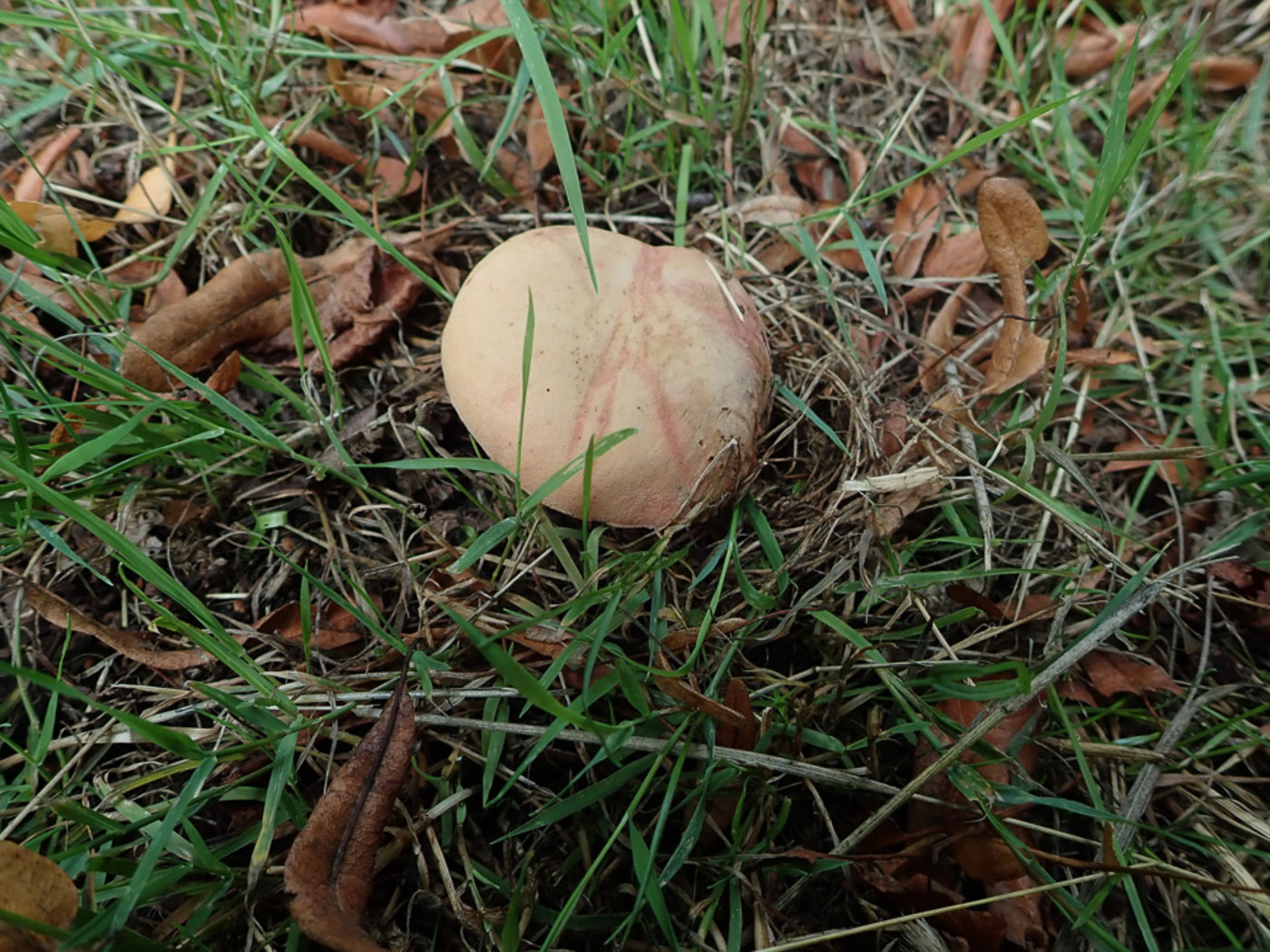
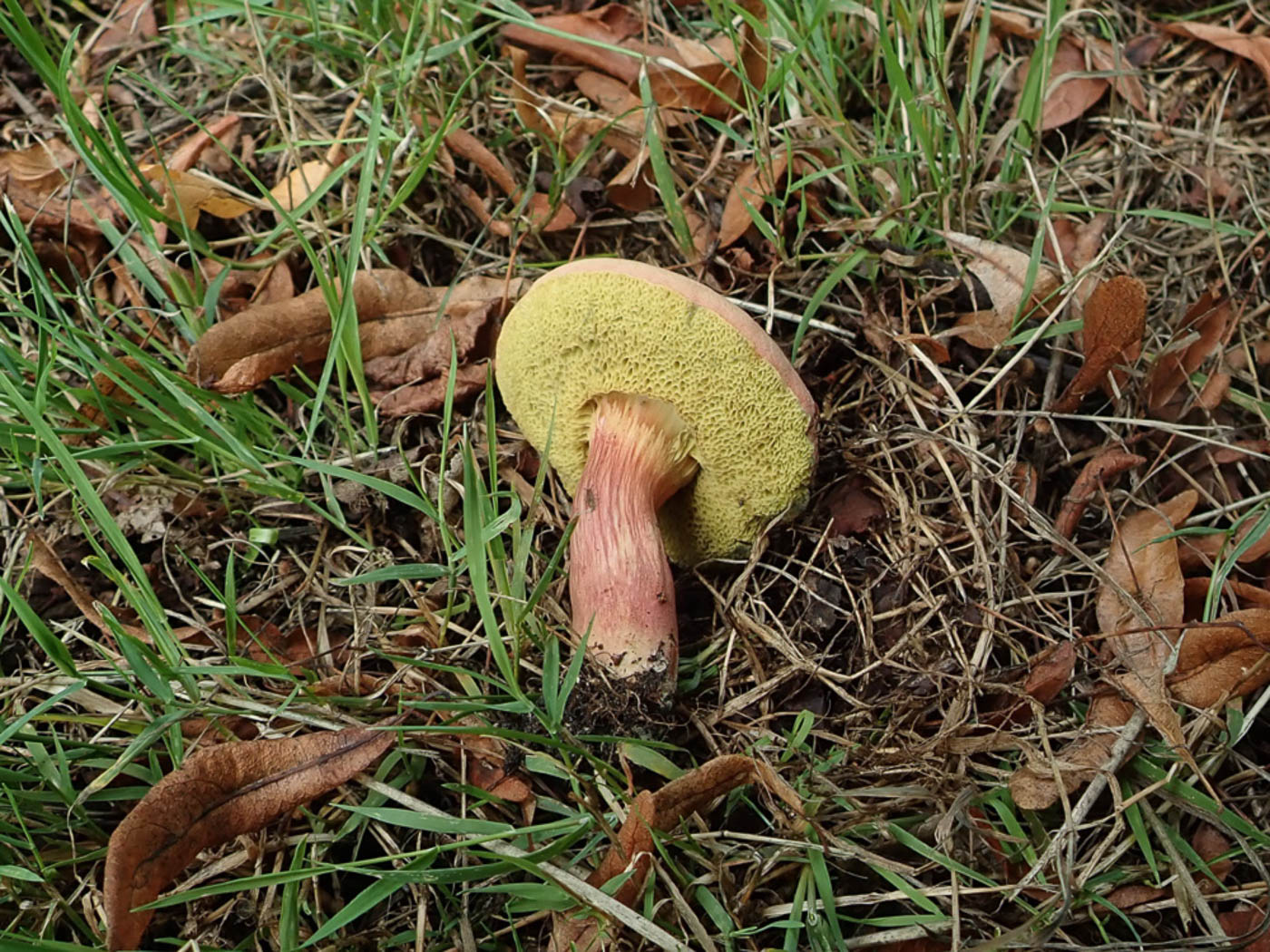 |
August 1st Hortiboletus engelii (Orangefoot Bolete) In a grassy roadside verge under Lime at Turville Heath Penny came across this unusual coloured cap, and took her photo in situ before turning it over to discover whether it had gills or pores. The distinctive pores of a Bolete were, however, not a surprise though this is her first Bolete of the season. She noted the pores blued only fairly slowly and this together with other clues checked later at home decided her on this ID. Images of both H. engelii and H. bubalinus show both can have this pinky peach buff matt appearance together with reddish stem (reminiscent of H. rubellus also). However, cutting open the whole fruitbody lengthwise revealed the telltale carrot-red dots at the stem base and the lack of any blue tints in the cap flesh which eliminated H. bubalinus. Previous finds |
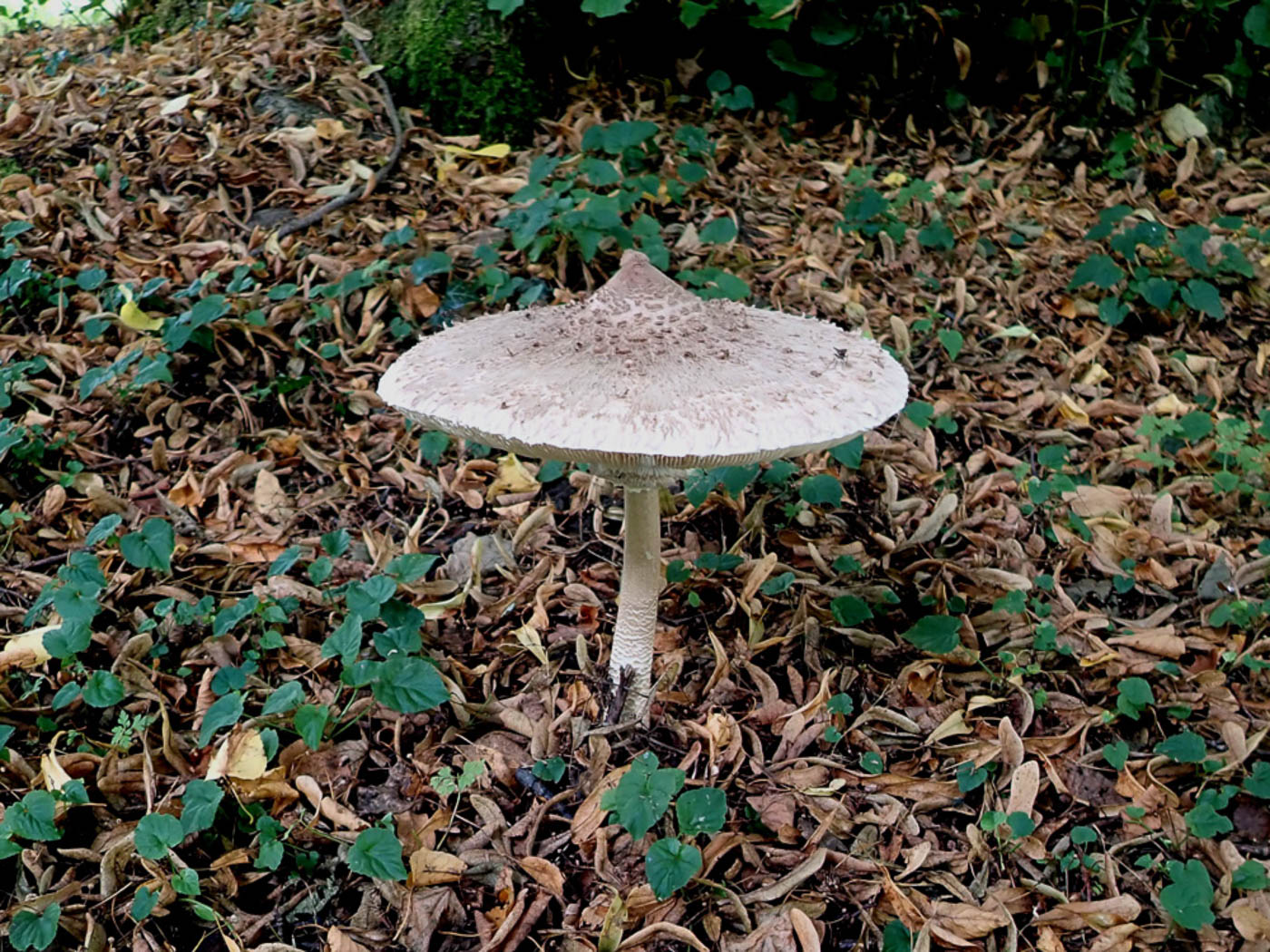
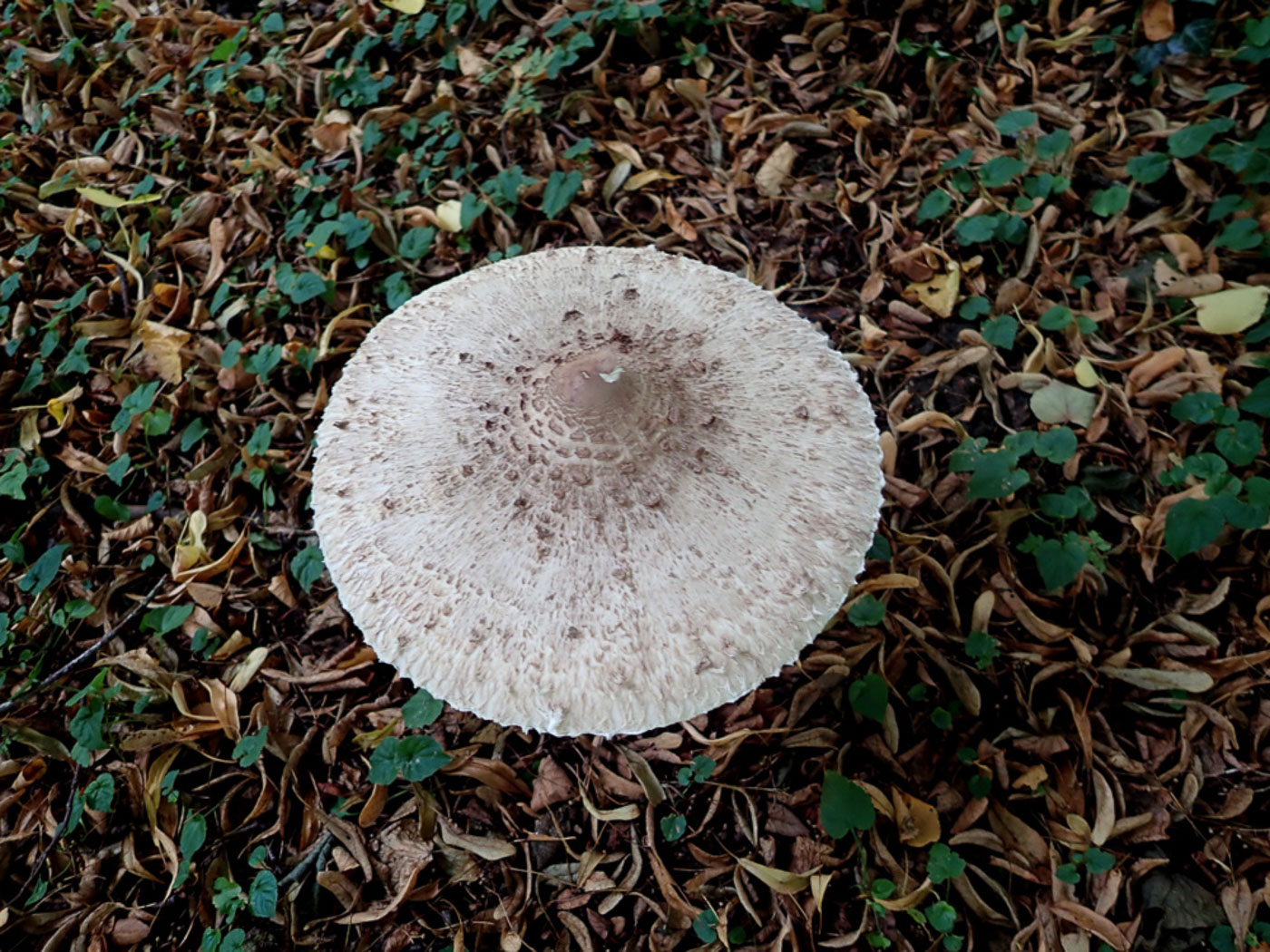 |
August 1st Macrolepiota mastoidea (Slender Parasol) At Turville Heath this was the first fungus Penny discovered under the Limes. Noting the snakeskin stem markings but lack of distinctive cap scales she eliminated both Chlorophyllum rhacodes (with white stem) and Macrolepiota procera (with similar stem but distinctly scalier cap), ending up with what she prefers to name M. konradii. However that name has been synonymised with M. mastoidea so for now she unhappily has to accept that synonymy! Previous finds |
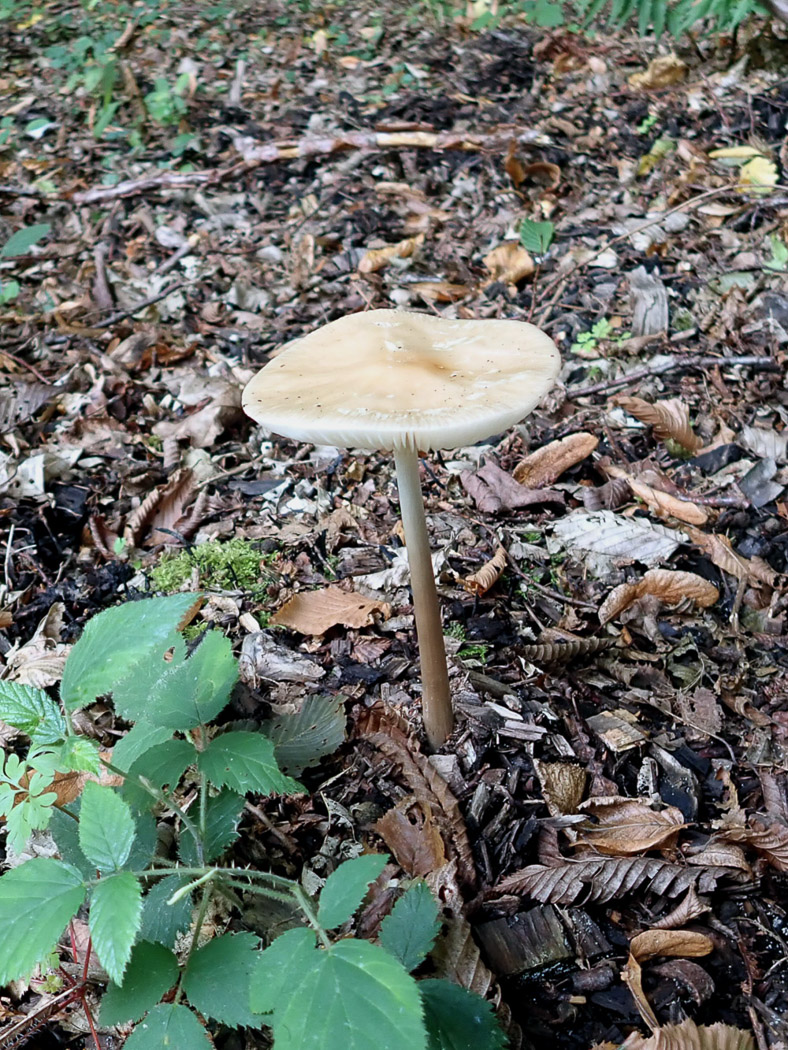
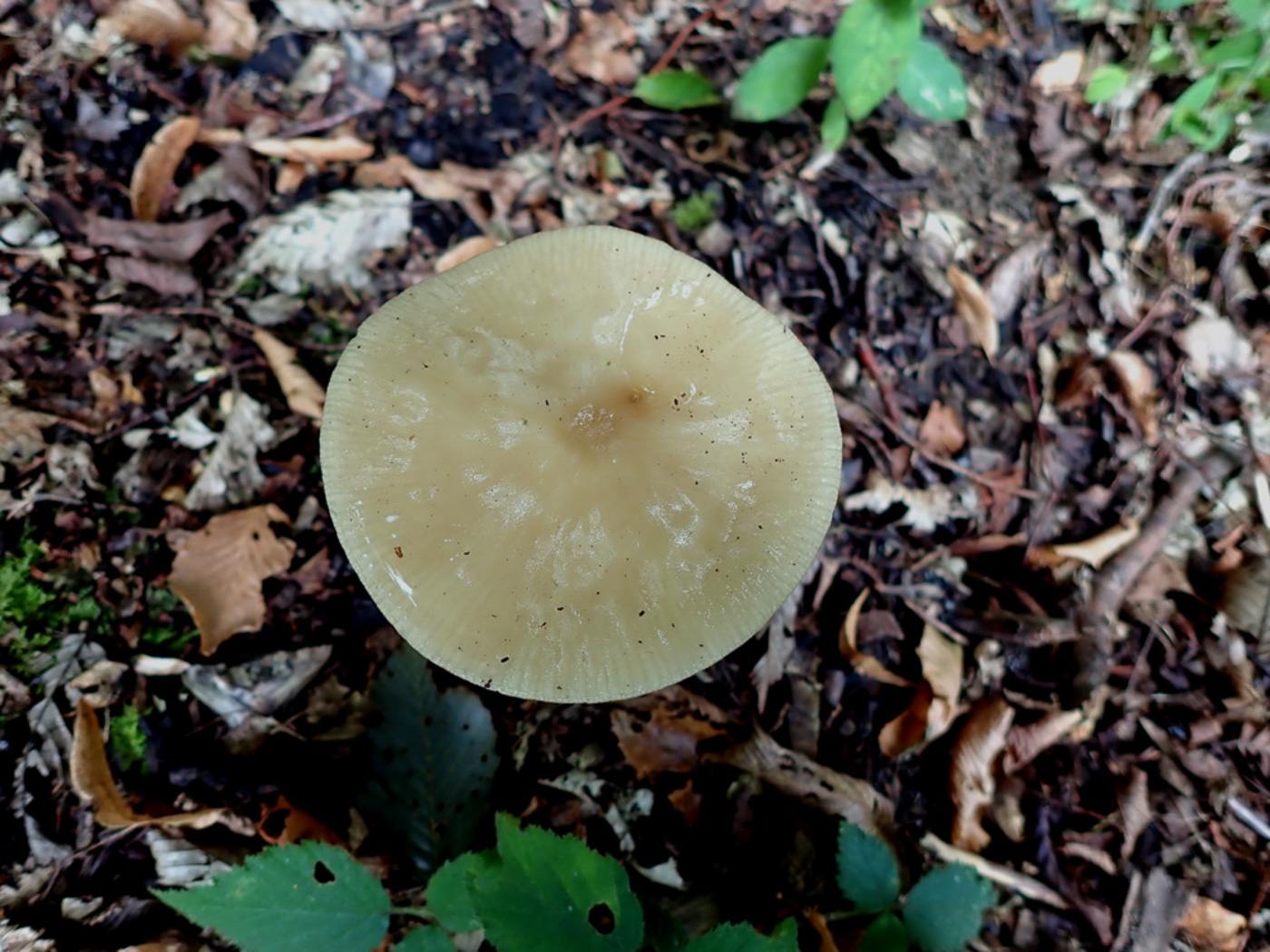
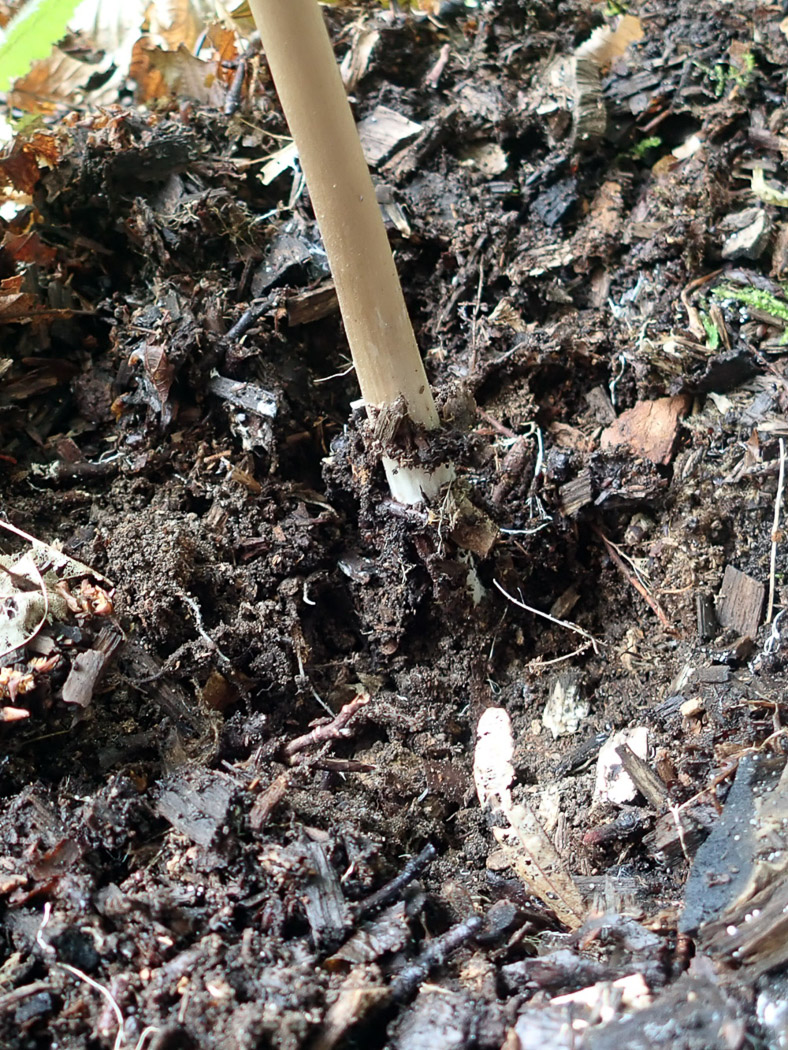 |
August 1st Hymenopellis radicata (Rooting Toughshank) At Turville Heath under the Limes Penny was pleased to see quite a few mushrooms fruiting - a sight for saw eyes - including this smart example of quite a common woodland mushroom which often seems to confuse with its dull brown cap and white gills, one of several common species sharing those characters. After rain this species has a shiny coating of slime and develops a rather uneven slightly ridged surface (photo 2), but the give-away character is its 'taproot' which can extend for several inches down to the host piece of wood or root. Not wanting to disturb the specimen Penny dug down around the stem base revealing enough of the single thick continuation of stem descending well below the soil surface, took her photo 3, then returned the soil to support it. Previous finds |
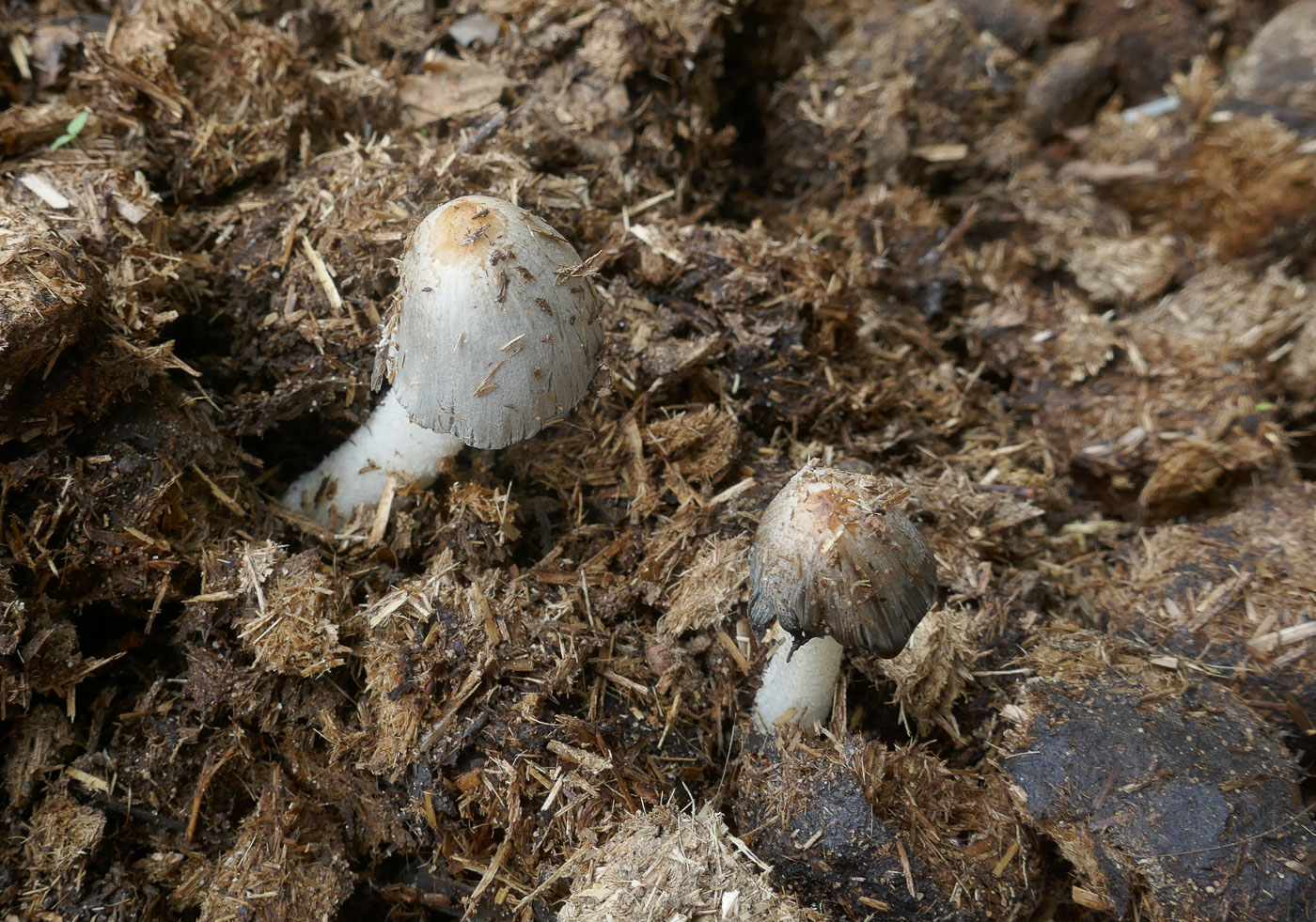
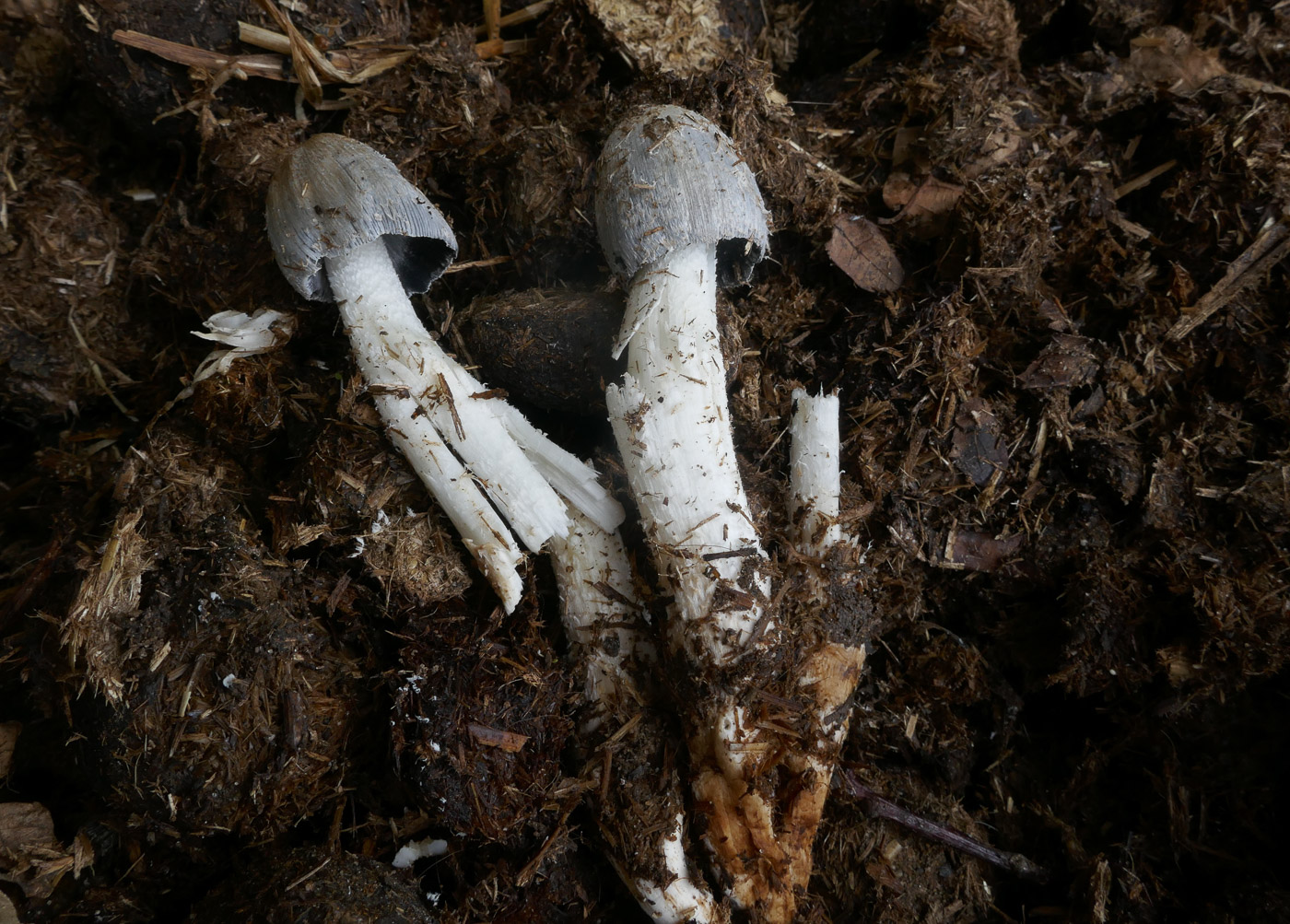 |
July 28th Coprinopsis macrocephala (Bighead Inkcap) Yet again the dung heap at Stampwell Farm is turning up interesting Inkcaps, this time both Coprinopsis cinerea and C. macrocephala (seen here and new to the county) growing near together. This is a good example of the need to take care and not assume that all adjacent mushroom specimens are necessarily the same species though they may be from the same genus - in fact something that happens quite often. It's all too easy to make 'mixed collections' if subtle differences are not noted and microscopic details not checked. The finder here, Jackie Ewan, had in fact found this species here two years earlier, noting their unusual large ellipsoid to mitriform-shaped spores with central germ pore together with the distinct cap veil remnants. It is probably not uncommon given a good supply of straw or hay dung but is an under-recorded species and appears to be new to the county. New find |
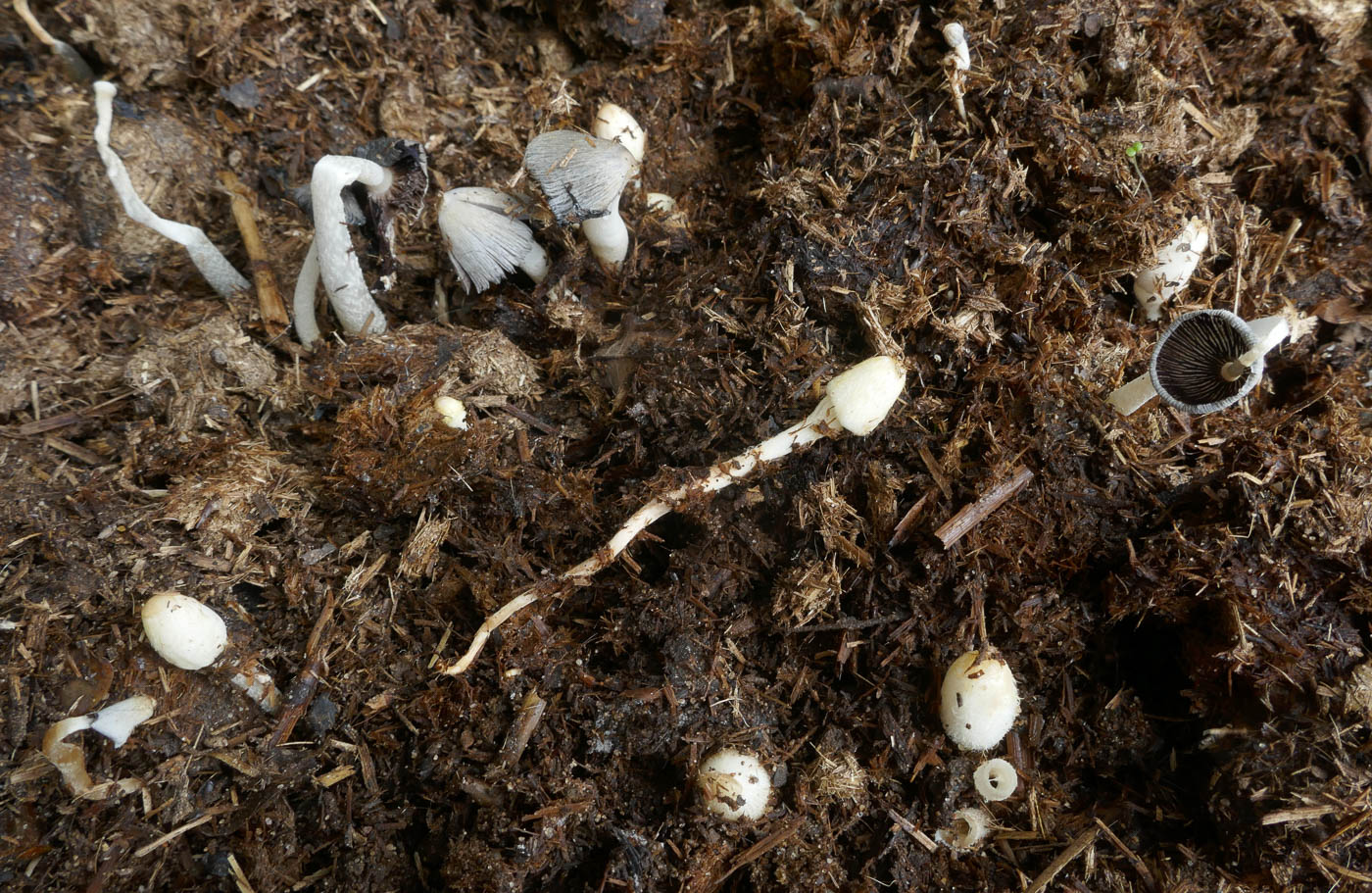
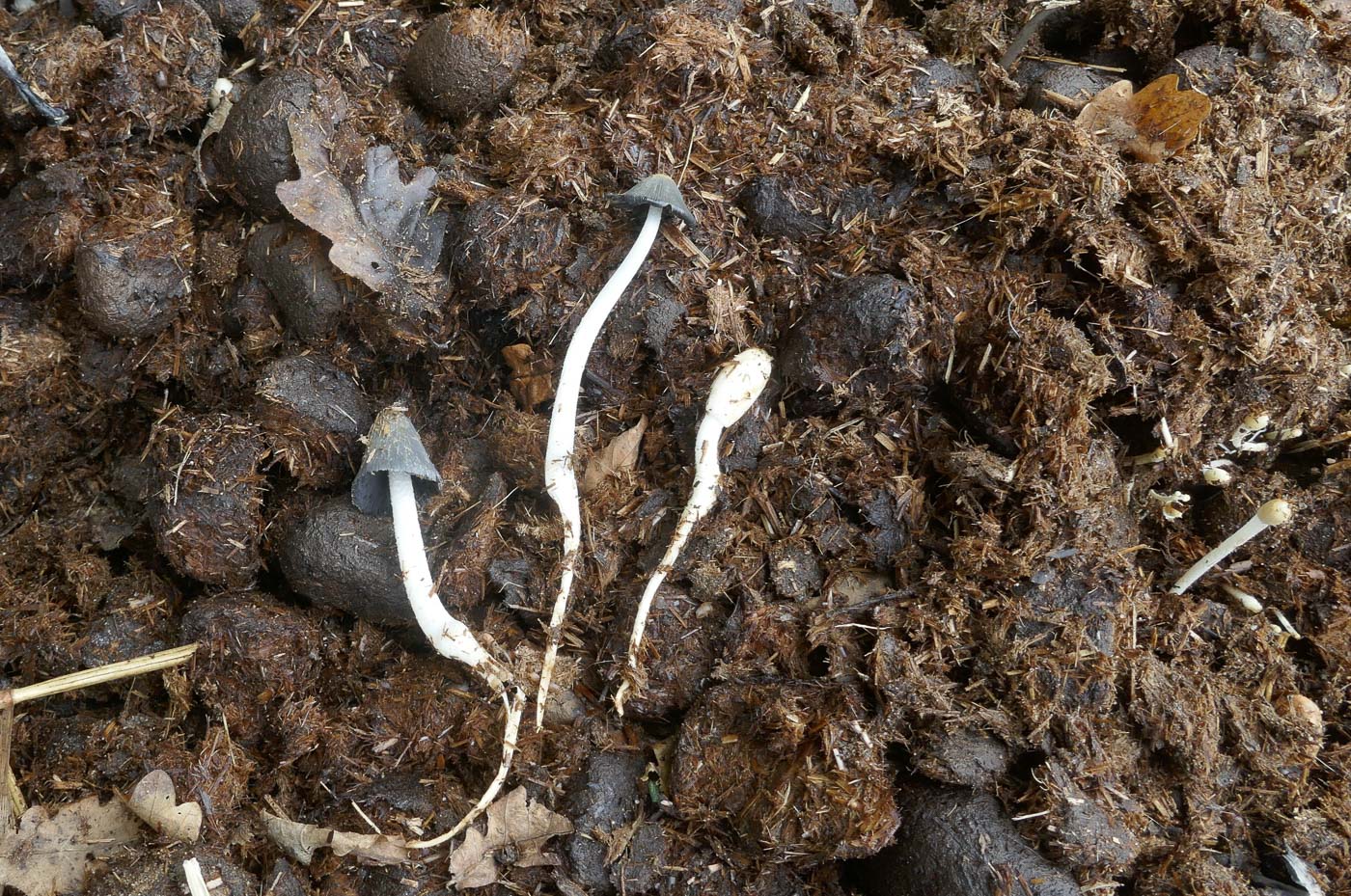 |
July 28th Coprinopsis cinerea (Grey Inkcap) Yet again the dung heap at Stampwell Farm is turning up interesting Inkcaps, this time both Coprinopsis macrocephala (new to the county) and C. cinerea (seen here) growing near together. This is a good example of the need to take care and not assume that all adjacent mushroom specimens are necessarily the same species though they may be from the same genus - in fact something that happens quite often. It's all too easy to make 'mixed collections' if subtle differences are not noted and microscopic details not checked. The finder here, Jackie Ewan, commented on their long stems rooting deep into the warm dung and typical of this particular species. We have few county records though it probably goes unrecognised given the correct dung heap habitat. Previous finds |
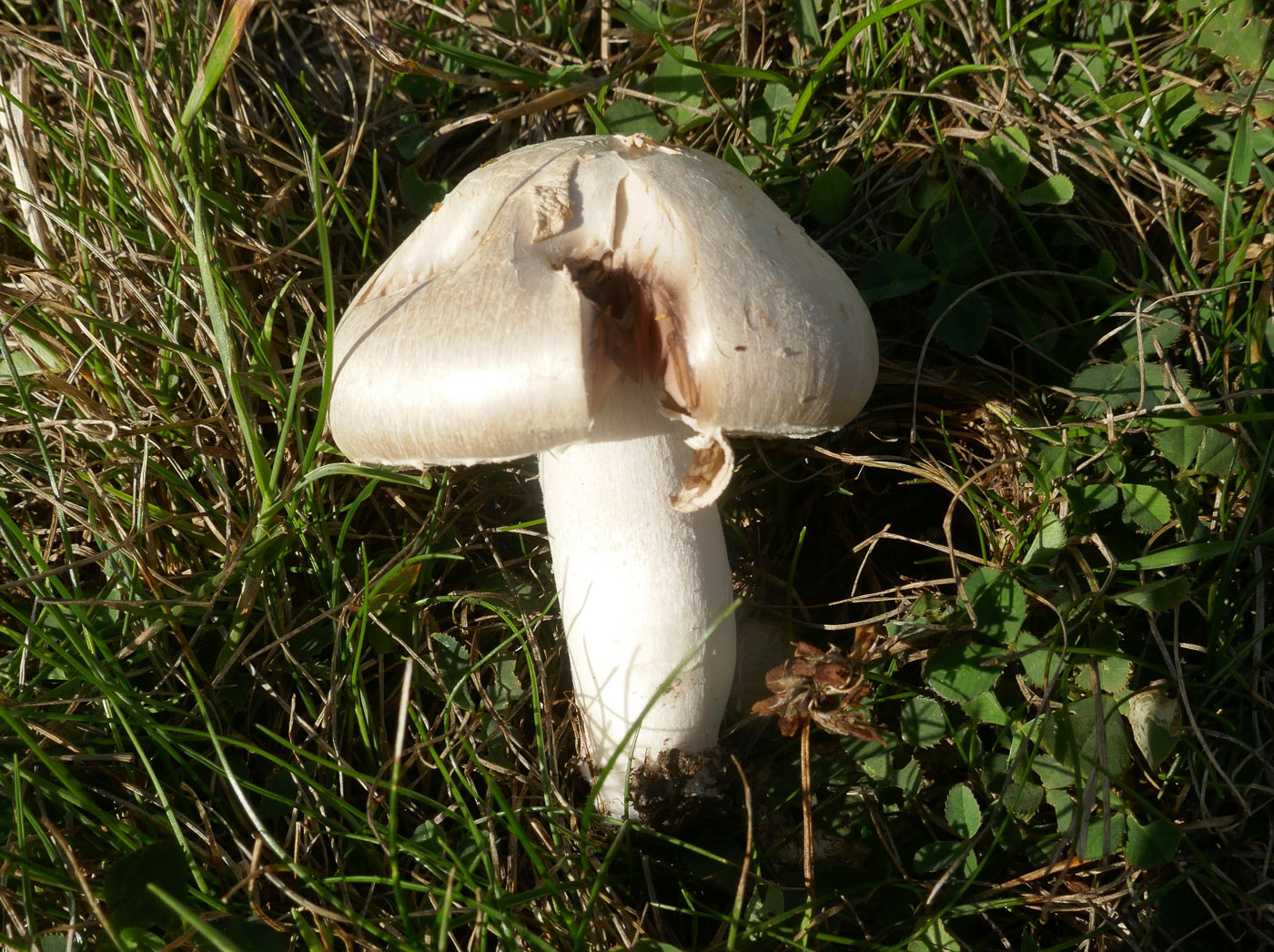
 |
July 28th Agaricus campestris (Field Mushroom) Jackie Ewan noticed this mushroom just making an appearance at Stampwell Farm in response to the recent and welcome rain.Though a well known species and a favourite for the pot it seems to have become much less common in recent years and we have only a couple of previous entries which is surprising. July to September is the probably likeliest time to find it in any shortish grass, but beware of confusion with A. xanthoderma (Yellow Stainer), always checking by scratching the stem base for the telltale instant brass yellow staining of that species. Previous finds |
July 29th 2025
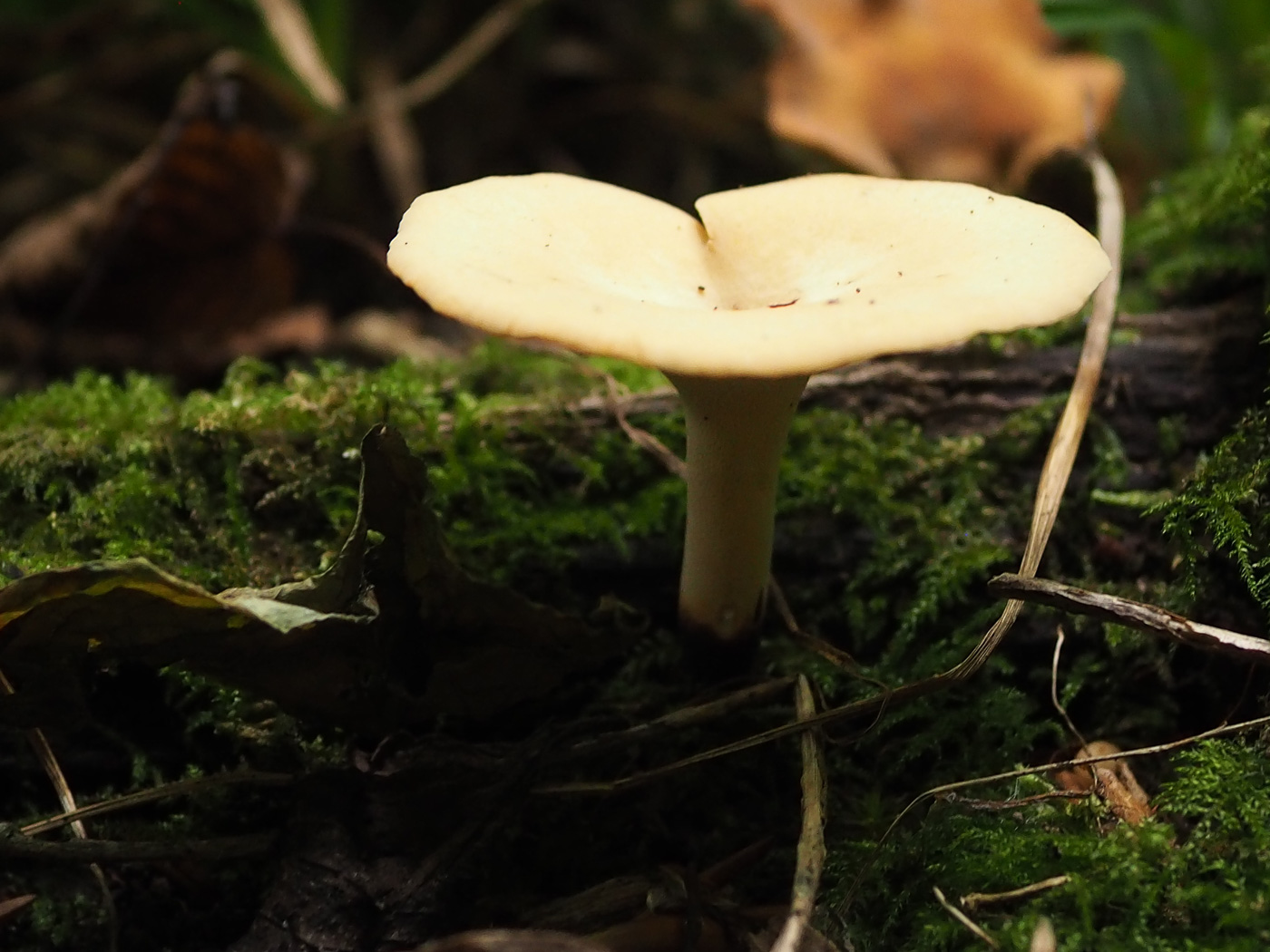
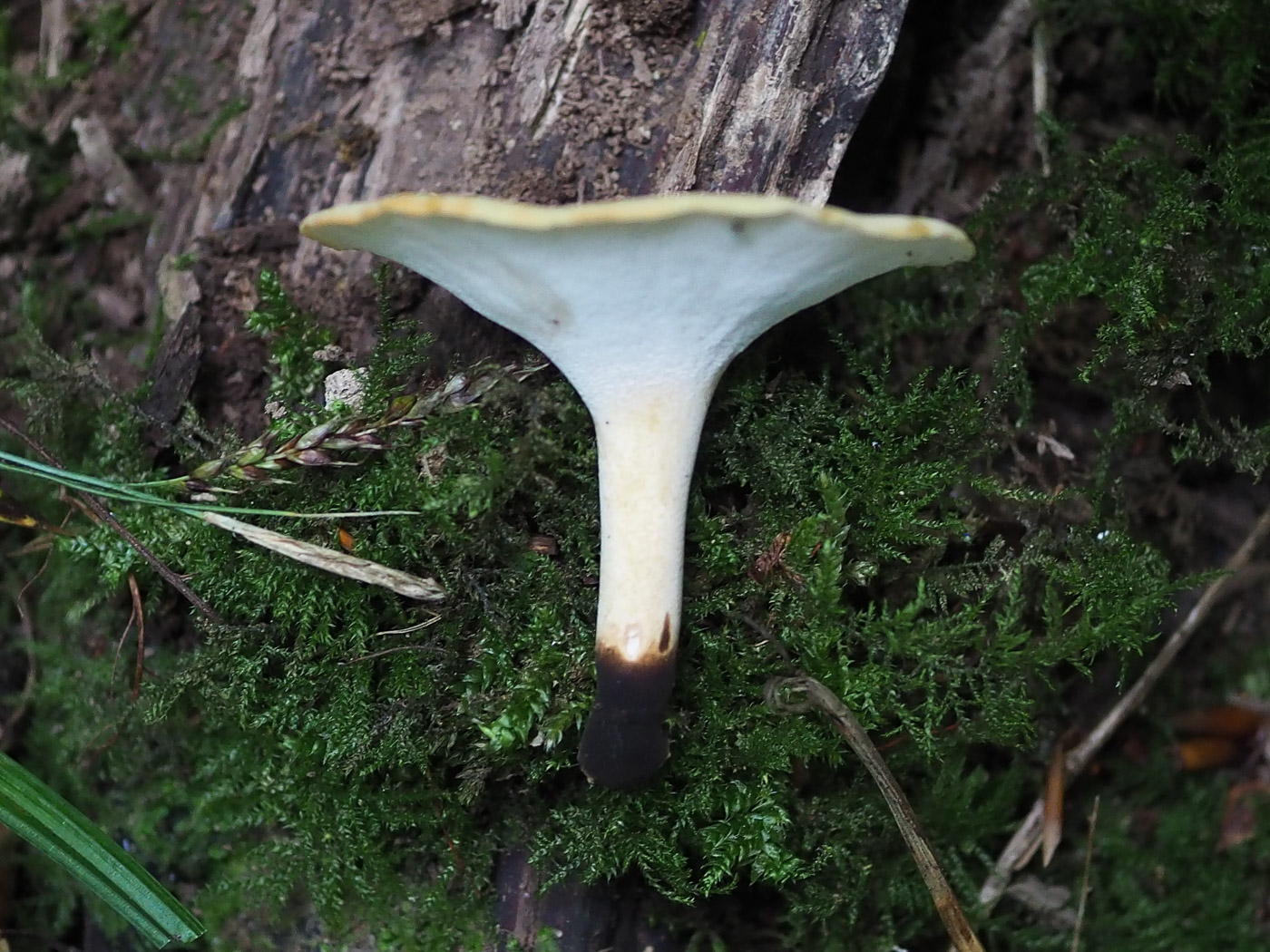
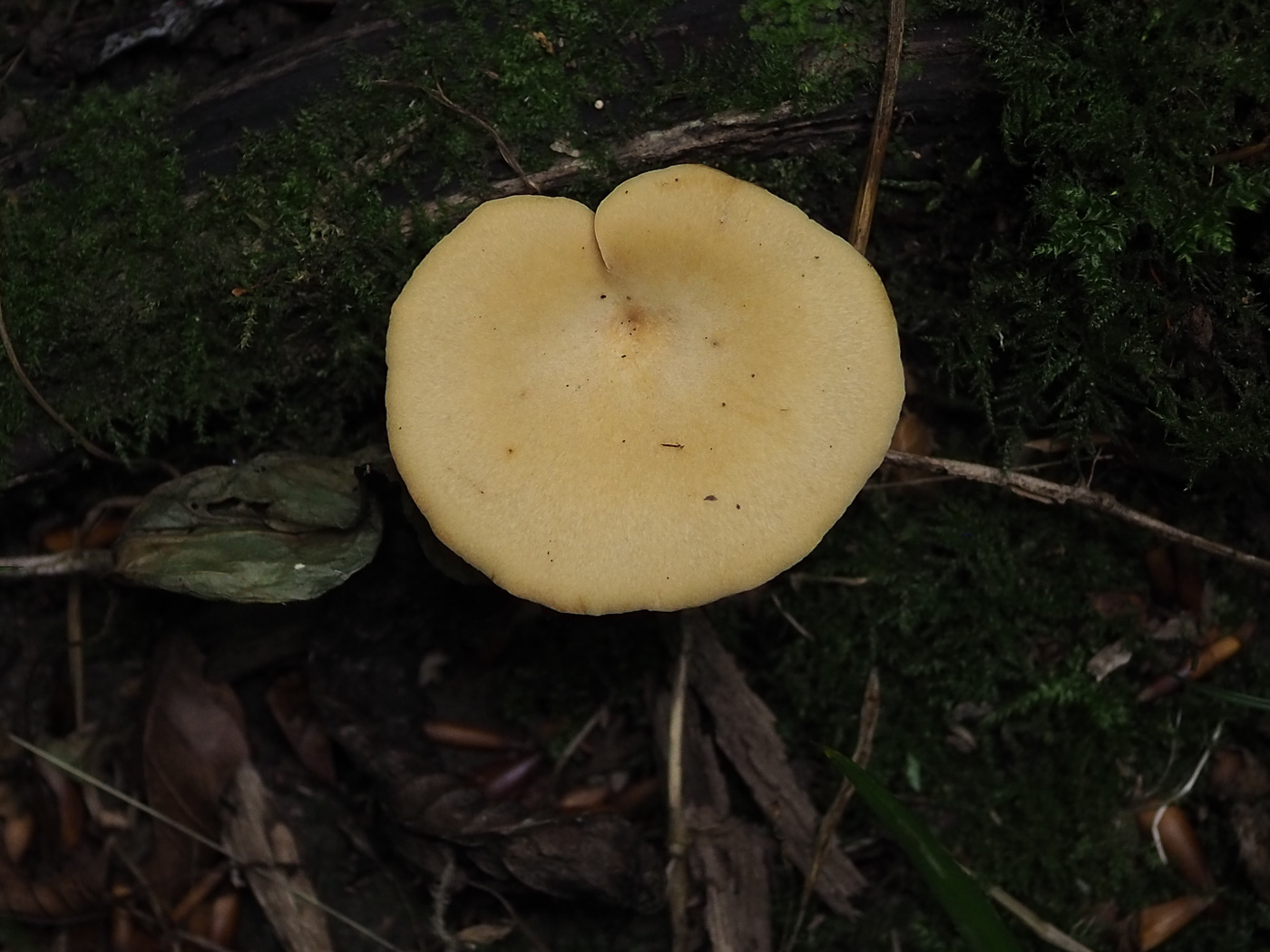
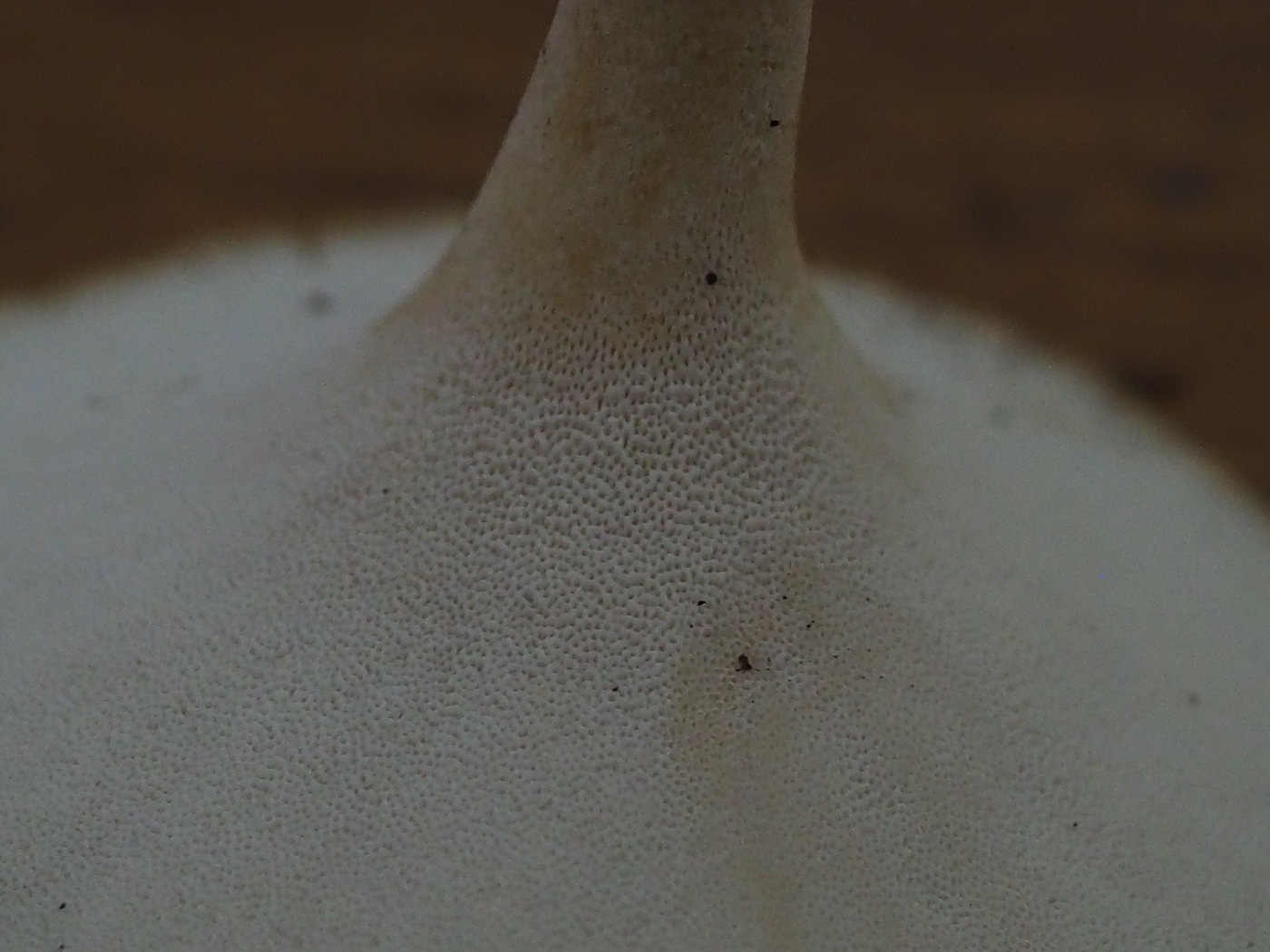 |
July 27th Cerioporus leptocephalus (Blackfoot Polypore) On a small rotten piece of wood under Beech in Tinker's Wood John Catterson found this Polypore in nice condition. He was able to name it from its general appearance - notably the typical and give-away black stem base to which its English name refers, but also the cap colour, smooth texture and large pores which tend to be slightly decurrent at the top of the stem. Previous finds |
July 27th 2025
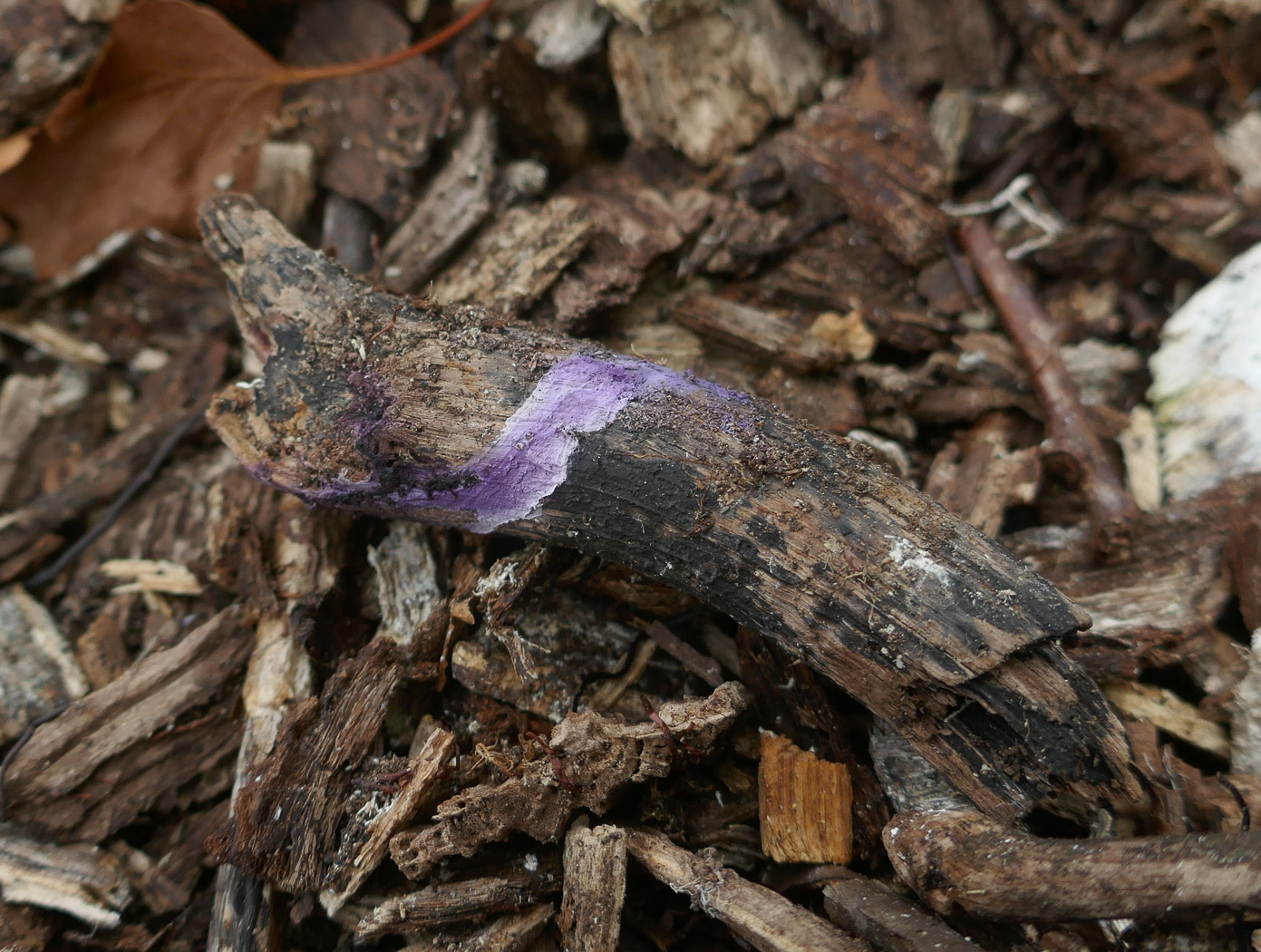
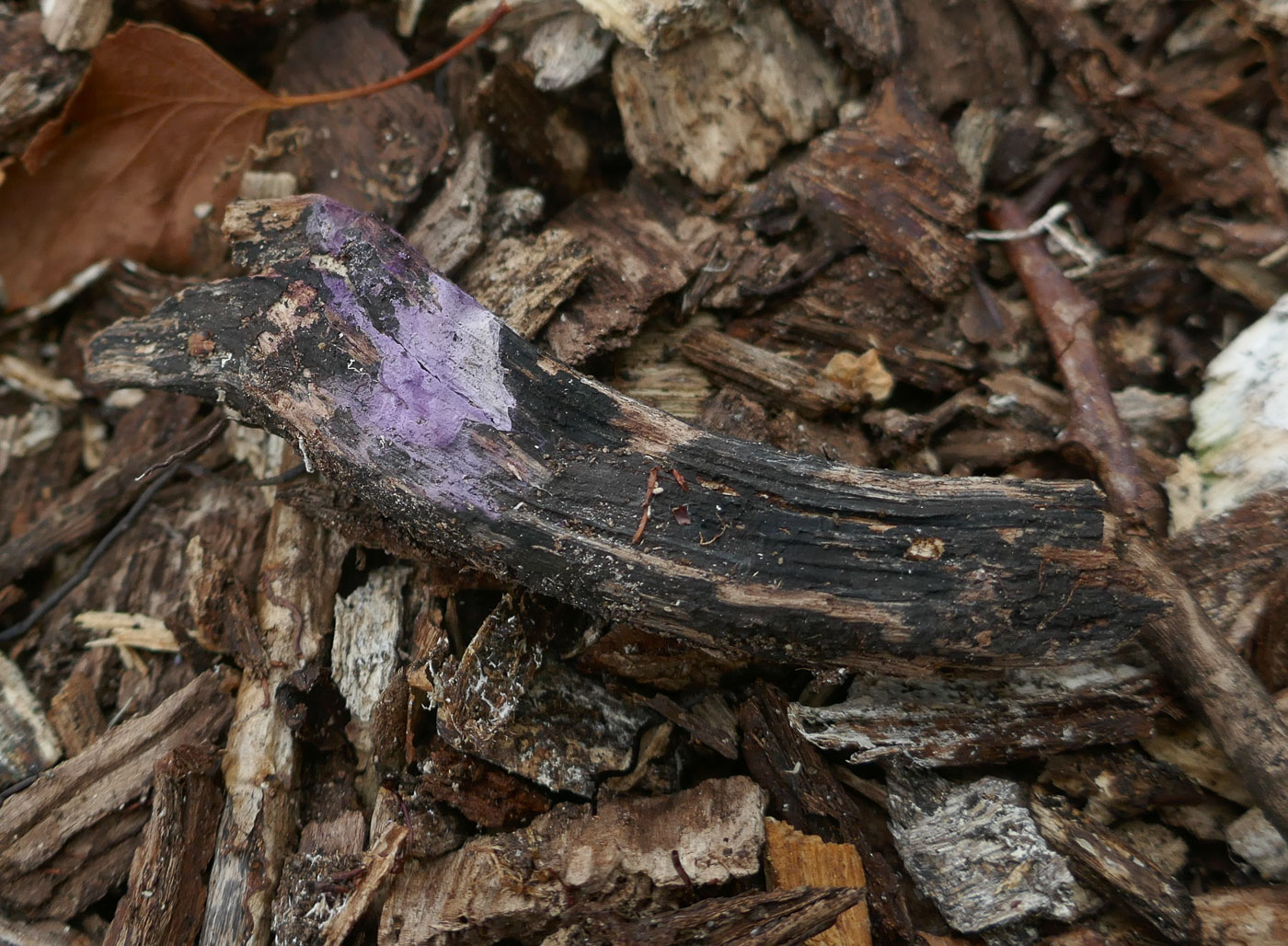 |
July 24th Phlebiopsis crassa (an unusual corticioid with no English name) At Stampwell Farm Jackie Ewan, encouraged by recent much needed rain, checked out a woodchip pile to see if Clathrus archerii was appearing yet. She found not that species but this striking splash of purple on a small deciduous stick caught her eye. At home she found cylindrical spores and noted that it turned black with KOH, then searched in vain for it in any of her books but traced it to Phlebiopsis crassa online where there are plenty of convincingly similar images. Though listed in Species Fungorum (so definitely an accepted species) this name is not in FRDBI nor in our BFG database, so one has to assume its rarity but what to record it as?! This was an exciting find and presumably is new to the county. New species |
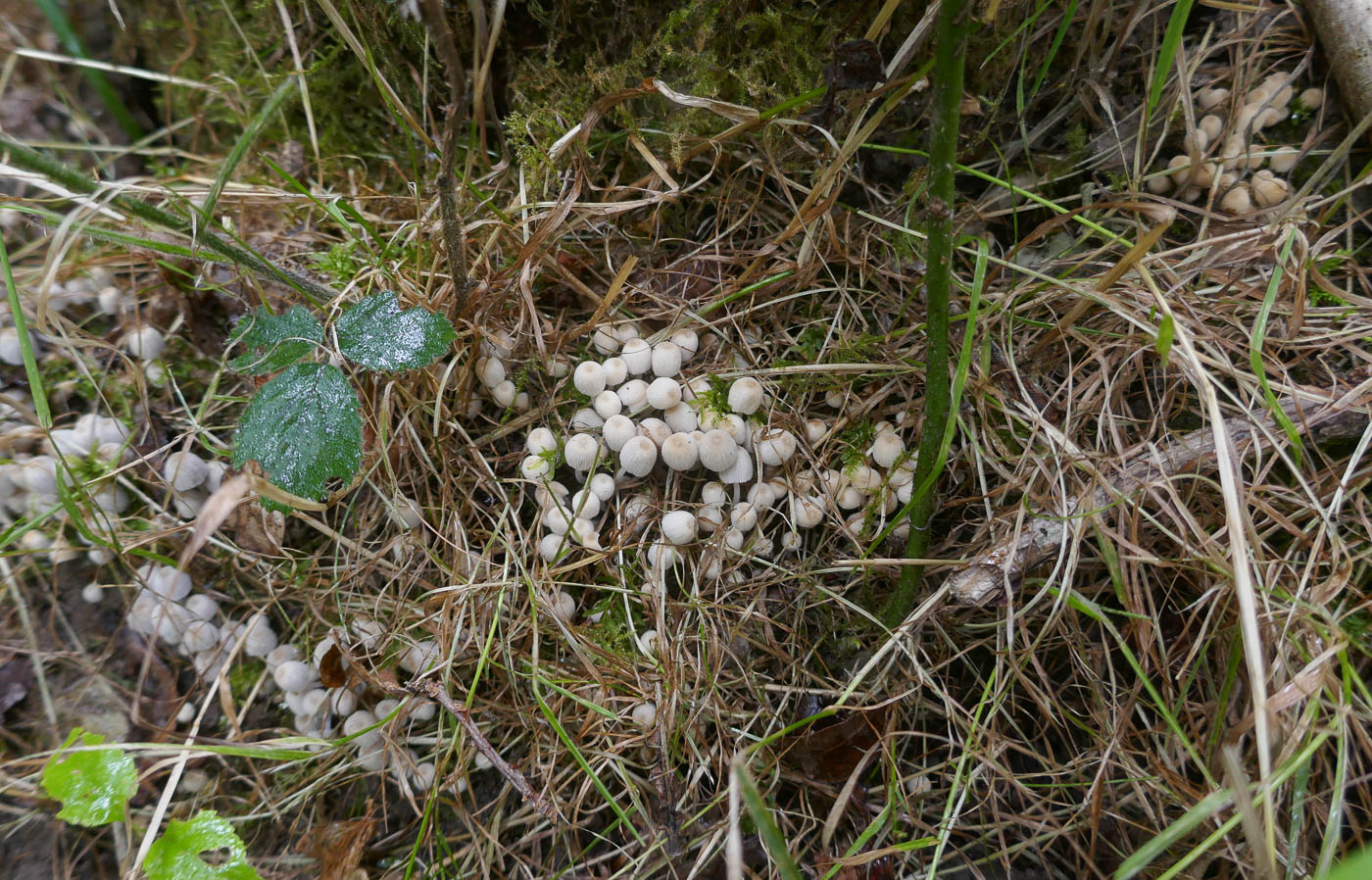
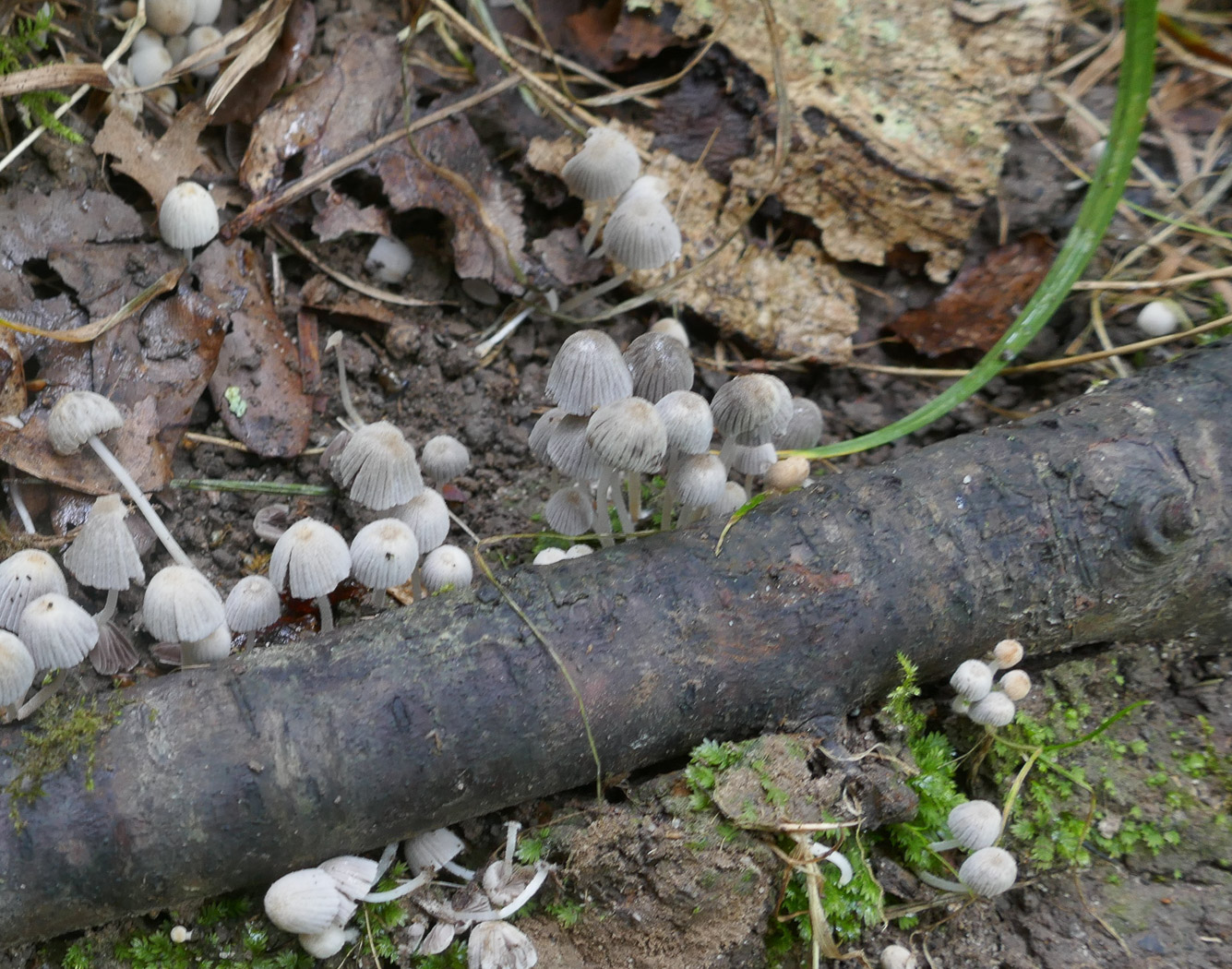 |
July 24th Coprinellus disseminatus (Fairy Inkcap) Jackie Ewan found this crop of little mushrooms coming up around the base of a shady Oak at Stampwell Farm. As can be seen by our previous images this is a trooping species and commonly fruiting around rotting wood any time between April and November, though Jackie reports she's not seen it at this site before. Previous finds |
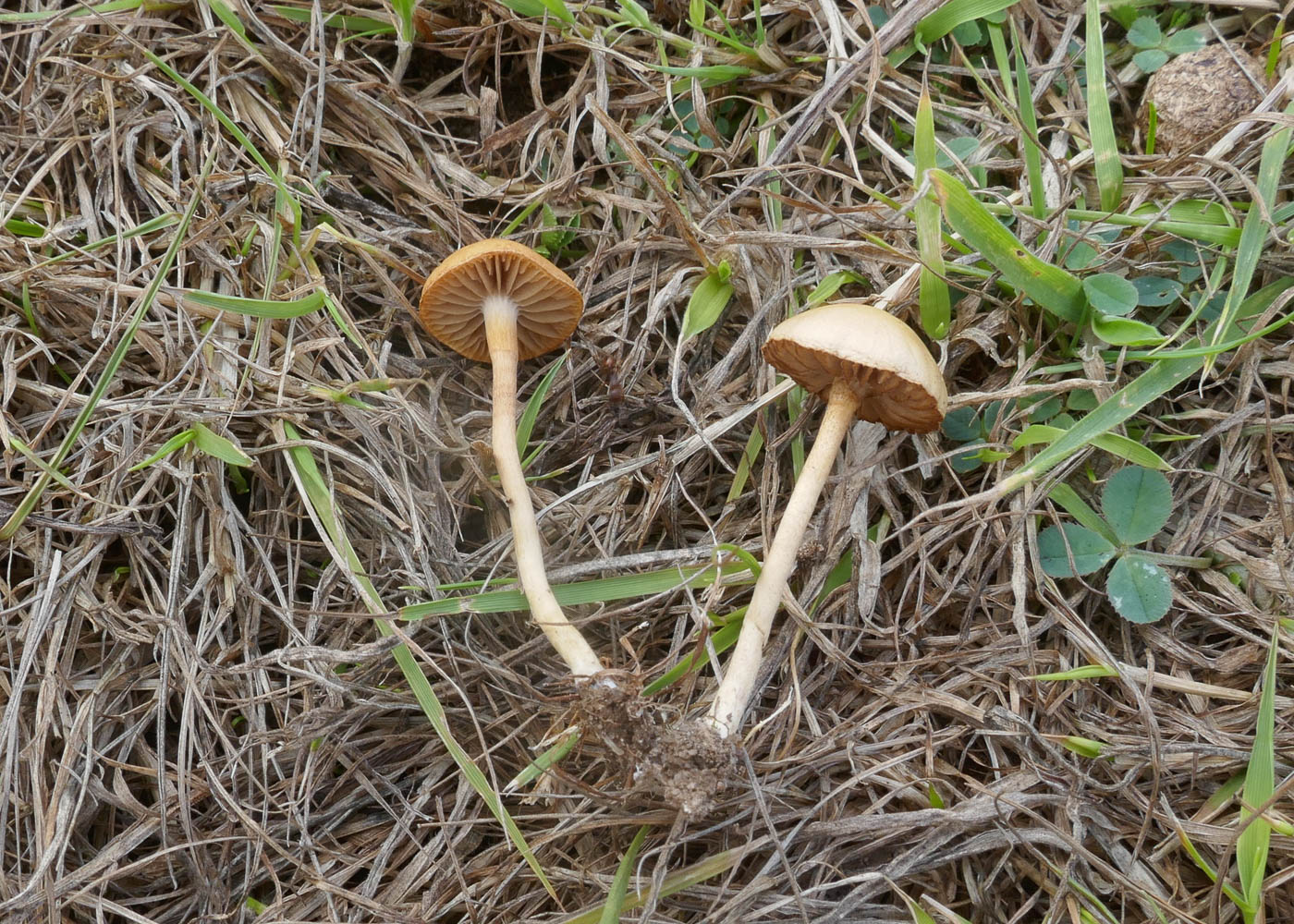 |
July 21st Agrocybe pediades (Common Fieldcap) At Stampwell Farm Jackie Ewan noticed a few specimens of this species scattered around the site - one where it is a regular from May through to July though nothing seems to have been very regular so far this year! Previous finds |
July 4th 2025
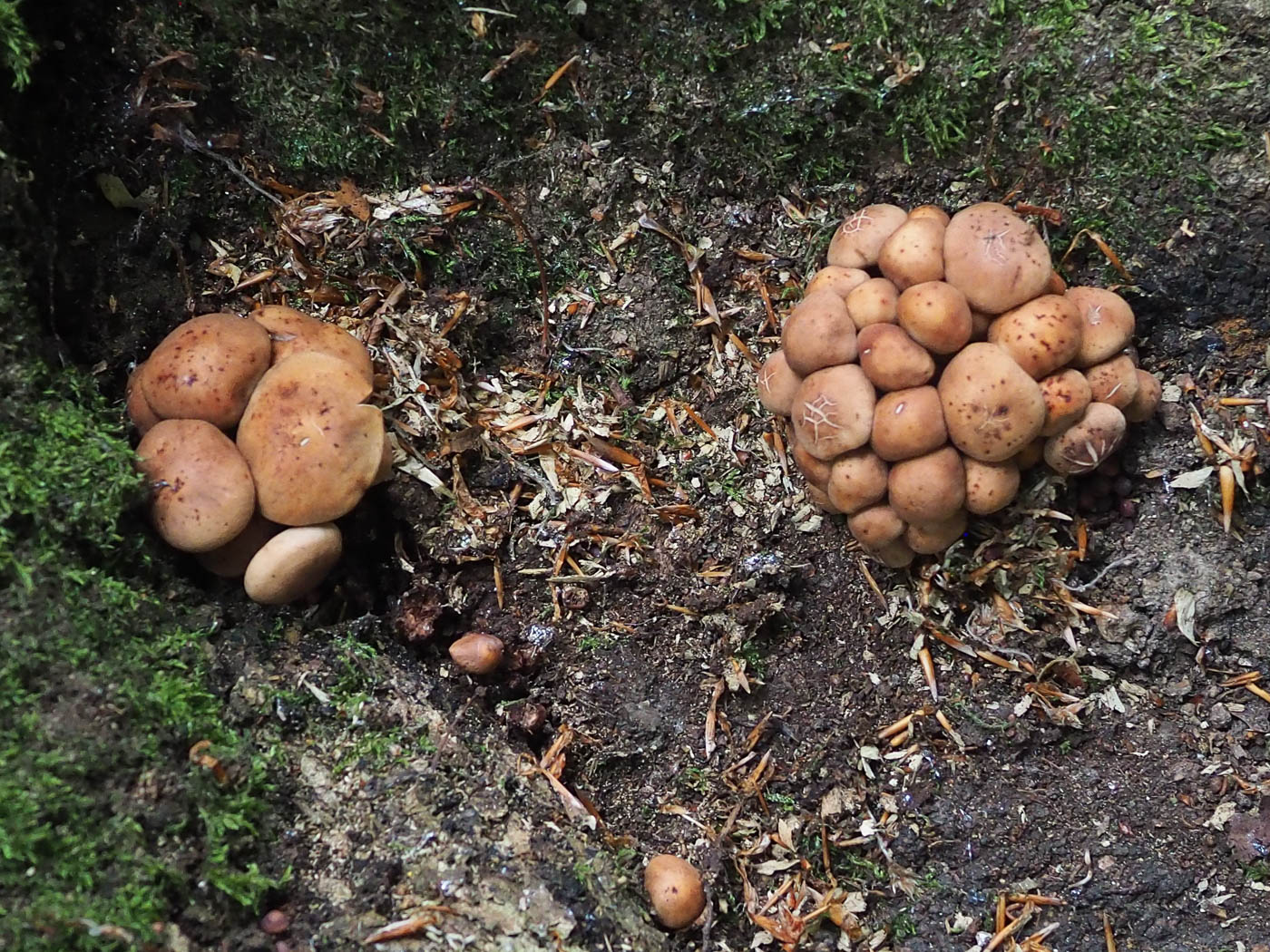
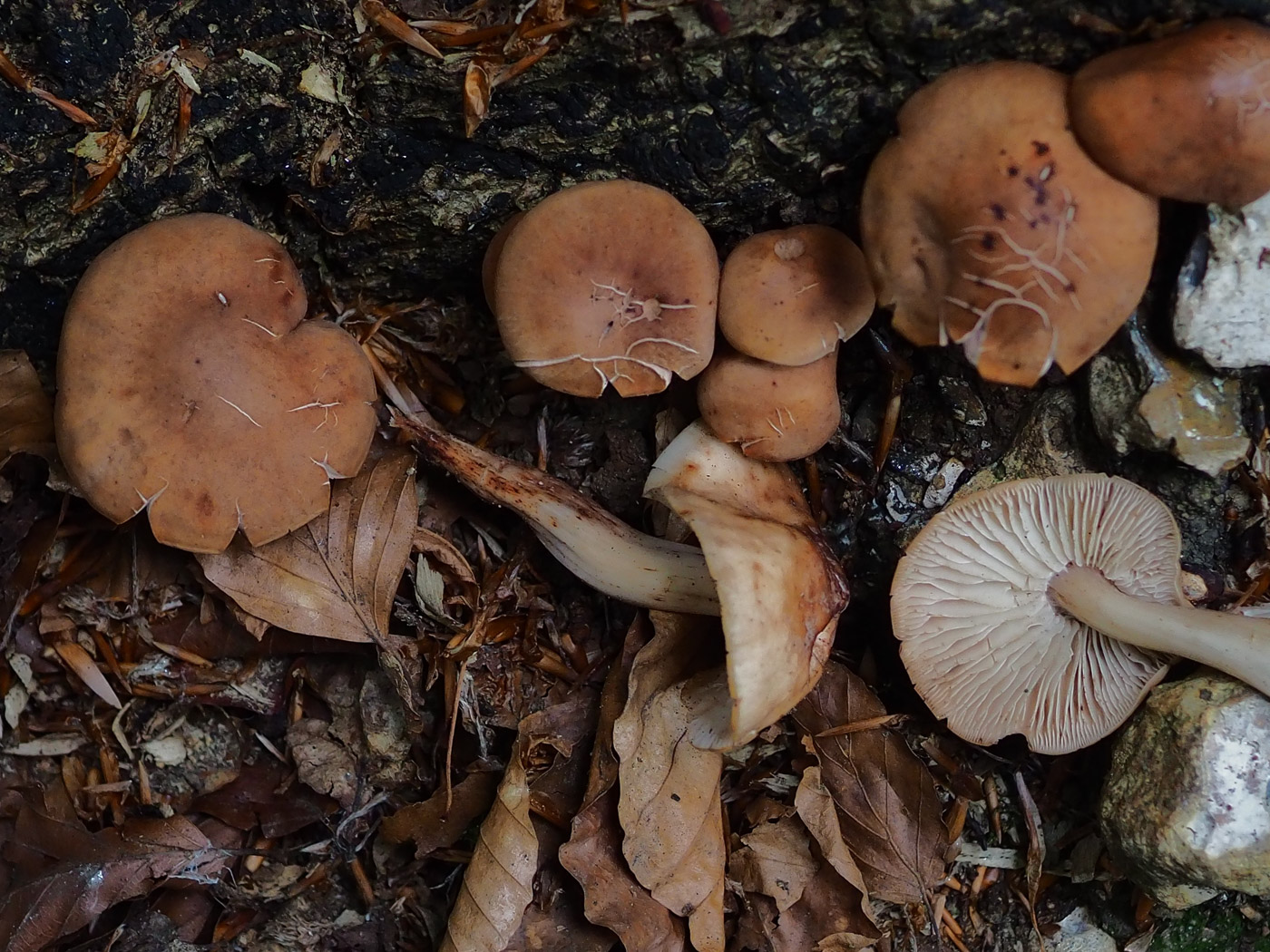 |
July 2nd Gymnopus fusipes (Spindle Toughshank) In Gt. Tinkers Wood John Catterson has been keeping his eye on this collection just poking through the woody debris near to an mature Oak trunk and now mature enough to be sure exactly which species it is. The rather spotty brown caps which are cracking in the heat, also the tapering and somewhat fibrous stems which are tightly clustered and conjoined at the base, make this an easy mushroom to recognise, especially when near to the trunk of Oka or Beech which it seems to favour. Previous finds |
July 3rd 2025
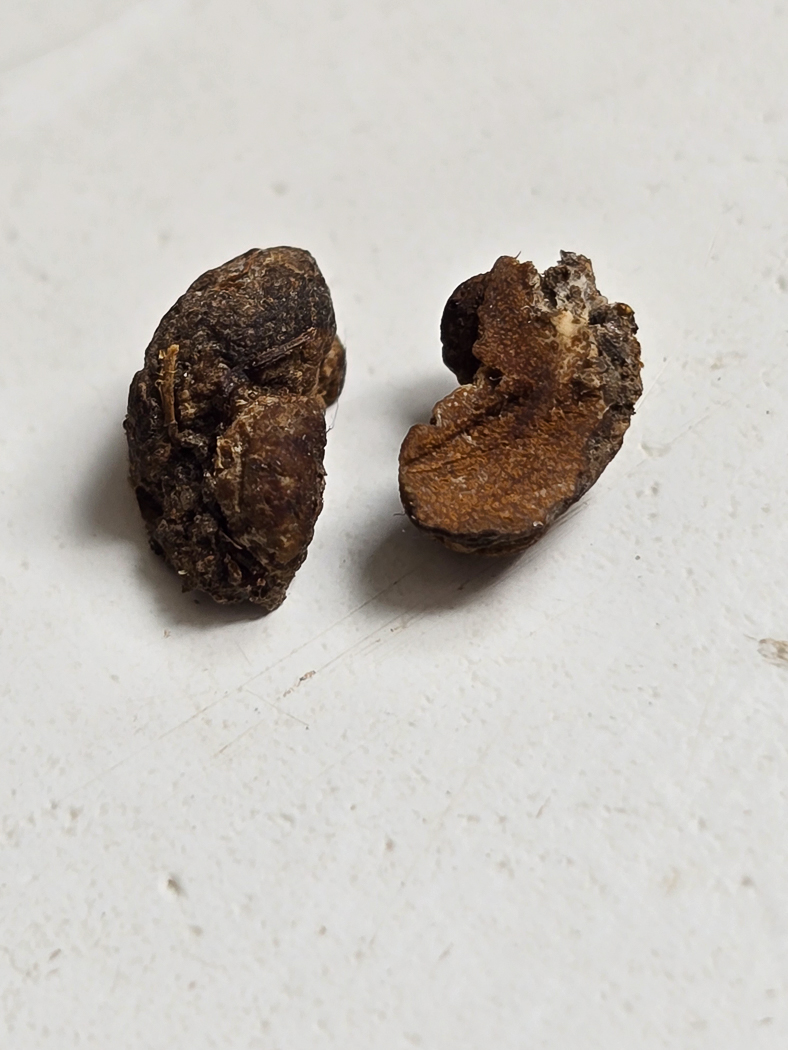 |
June 30th Hymenogaster citrinus (Citrine False Truffle) Whilst in Bourne End Jesper Launder spotted a roadside having both Hornbeam and Birch and on further investigation found some likely looking 'dig holes' underneath their canopy, ie small disturbances in the soil where small rodents had been excavating in their search for something edible, possibly truffles. As well as locating an example of the common Tuber rufum (Red Truffle), he also found this rather past-its-best truffle which he took home to identify. To his surprise he found notably large citriform to fusiform shaped spores and this together with other clues pointed to H. citrinus though he says that H. olivaceus is quite similar so cannot be ruled out definitively. Neither species are common and he's not found them at all frequently, so this is one to be dried and sequenced. What really surprised him, however, was that any member of this genus - known to favour damp condition - should be fruiting in this spell of notably hot dry conditions. His previous find of this species was new to the county. Previous finds |
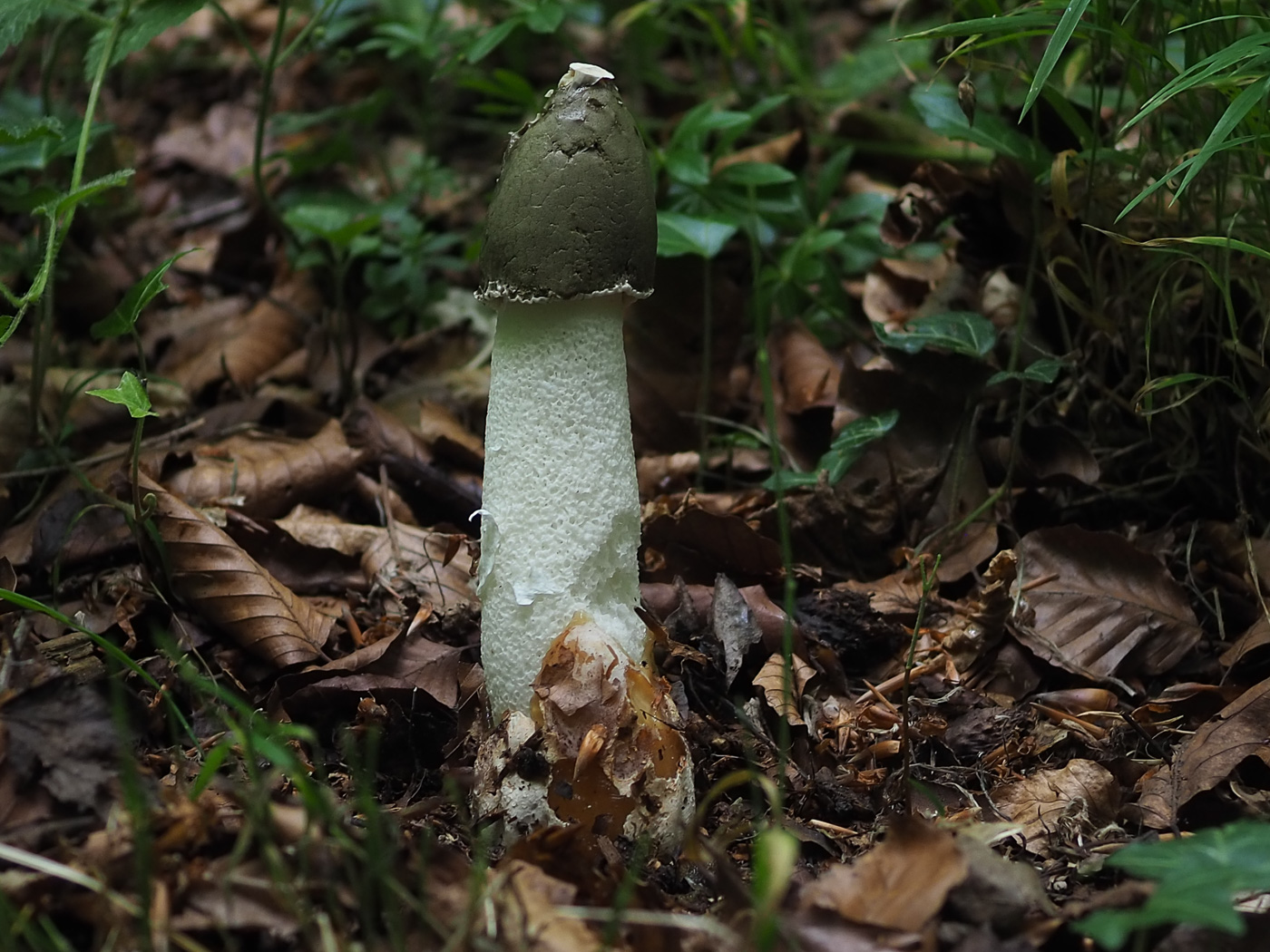 |
June 28th Phallus impudicus (Stinkhorn) In Great Tinkers Wood John Catterson came across this fresh specimen clearly awaiting the arrival of flies and insects to enjoy the feast and do their work in spreading its spores. Looking through our previous entries, of which there are plenty, several were found in June with one in May so this is not unusually early for it to be fruiting though what is unusual this year is to find anything fruiting at the moment! Previous finds |
June 19th 2025
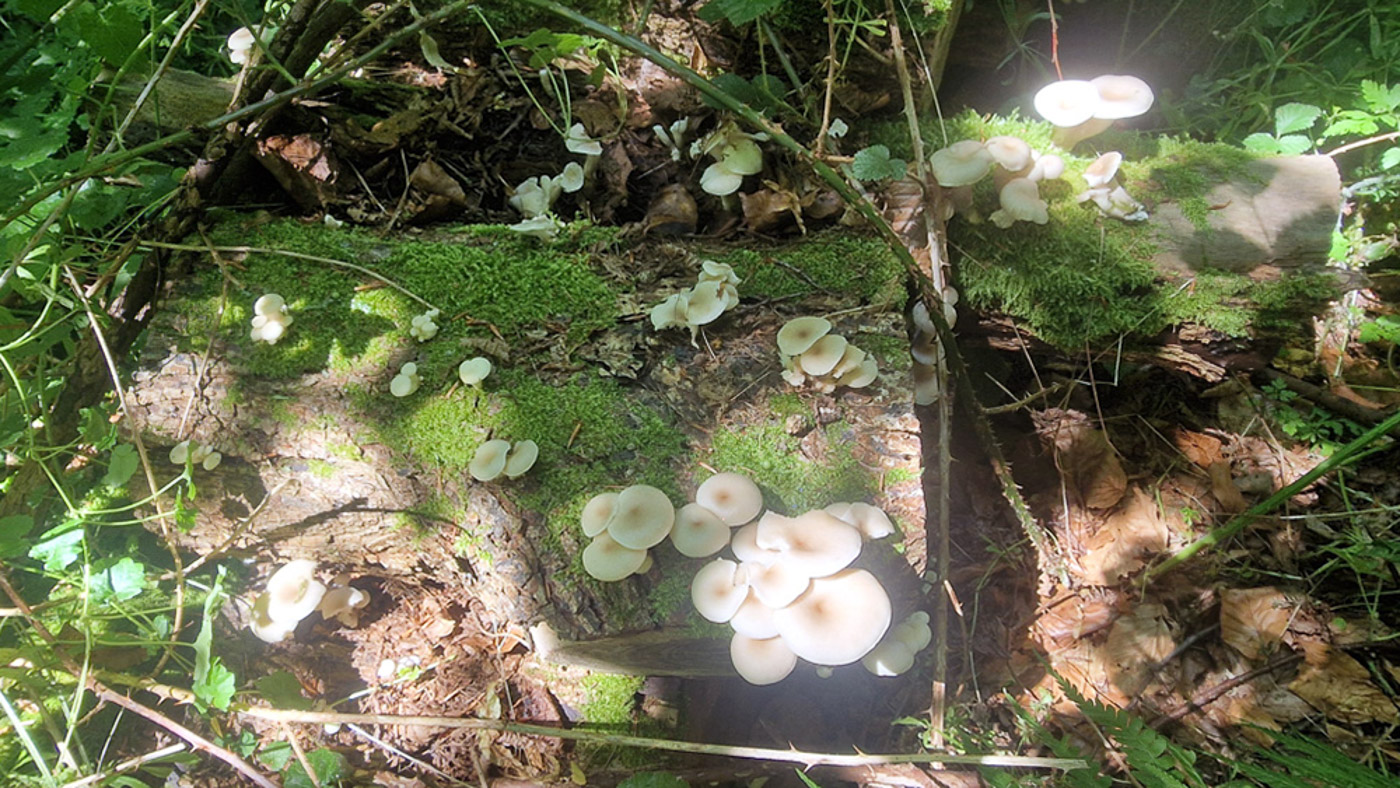
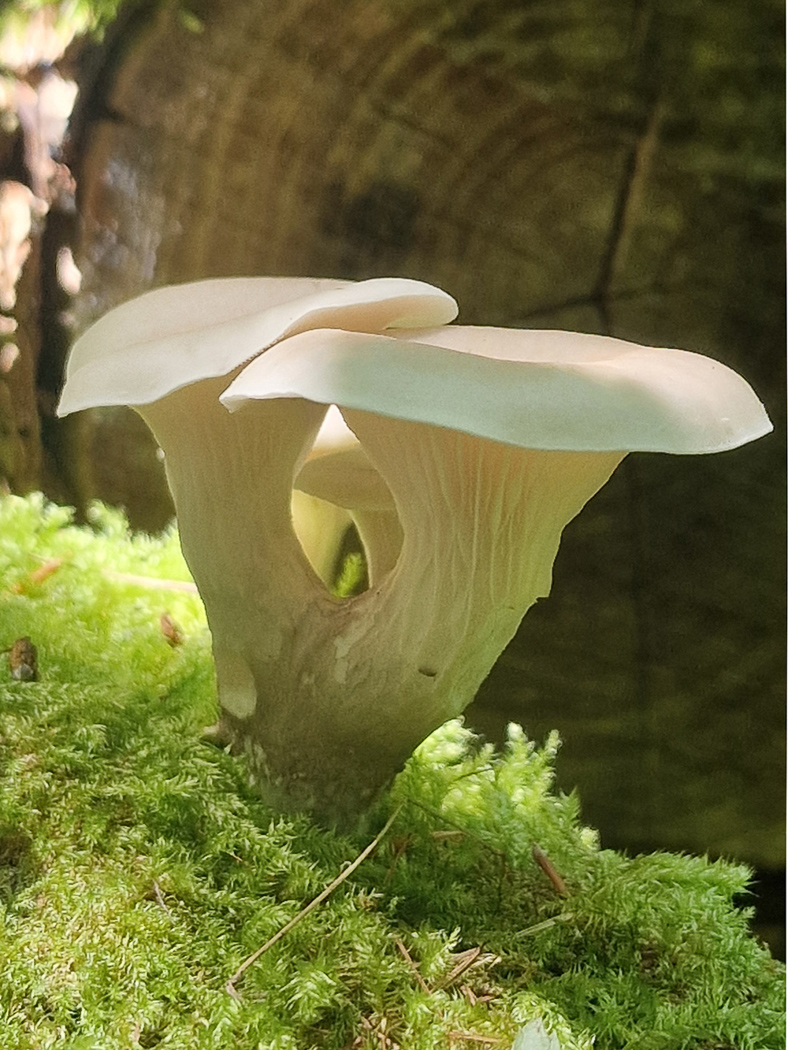
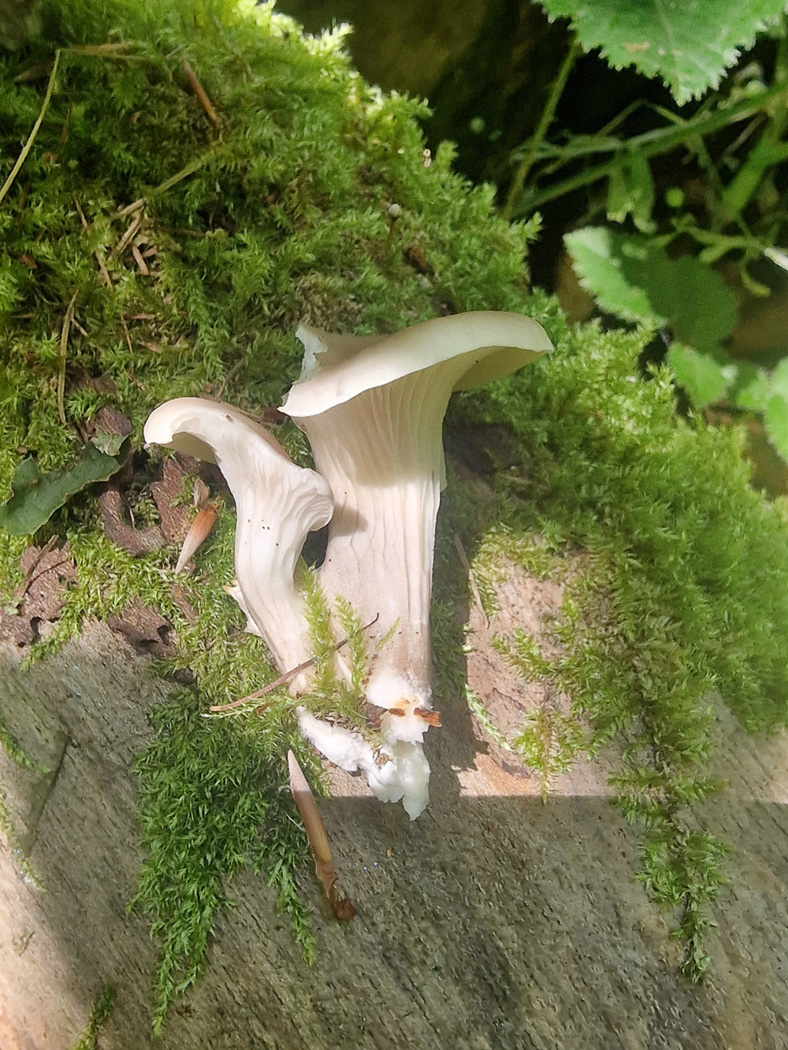
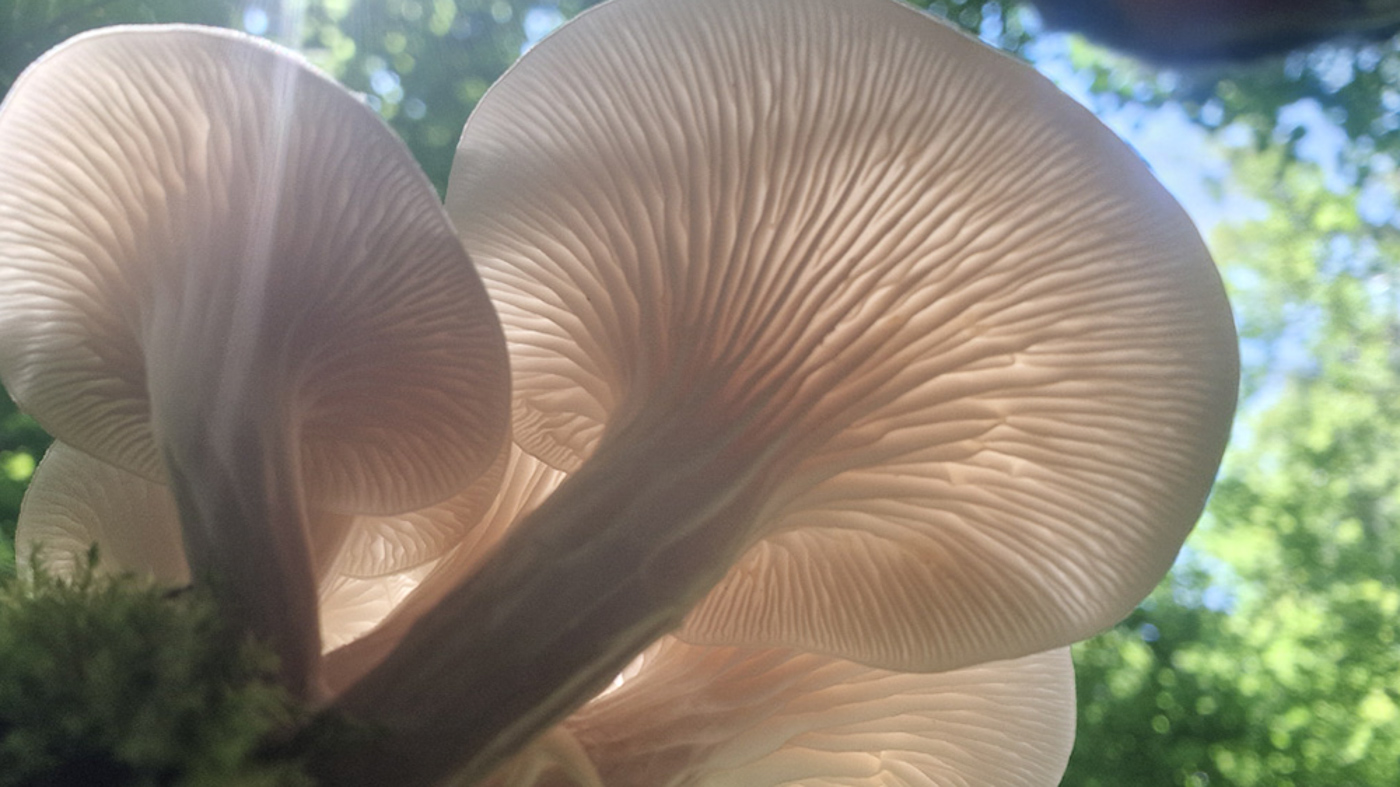 |
June 16th Pleurotus cornucopiae (Branching Oyster) At Cliveden Lisa Rick was astounded to come across this impressive show at a time when such fungi have been conspicuous by their absence - the fallen trunk was not named but is possibly Beech. From the photos Penny has named this P. cornucopiae rather than the more common P. ostreatus on account of the clear ridges visible running right down the lengthy stem - not found in the commoner species. Previous finds |
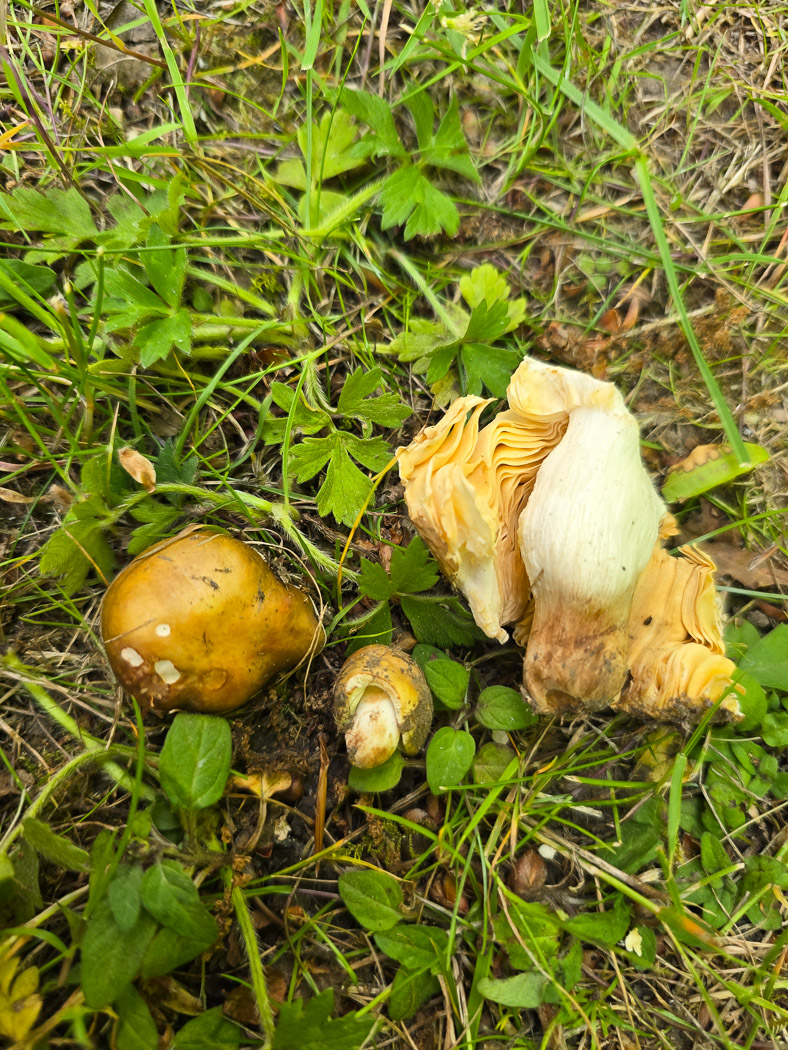
 |
June 15th Russula cuprea (Gnarled Brittlegill) In Little Chalfont whilst searching for truffles in a spot there which has proved very fruitful, Jesper Launder was surprised to find this unusual-looking Russula in moss under Beech and Oak. It is early in the season for this genus though not exceptionally so though somewhat unexpected considering the dearth of gilled fungi recently. However, the species is rare, also a tricky one to identify because the cap colour is renowned for its remarkable variability - a feature which adds to the challenge of this genus. The species epithet means copper-coloured, but caps can be anything between brown, vinaceous red to cinnamon or even green! A useful pointer is the extremely dark spore print colour - one of the deepest orange in the genus, but microscopic examination is essential for reliable ID. It was a new species for Jesper and Penny has found R. cuprea only once in the county but not confirmed with sequencing, so it would be useful to get this collection tested. New find |
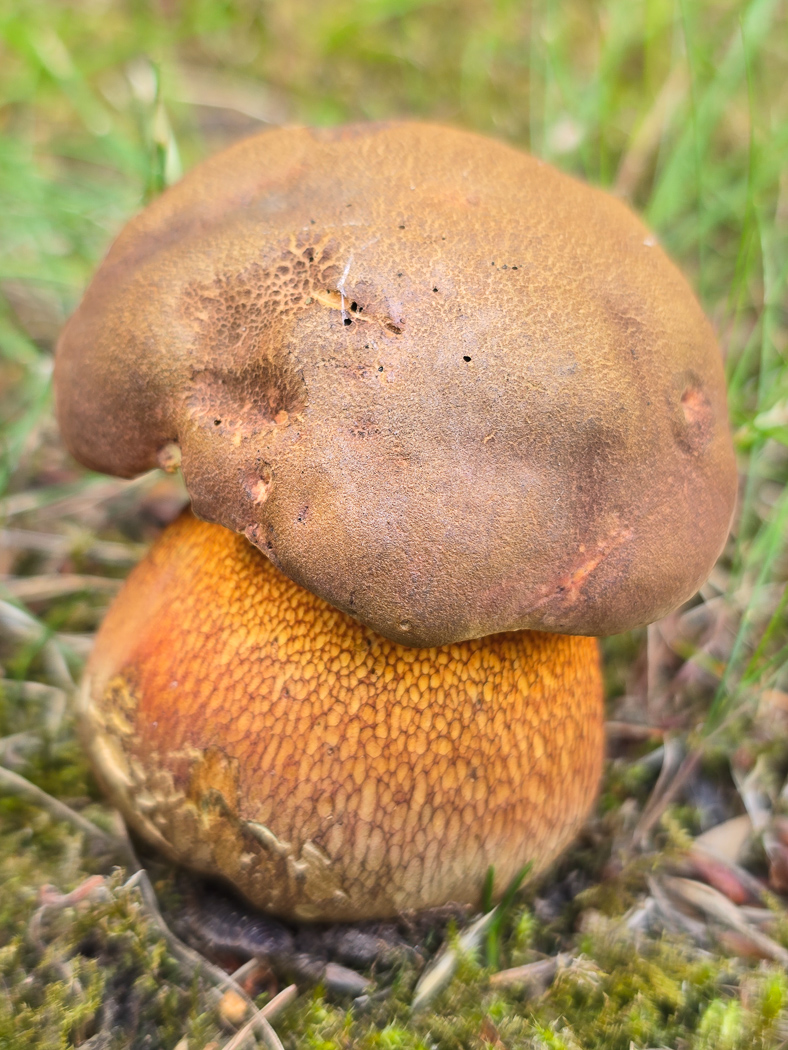 |
June 15th Suillellus luridus (Lurid Bolete) Under Hornbeam in Chalfont St. Peter Jesper Launder saw this nice fresh singleton as yet not fully developed but identifiable from the cap colour with yellow tones, the orange red pores (not shown here), and distinctive network on the stem. Previous finds |
 |
June 14th Helvella cf. fibrosa (a very rare species of Saddle with no English name) On a mossy roadside bank in Chalfont St. Peter Jesper Launder spotted this tiny Helvella which though similar to H. macropus didn't ring any bells with him. (He apologises for the photo which had to be taken rapidly because of the uncomfortably close traffic!) At home the spore shape - ellipsoid and not fusiform - eliminated H. macropus, and following an online key then led him close to H. fibrosa though there seems discrepancy as to whether this species has smooth or finely ornamented spores - he found smooth spores - though other features appear to fit well. FRDBI has just two records and we have no mention of this species in our Bucks database, so this is clearly one for sequencing .............. New find |
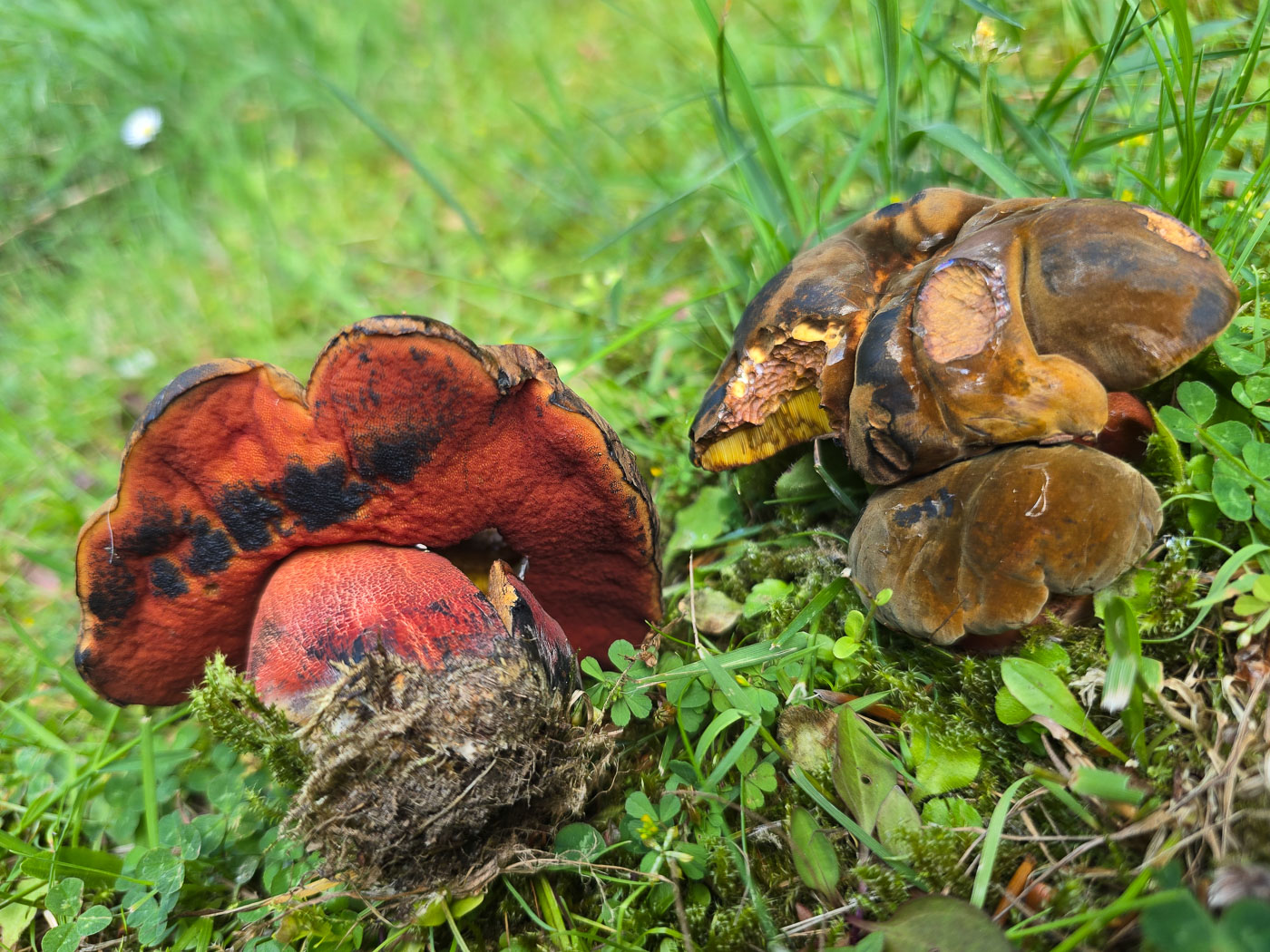 |
June 14th Neoboletus luridiformis (Scarletina Bolete) Under Beech in Jordans Village Jesper Launder found this cluster of distinctive boletes pushing through the soil. The brown velvety cap surface, orange red pores bruising strongly deep blue together with the substantial reddish stem marked with floccules was enough to name it in the field. Previous finds |
June 12th 2025
.jpg) |
June 9th Cyanoboletus pulverulentus (Inkstain Bolete) In Jordans Village in a grassy verge under Oak and Beech Jesper Launder found this stunning example of a bolete which stains intensely deep blue on damage though has yellow rather than red or orange pores as in others which have blue staining flesh. I wonder, can we take this as a strong sign that at last there's been sufficient rain to trigger some fungi into fruiting at last?! Previous finds |
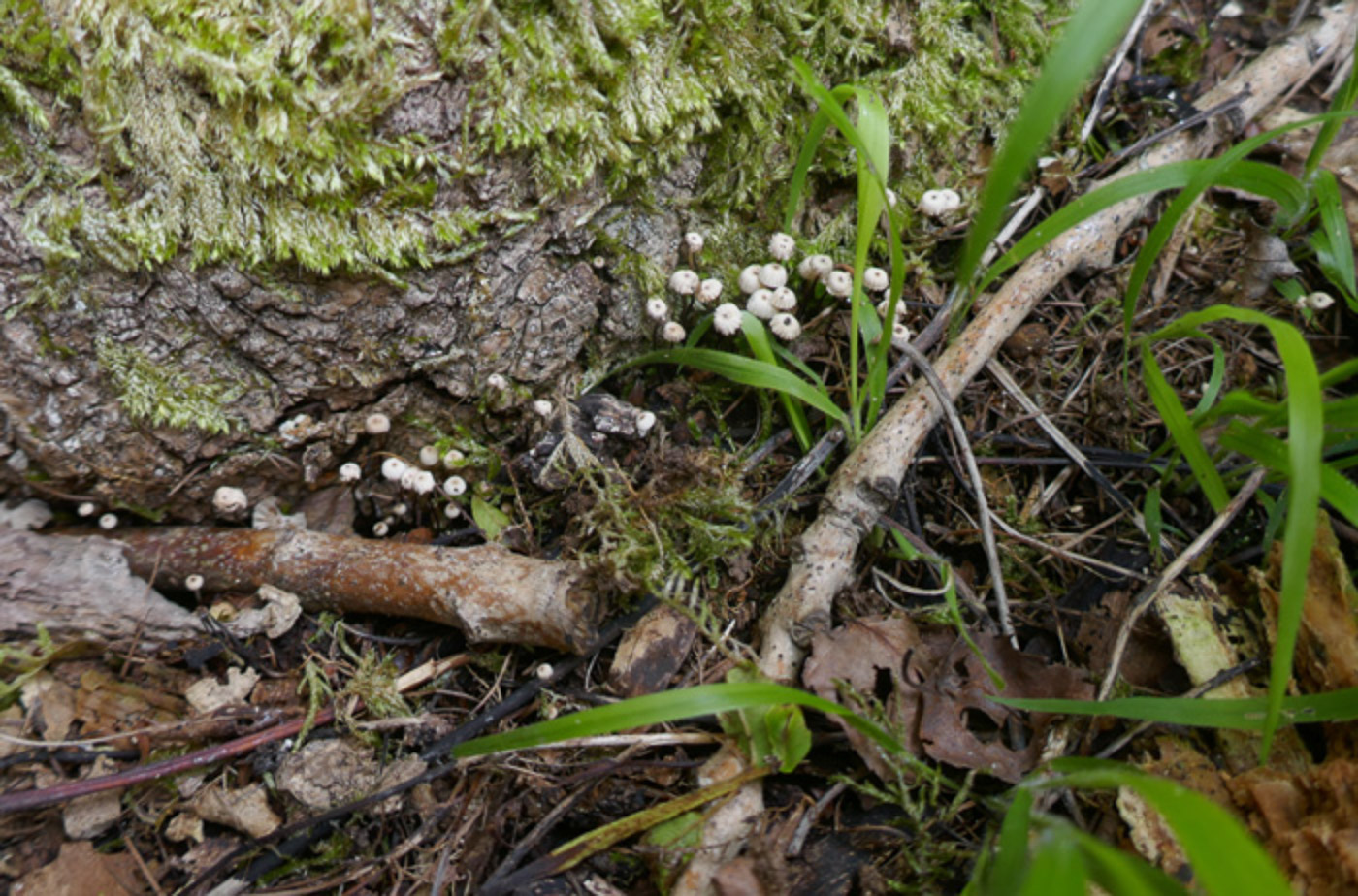
.jpg)
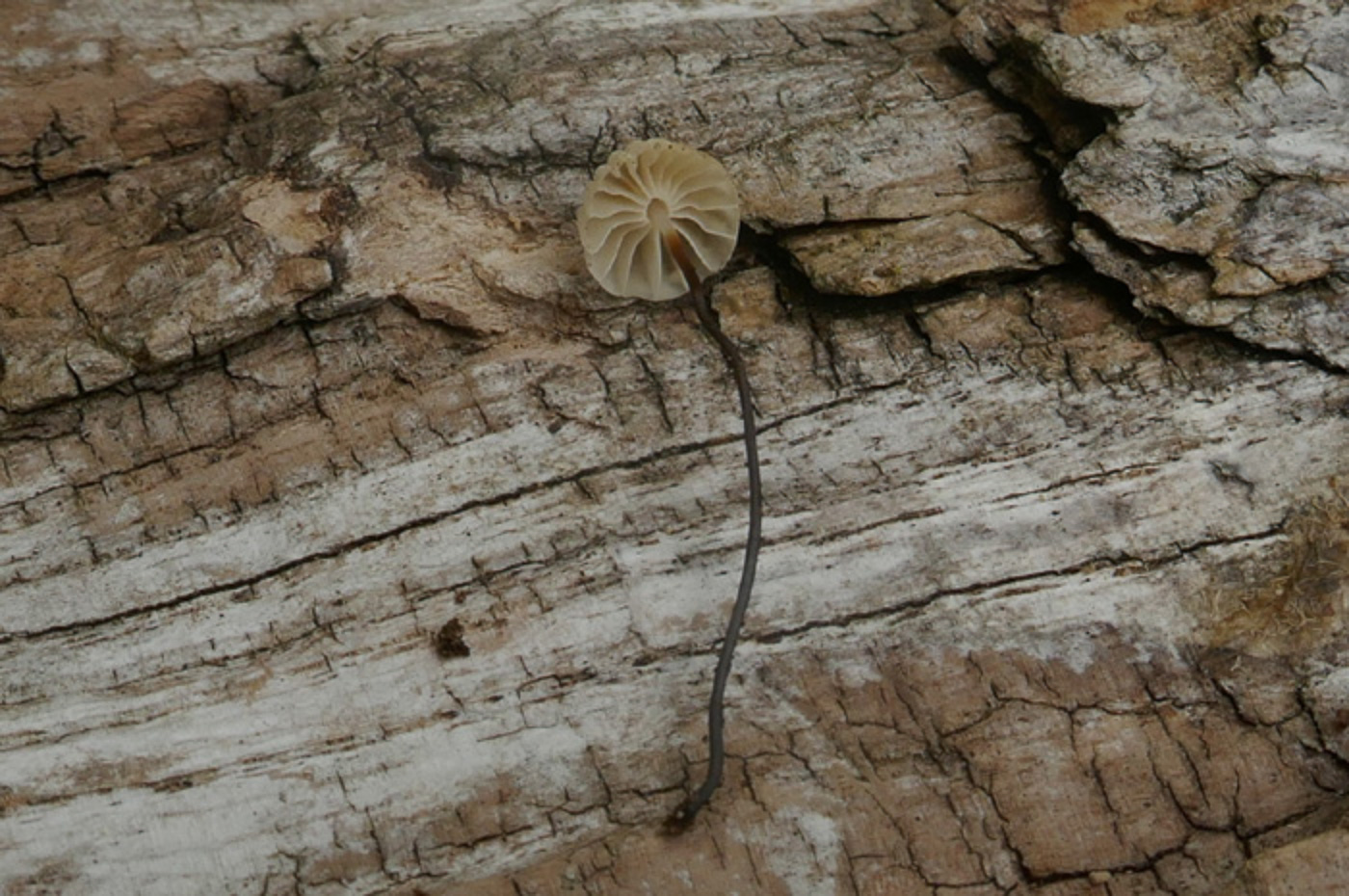 |
June 9th Marasmius rotula (Collared Parachute) At Stampwell Farm Jackie Ewan was pleased to see the good quantities of this common species of woodland litter fruiting on the woody remains of Ash. This number of fruitbodies was a certainly sight for sore eyes after the dearth in recent months. There are several other species in this genus which can look similar from above, but not with the distinctive 'cogwheel' effect where the gills attach to a 'collar' rather than to the stem itself in this way. The much rarer and miniscule M. bulliardii also sports this gill attachment but is tiny, has a dark central 'dot' in the cap and occurs only on fallen deciduous leaves - usually Beech - and not on woody remains. Previous finds |
.jpg) |
June 9th Gymnopus confluens (Clustered Toughshank) At Stampwell Farm Jackie Ewan found a few of these in a grassy woodland path, no doubt responding to the recent and much needed rains. A common woodland fruiter, the species can be found both tightly clustered and also on occasion singly when it tends to confuse for obvious reasons. The very crowded gills and finely furry stems are good characters to look out for. The site now has a long species list but Jackie says this was the first time she's found it here. Previous finds |
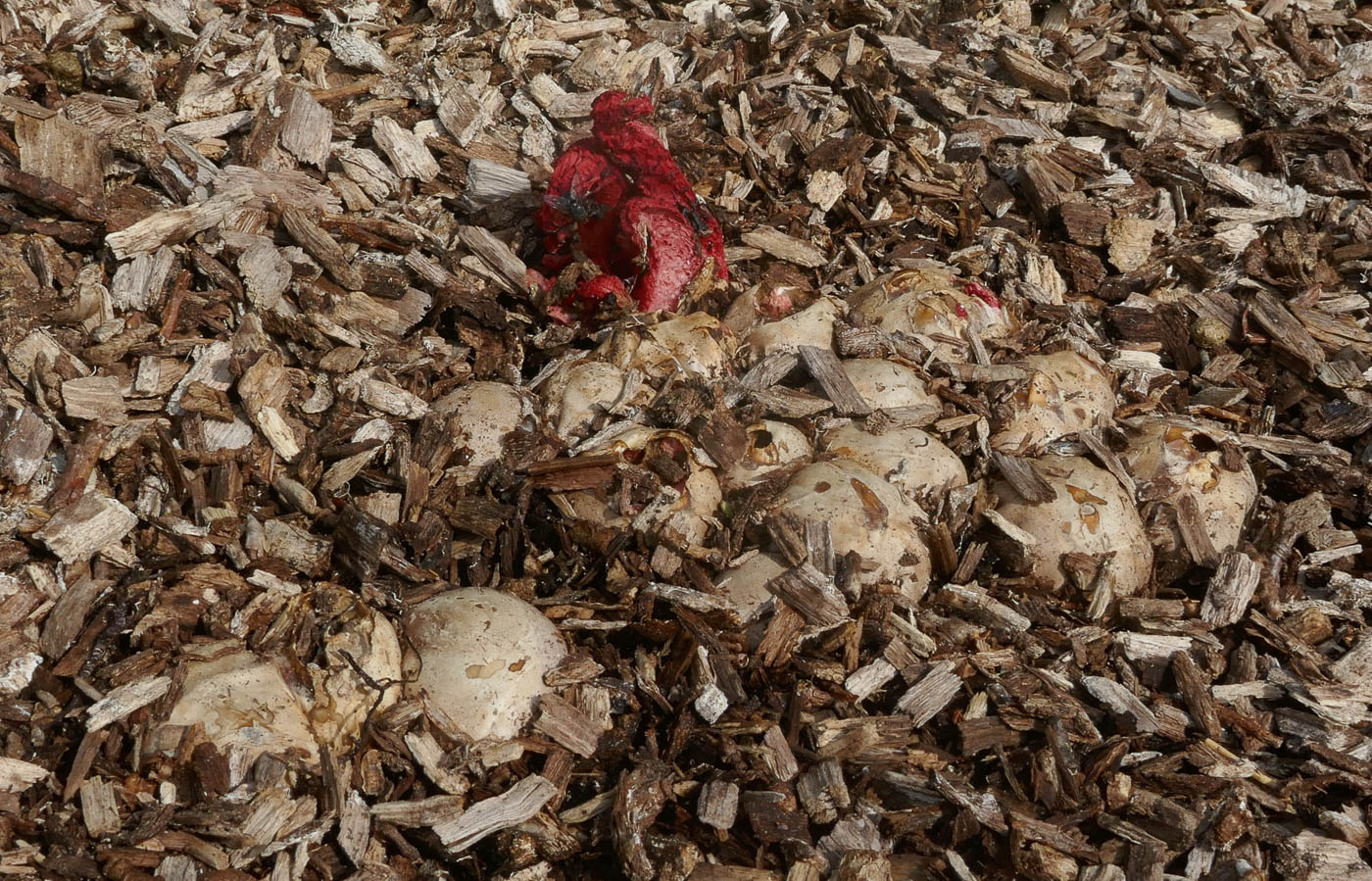
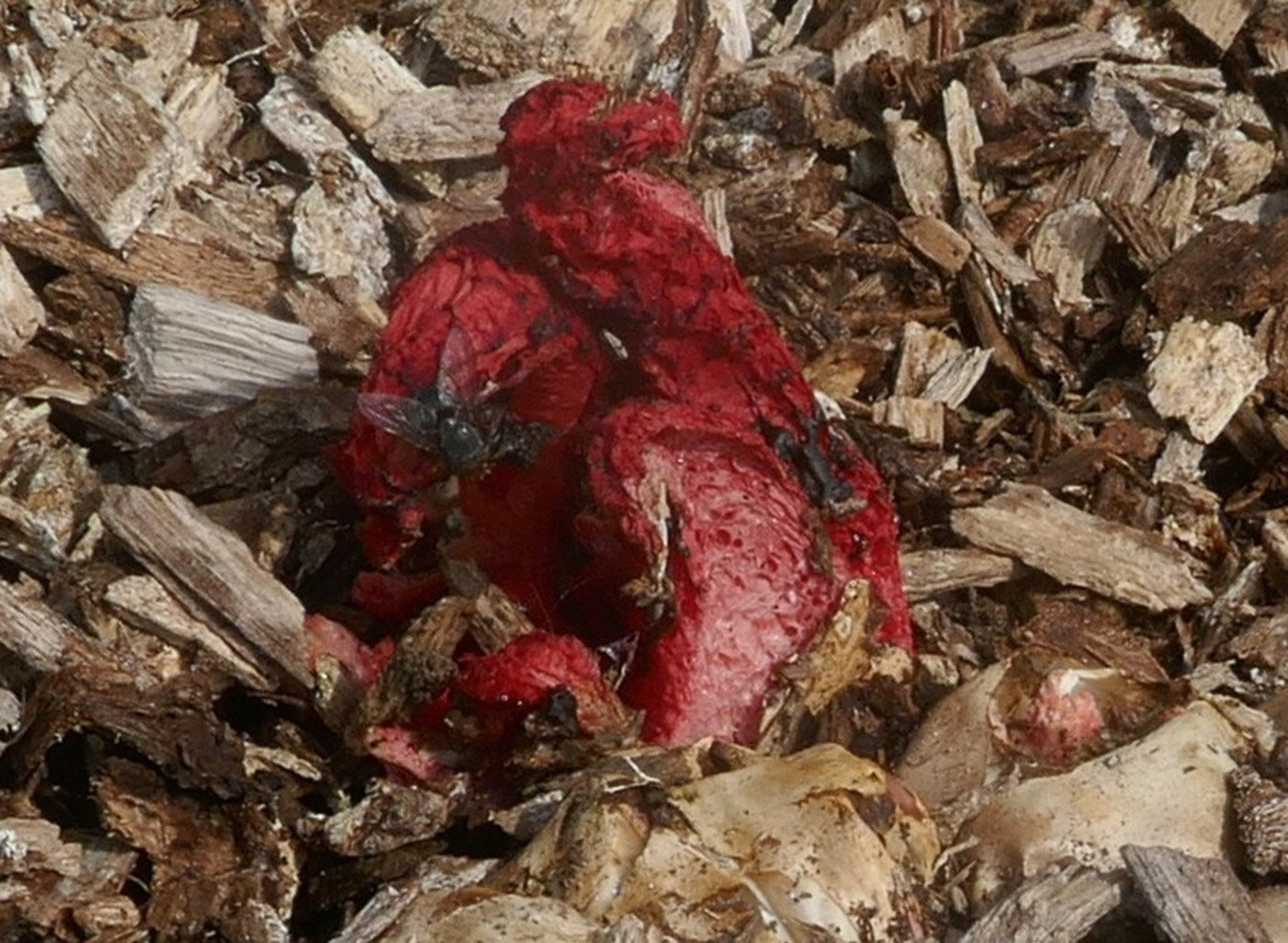 |
June 6th Clathrus archeri (Devil's Fingers) This species was a surprise to find at this time of year at Stampwell Farm where it has been found regularly for the last few years though always later in the year. Jackie Ewan reports that there was a large clutch of no less than 18 eggs with just one or two far enough developed to show the distinctive red of the mature fruit bodies. They were enjoying a newish woodchip pile in the same spot where she first discovered the species here in 2021 though the pile was formed much more recently than that from local prunings indicating that the re-occurrence of the species is due to the site itself rather specifically to the woodchip pile. Previous finds |
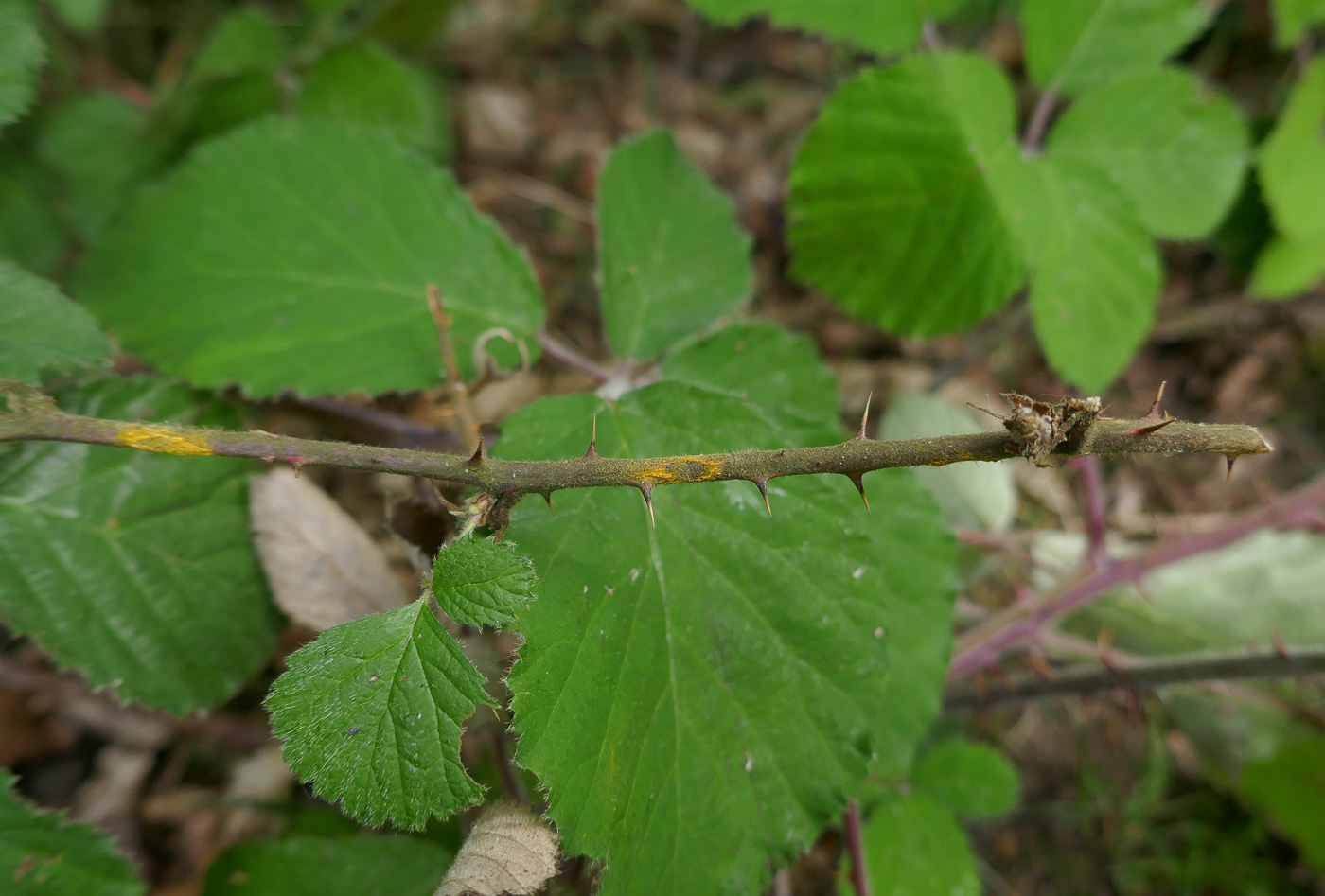 |
June 6th Kuehneola uredinis (Pale Bramble Rust) At Stampwell Farm Jackie Ewan spotted this distinctive rust which frequents Bramble stems at this time Previous finds |
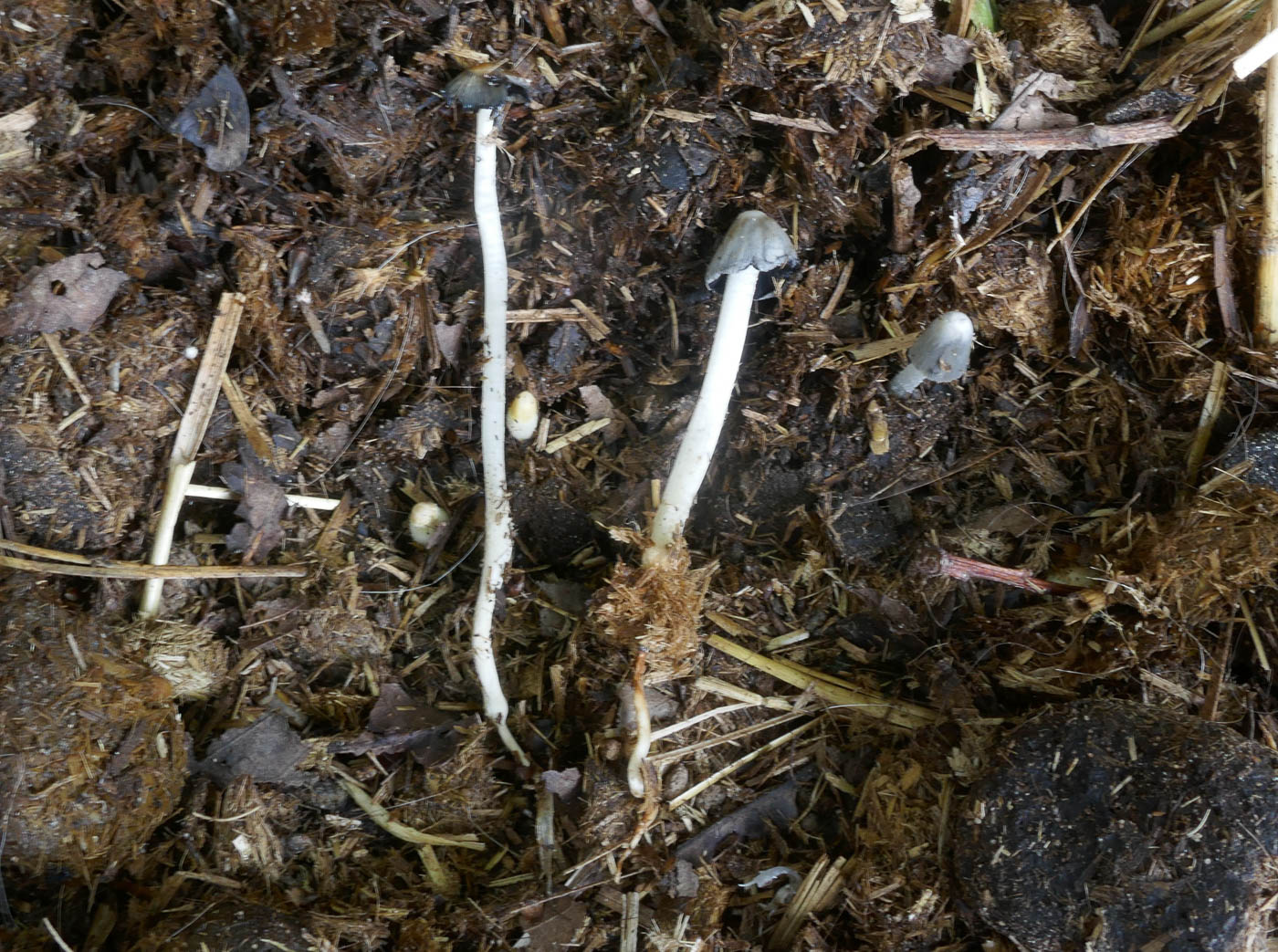
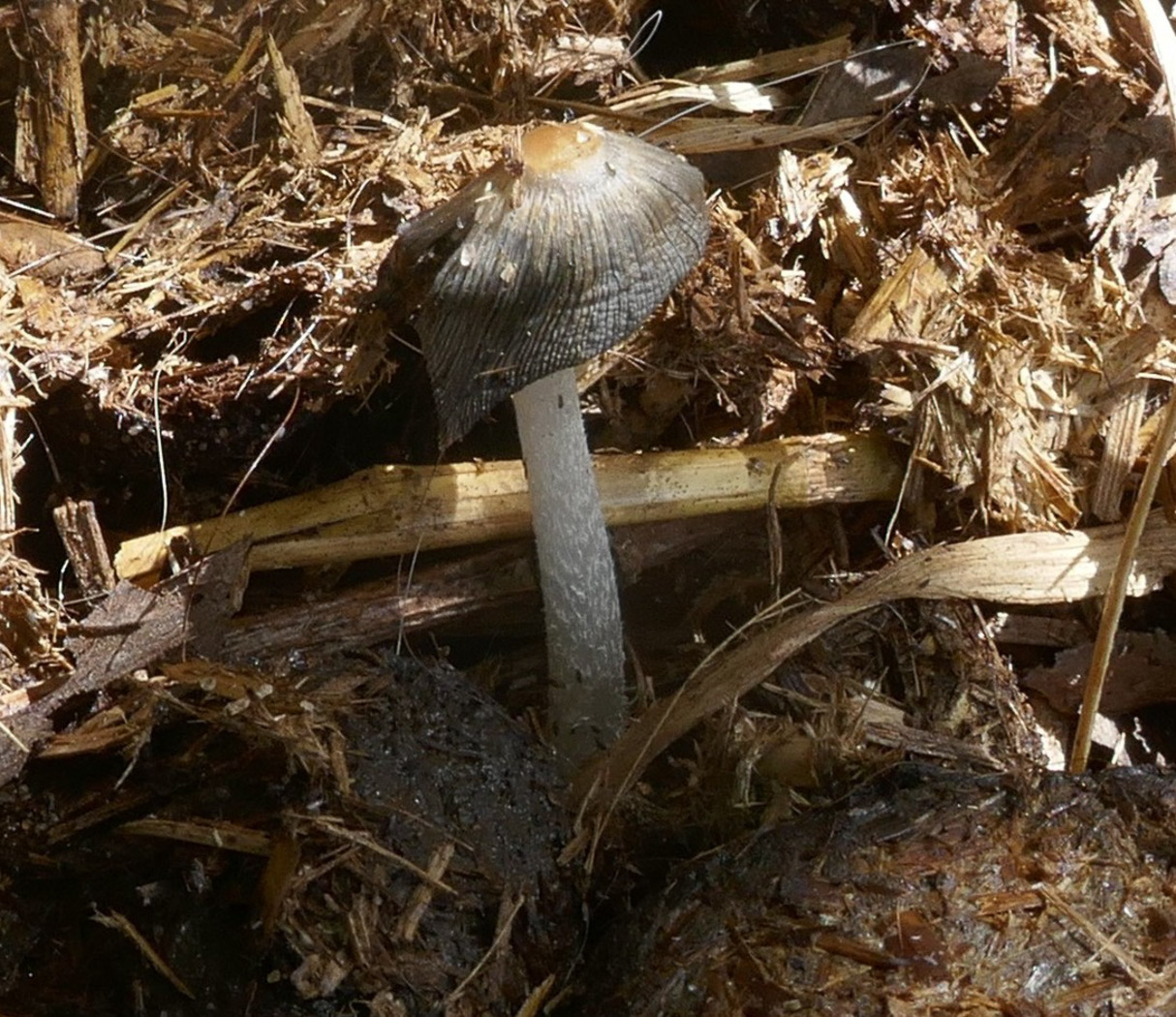 |
June 6th Coprinopsis cinerea (Grey Inkcap) On the dung heap at Stampwell Farm Jackie Ewan noticed this species just beginning to appear. This is in fact a relatively common dung Inkcap though we appear to have only a handful of county records, and our first Finds entry was from this same dung heap at the farm a couple of years back. It favours dung heaps with straw, as here, rather than dung in the field. Previous finds |
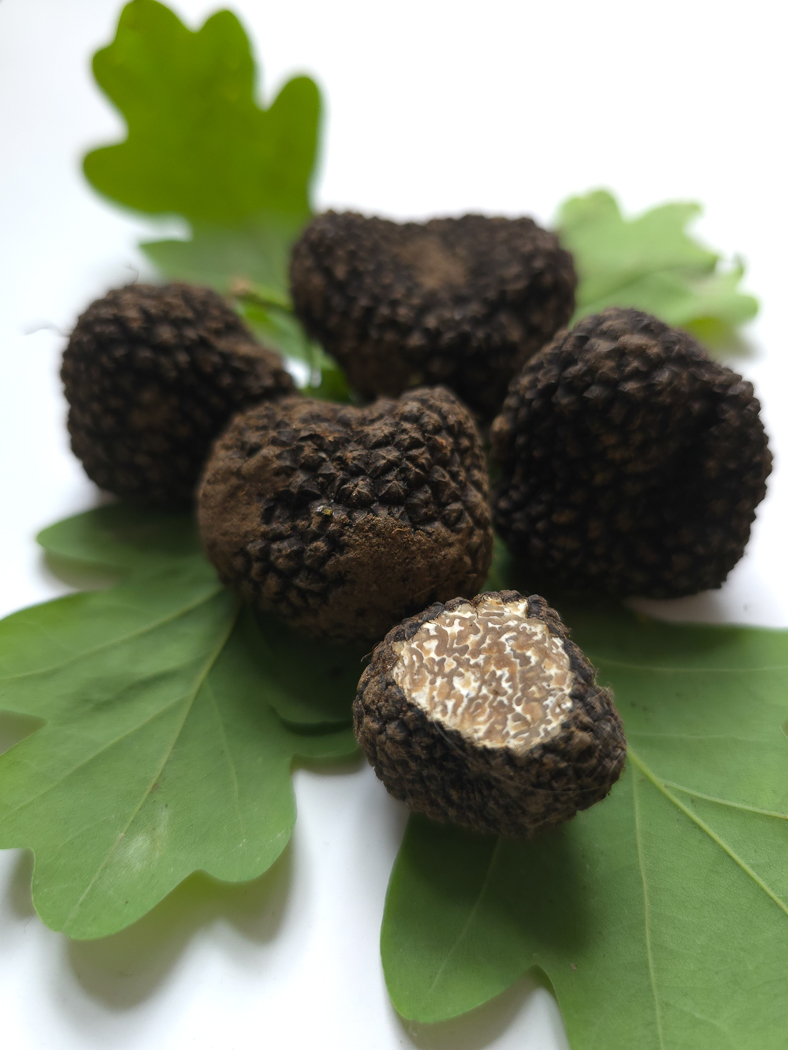 |
June 6th Tuber aestivum (Summer Truffle) Under Oak in Gerrards Cross Jesper Launder noticed various likely 'digholes' where truffles might be lurking and on making a search was rewarded with this selection (the photo taken later at home in order to show the interior). This is the time to be looking for this striking species, particularly under Oak or Beech, and it is probably quite common in our area though we still have only a handful of county sites where it's been recorded. Previous finds |
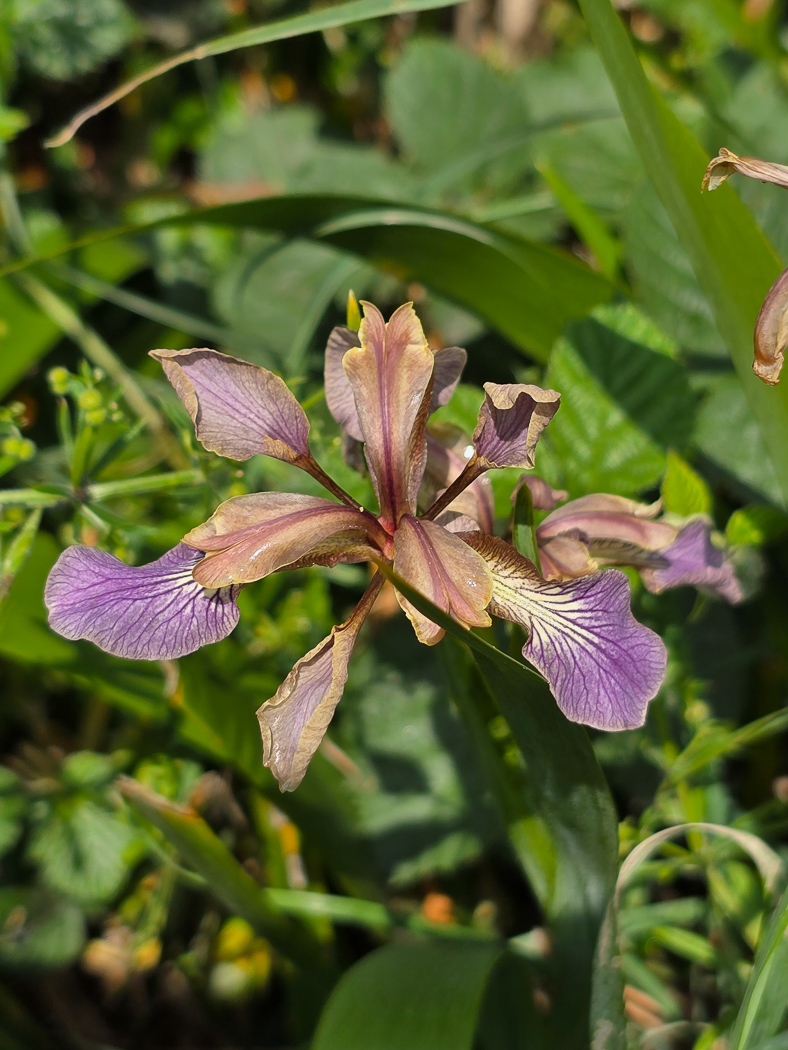
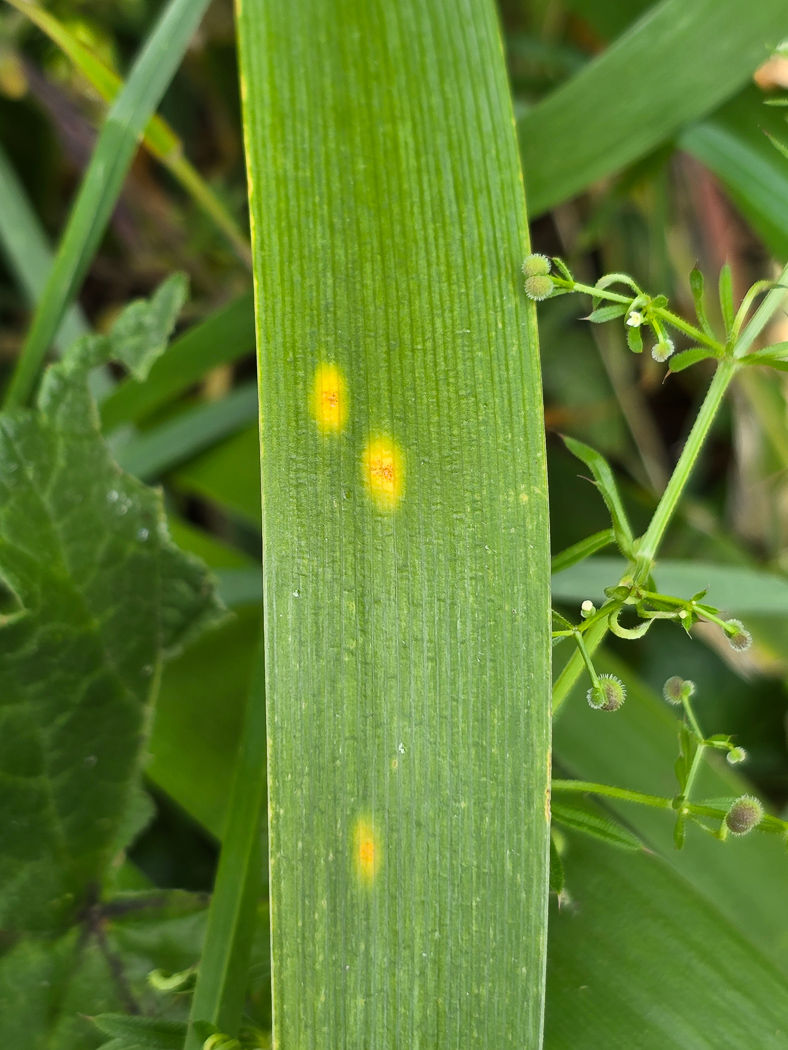 |
June 6th Puccinia iridis a species of rust with no English name Jesper Launder spotted this rust on the leaves of Iris foetidissima (Stinking Iris) in a roadside verge in Jordan Village. This species occurs on several species of Iris, having its initial stage on Urtica (Nettle). Though not at all rare we have only one previous Bucks record made by Derek in his Whitchurch garden in 1999, reflecting the lack of BFG recorders for such species. New find |
June 7th 2025
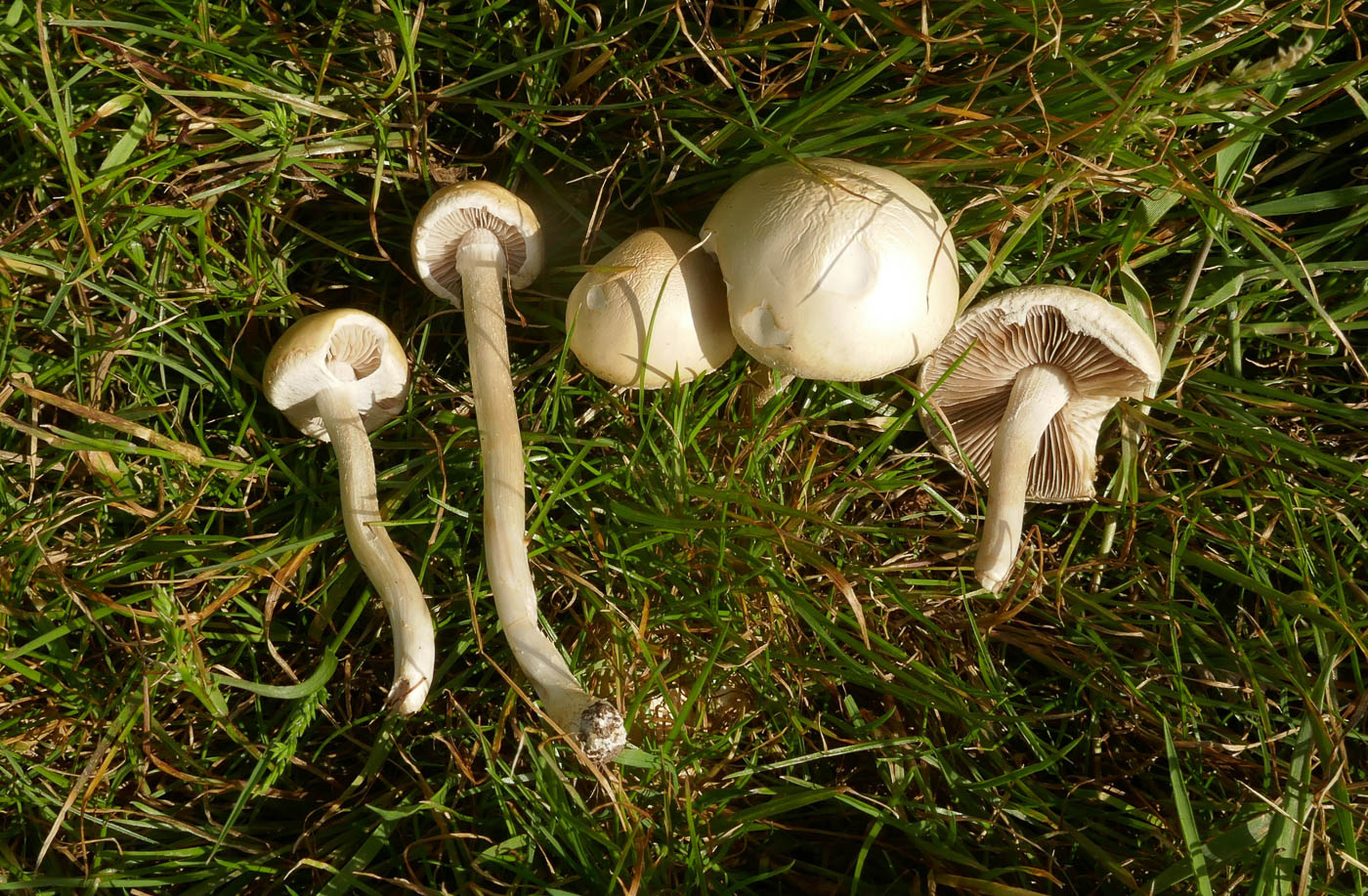 |
June 2nd Agrocybe molesta (Bearded Fieldcap) At Stampwell Farm Jackie Ewan noticed this summertime grassland species in a suitably grassy area and assumed at first that it was likely be one of the other two Agrocybe species which are often found here at this time, but checking later the larger spores eliminated A. praecox and the cap surface beginning to crack with clear hanging veil remnants eliminated A. pediades and pointed to A. molesta, found here also in 2022. We have plenty of county records ranging from May through to August and mainly found at Derek's previous home in Whitchurch where it was clearly a regular! Previous finds |
June 1st 2025
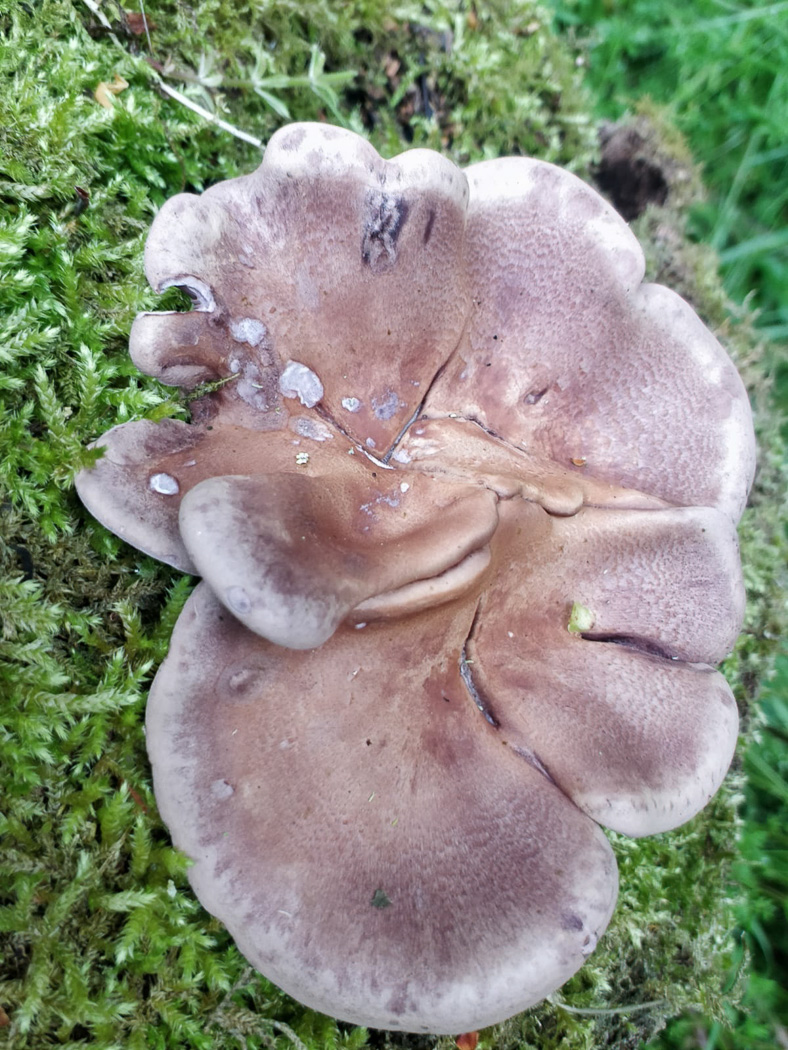
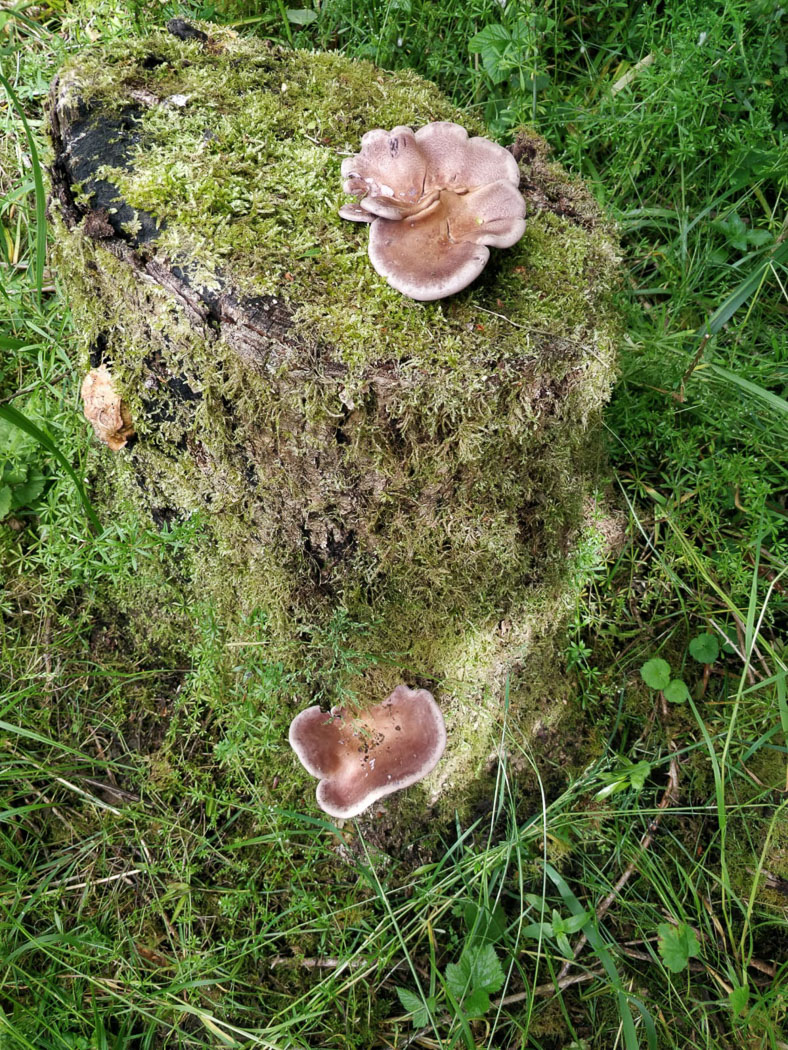
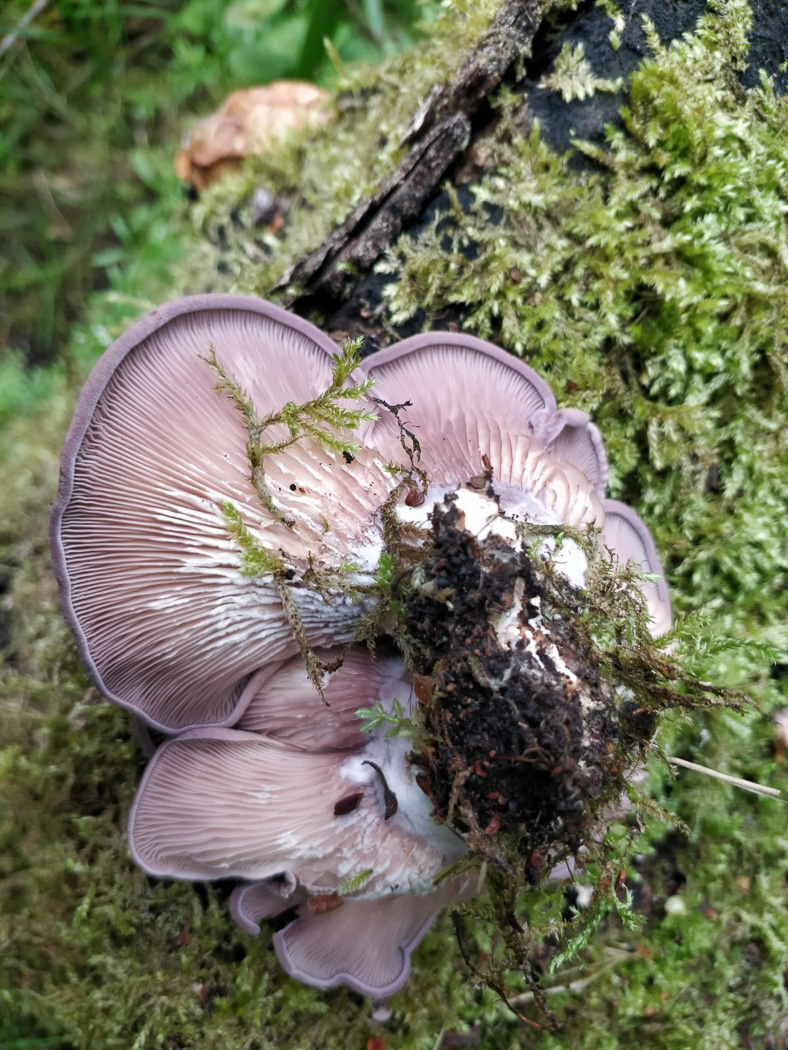
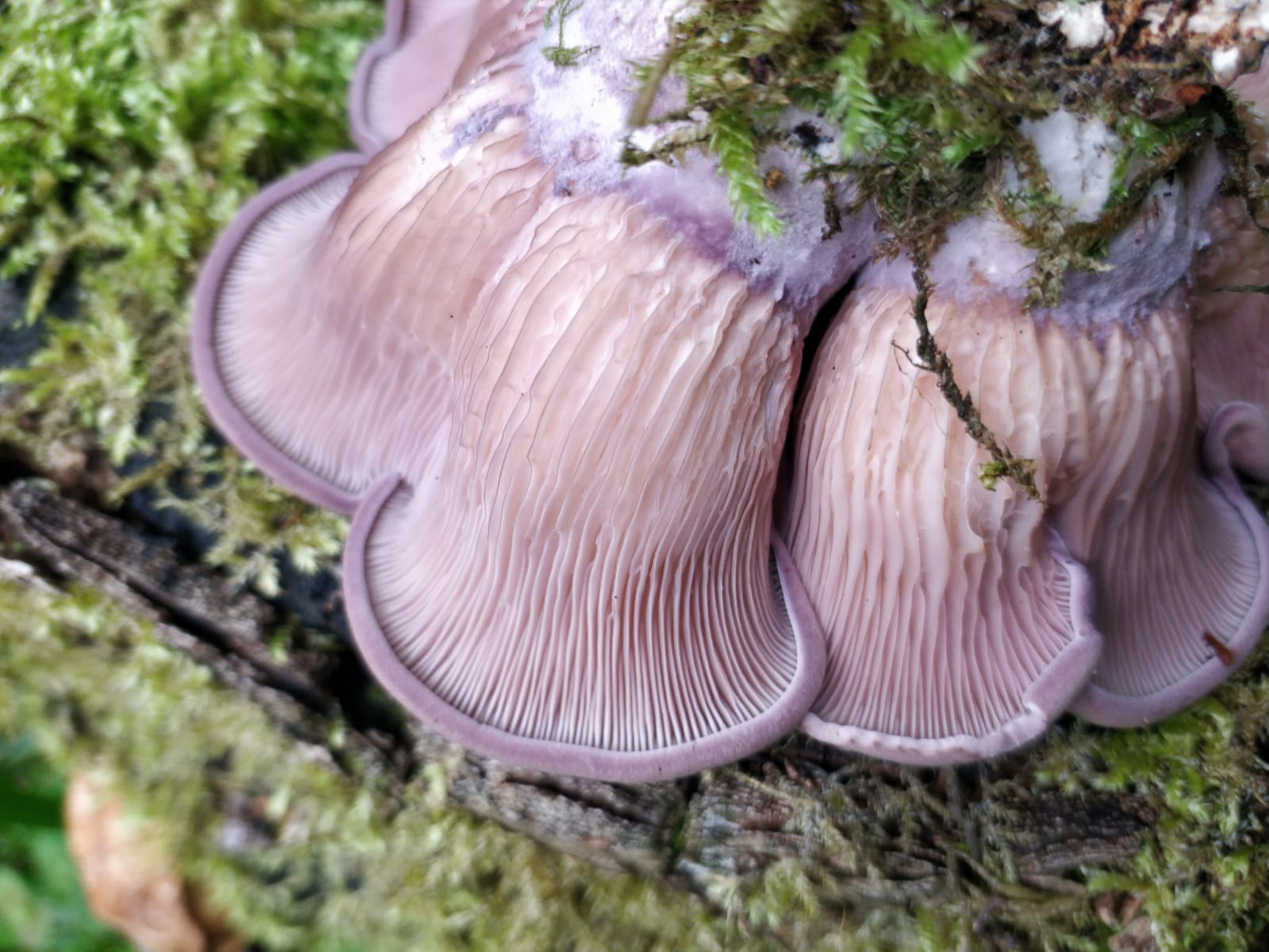 |
May 29th Panus conchatus (Lilac Oysterling) At last a nice fresh fungus as a result of much needed rain! Having found very little in the way of interest so far this spring in his Salden Wood, Bob Simpson was delighted to see this beautiful cluster growing on an old Ash stump. Its distinctive lilaceous colour together with typical 'oysterish' decurrent gills were enough to make his ID but he checked the spores from the white print the following morning which were a perfect match. We have just a handful of previous records though this is not considered a rare species but is certainly an attractive one. Previous finds |
 |
May 29th Bolbitius titubans (Yellow Fieldcap) At Stampwell Farm Jackie Ewan was not surprised to find this grassland species appreciating the recent rains. See previous finds for further info on the species. Previous finds |

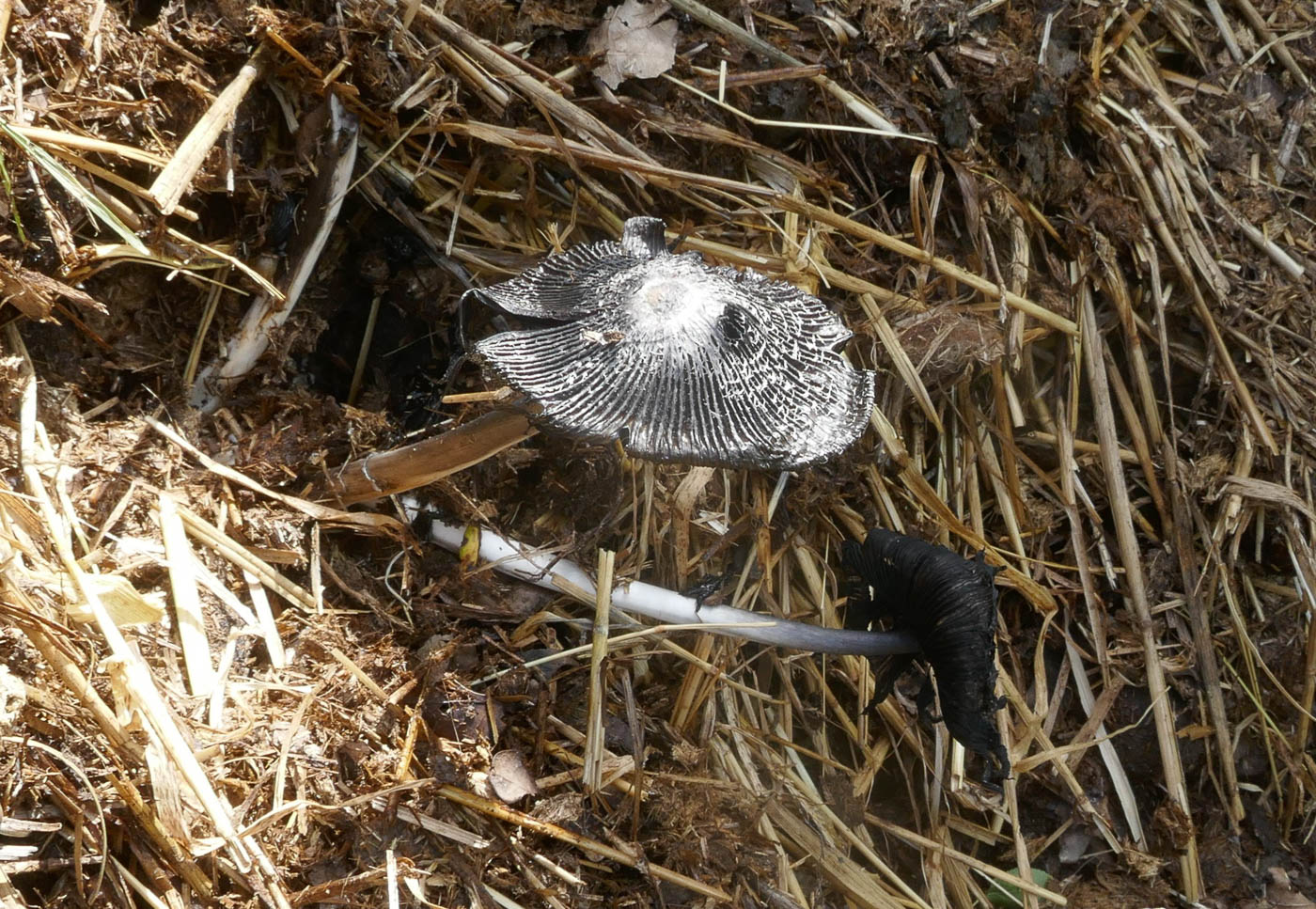
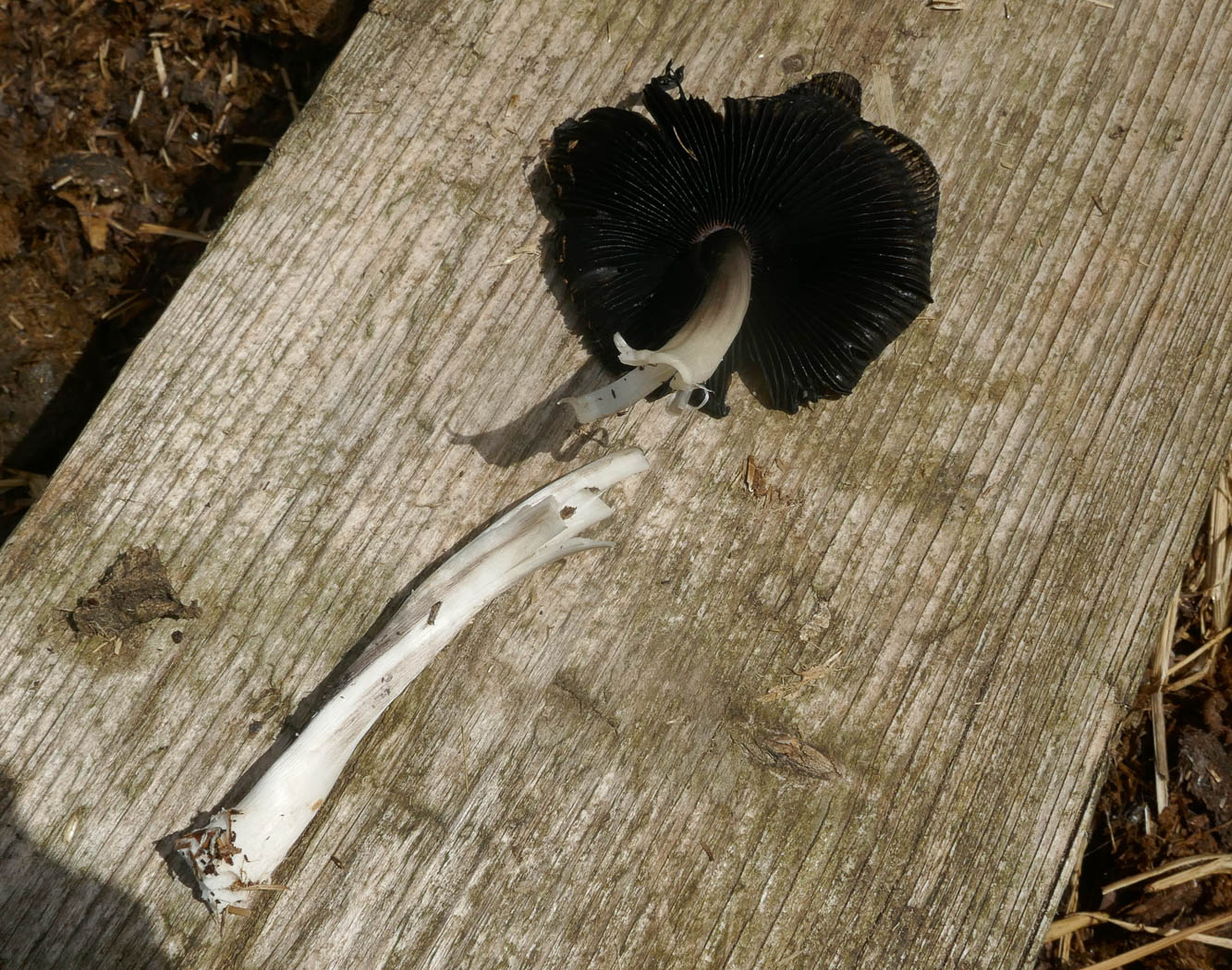 |
May 28th Coprinus sterquilinus (Midden Inkcap) After some much needed rain Jackie Ewan checked the dung heap at Stampwell Farm and was rewarded with this well developed Inkcap which looked unfamiliar. Checking the spores she found they were enormous compared to the commoner dung inhabiting species, also the cap surface was still slightly scaly rather than powdery so she knew she had something interesting. She sent it to Derek who identified it for her. This is not a common species with only around 50 records on FRDBI and a previous Bucks records from Burnham Beeches which is on Finds. So a nice find from Jackie. Previous finds |
May 25th 2025
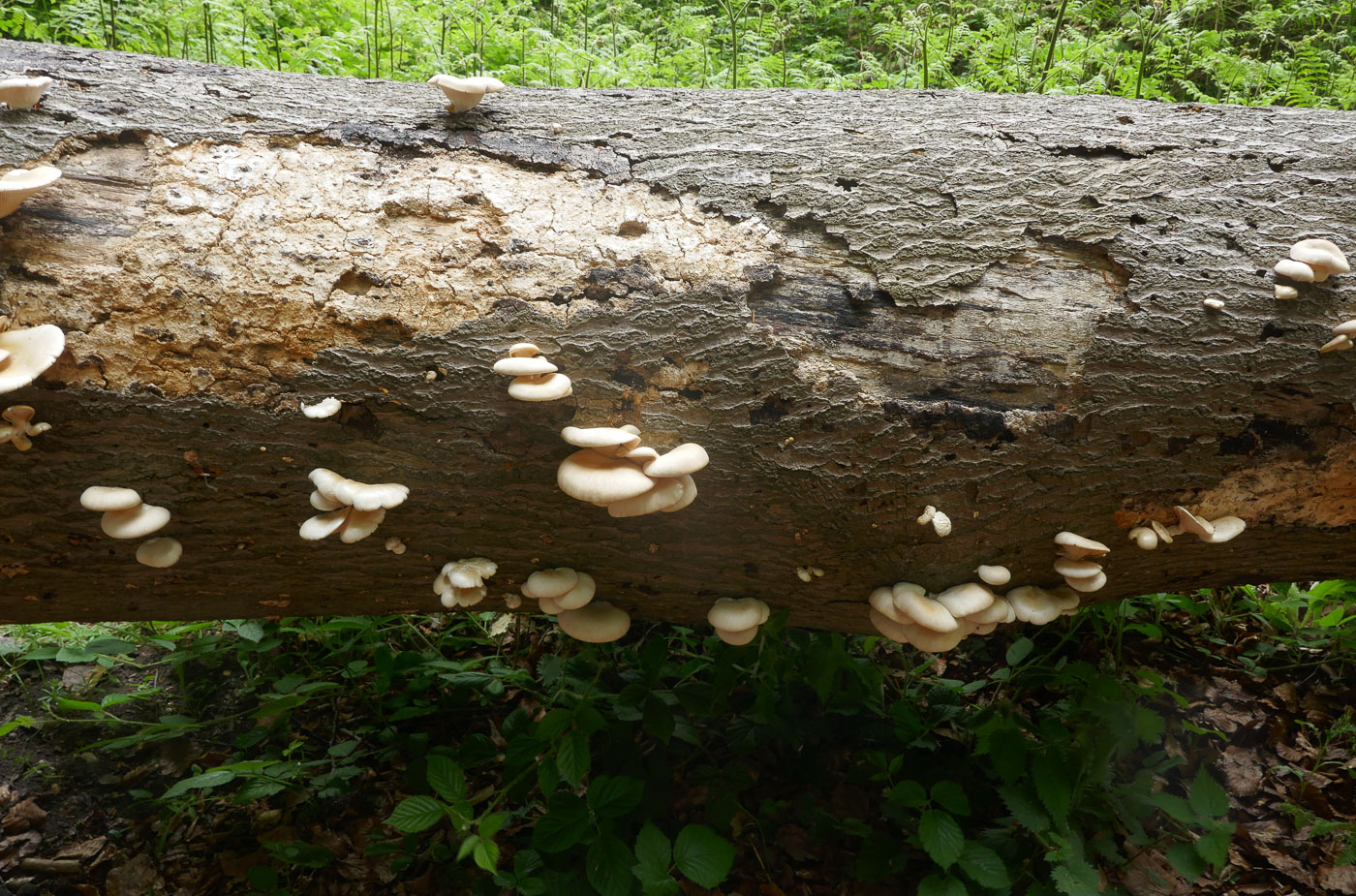
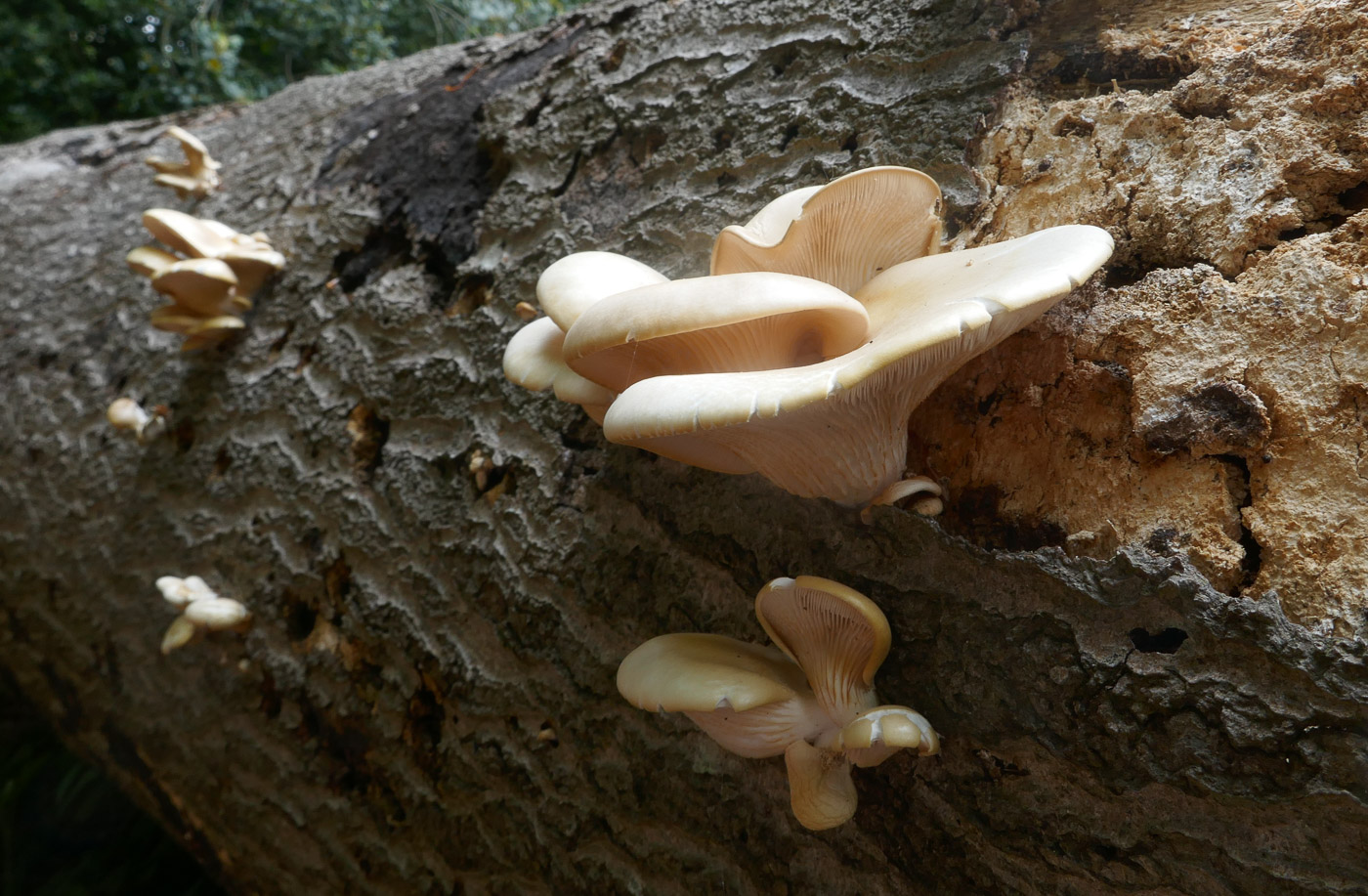
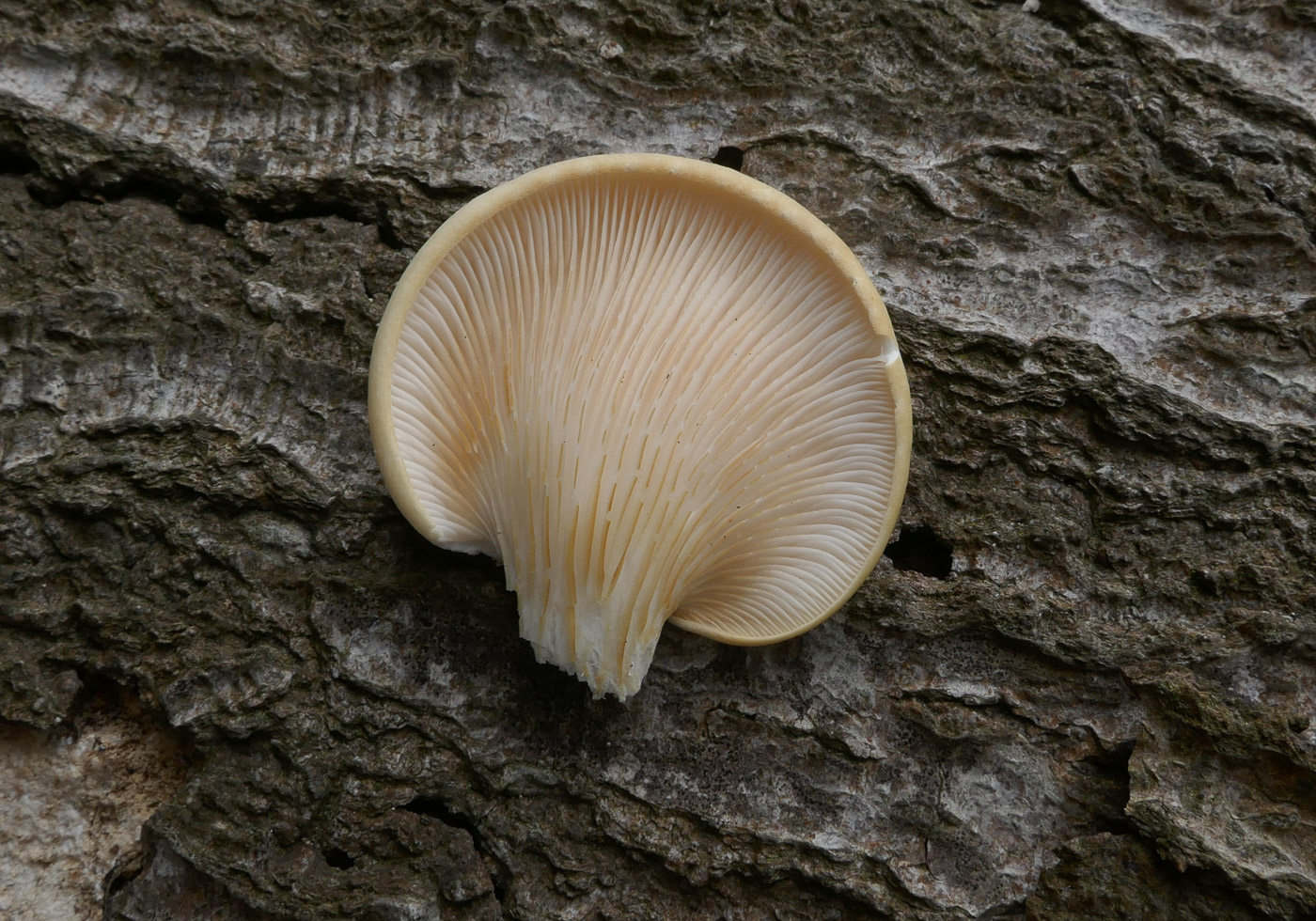 |
May 15th Pleurotus ostreatus (Oyster Mushroom) At Stampwell Farm Jackie Ewan came across this nice fresh crop on a fallen Beech trunk - and anything looking nice and fresh is a treat to see at the moment! At times of drought those species which grow in soil really struggle but those dependent on fallen wood thrive much better. Previous finds |
May 24th 2025
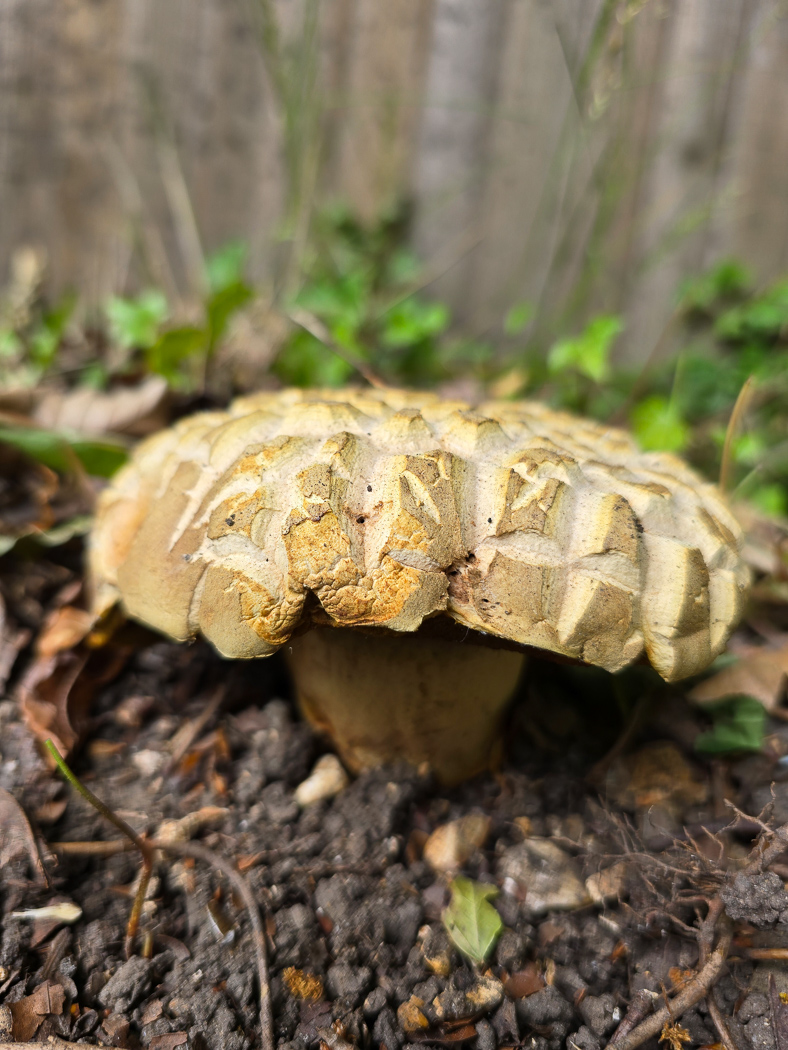
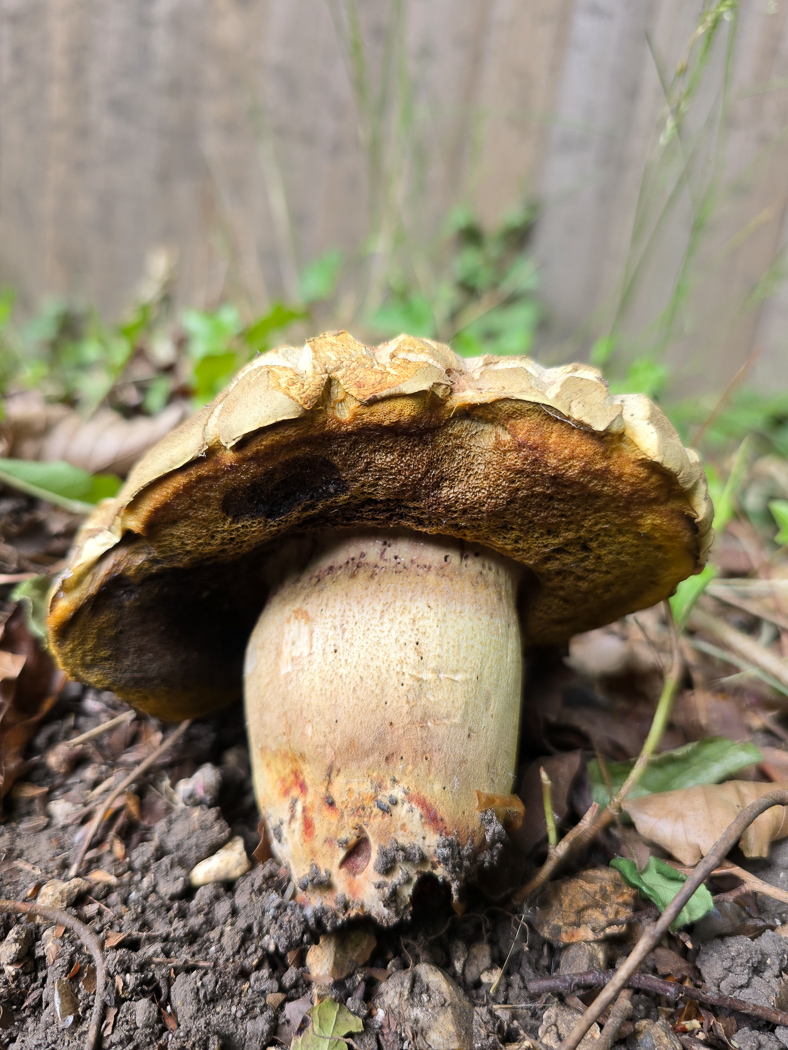 |
May 23rd Hemileccinum impolitum (Iodine Bolete) In Chalfont St. Peter Jesper Launder was astounded to come across this very early bolete which, though somewhat old and cracked, had somehow managed to force its way through the baked dry soil relatively unscathed. The species favours Oak and is one which has fine yellow pores which don't stain blue when pressed or damaged, but the most significant field character is its strong smell of iodine (hence its English name) best detected at the stem base and which Jesper noted was very evident today. Previous finds |
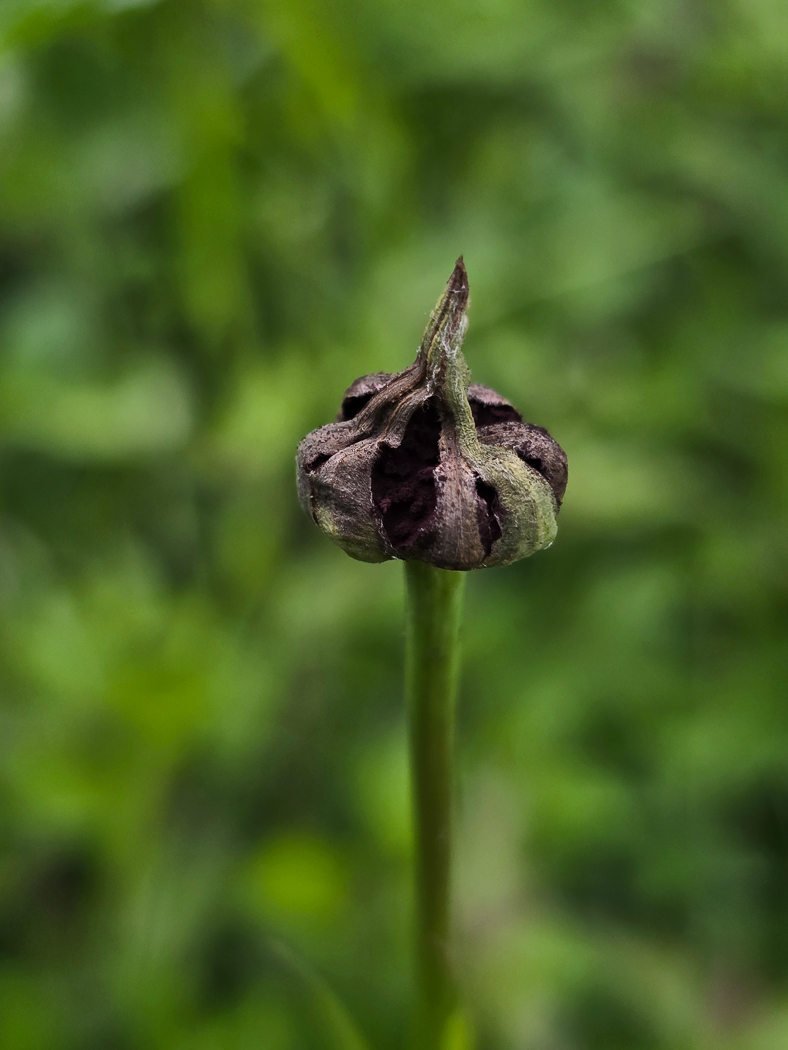 |
May 22nd Microbotryum tragopogonis-pratensis (Goatsbeard Smut) Jesper Launder, whilst visiting Homefield Wood to enjoy the orchids, found this unusual smut species - a plant parasite - strongly affecting the flower development of Tragopogon pratensis (Meadow Salsify or Goatsbeard). This was a new species to him despite the fact that he has a particular interest in such species, and can apparently affect both T. pratensis and porrifolius (Common Salsify) in May and June. Penny found that under its previous genus name, Ustilago, we have just one previous county record dating from 1990 when identified by Elizabeth Mordue, a recognised authority on rusts and smuts so the record is not to be discounted despite it being 35 years ago! This was a nice find. New find |
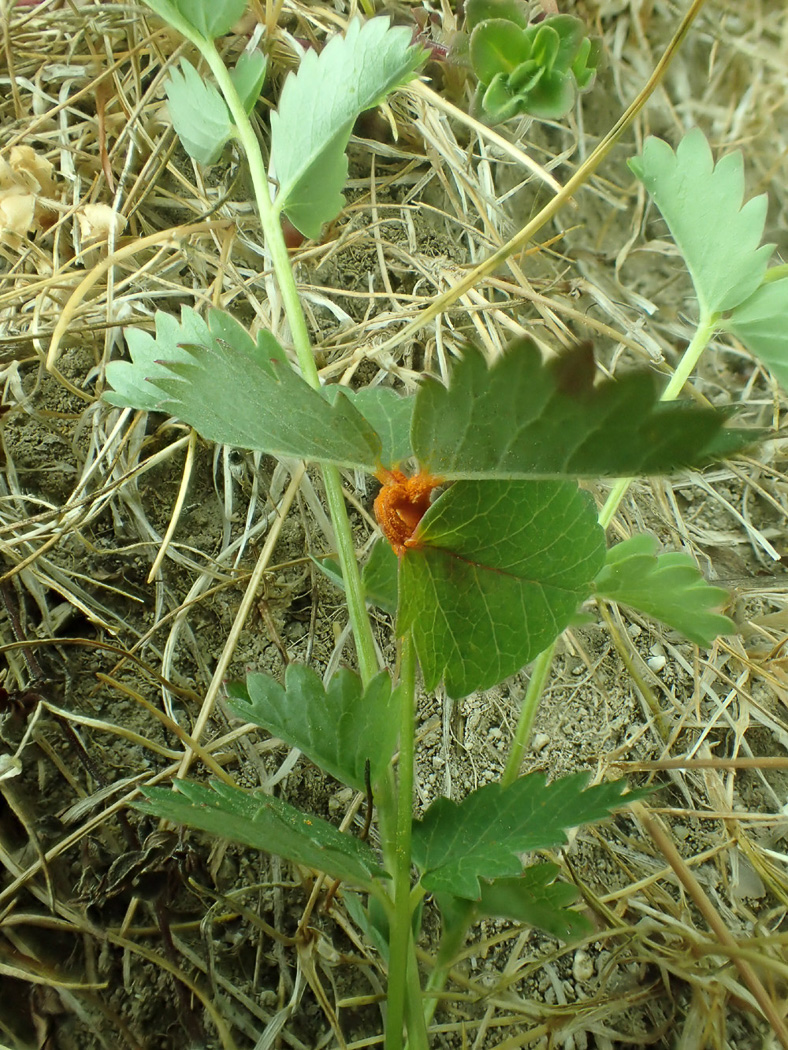
 |
May 22nd Phragmidium sanguisorbae (Salad Burnet Rust) Sarah Ebdon, whilst visiting Homefield Wood to enjoy the orchids, found this rust species which is host specific to Sanguisorba minor (Salad Burnet). This was a new Finds entry in 2024 when she discovered it at this same site just a week later in the year. See the notes on that entry for a little more about the species. Previous finds |
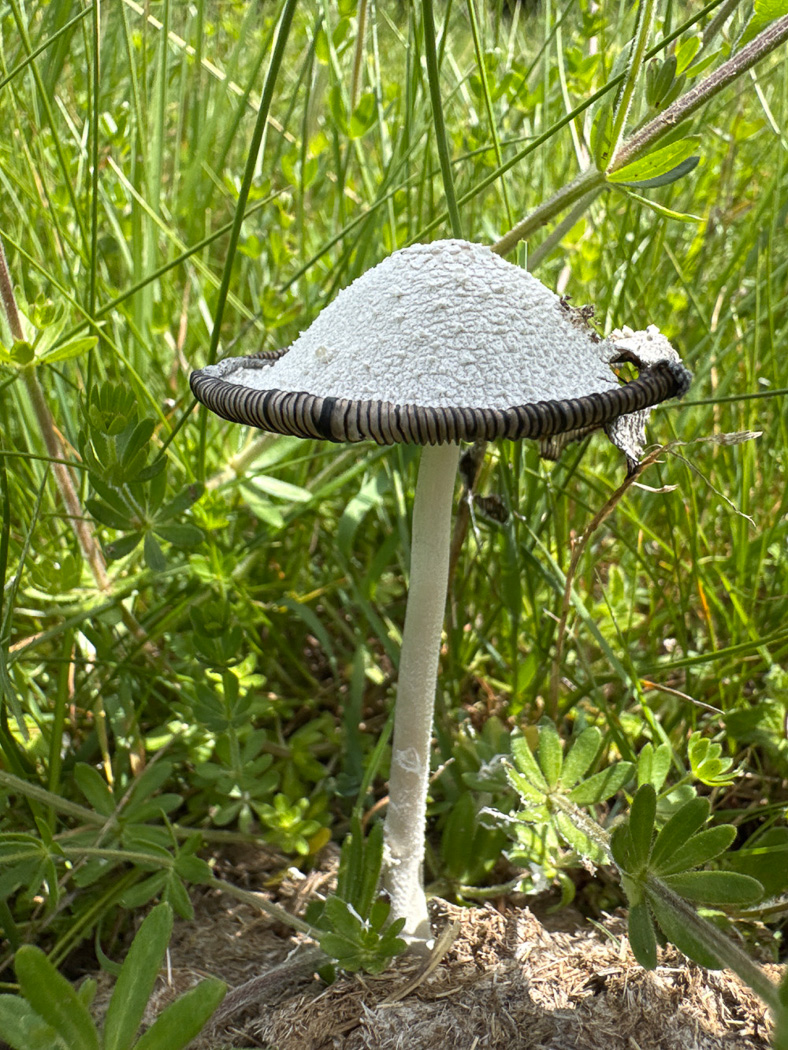
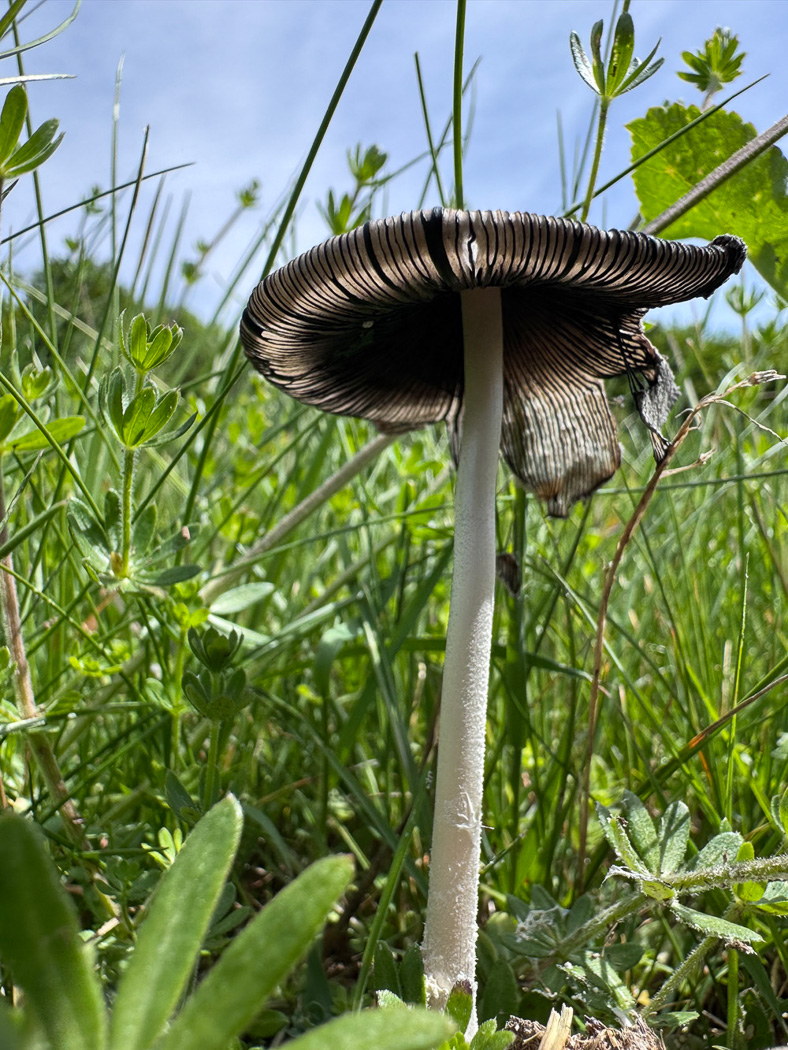 |
May 20th Coprinopsis nivea (Snowy Inkcap) When visiting Yoesden Bank, a BBOWT Reserve near Bledlow Ridge, Jackie Newcombe was surprised to find this Inkcap growing on some very desiccated cow dung. She reports it was a good size, 8cm tall, with a pure white cap, the stem covered in powdery, cottony fibrils and the rim of the conical cap had curled up to reveal the typical dark brown gills. Penny confirmed her ID from the photos and then discovered that though not rare this appears to be a new entry for Finds. It's worth comparing the species with the less common C. pseudonivea, a very similar dung species but which has a pinkish flush to the cap when young rather than pure white of C. nivea. New find |
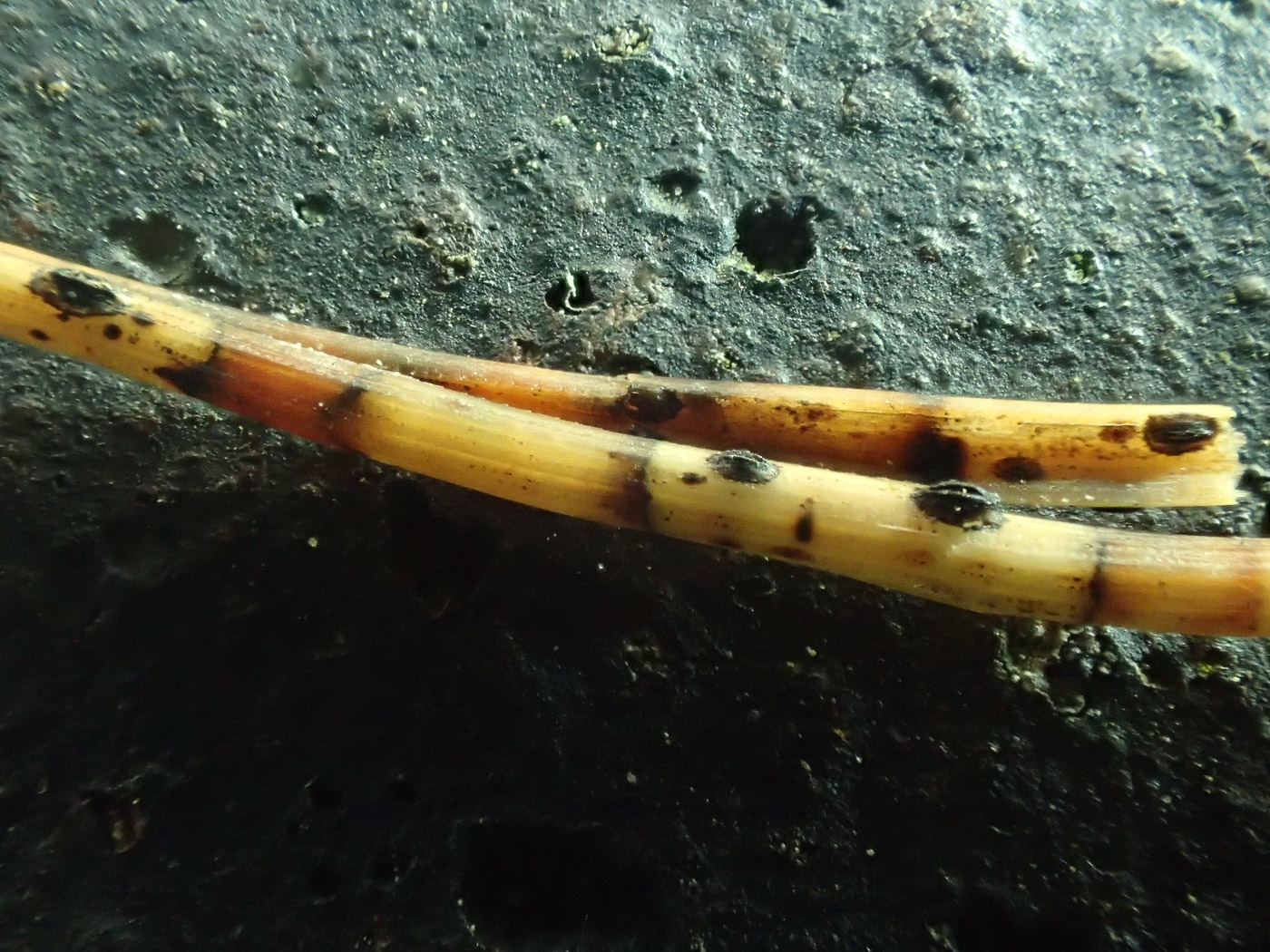
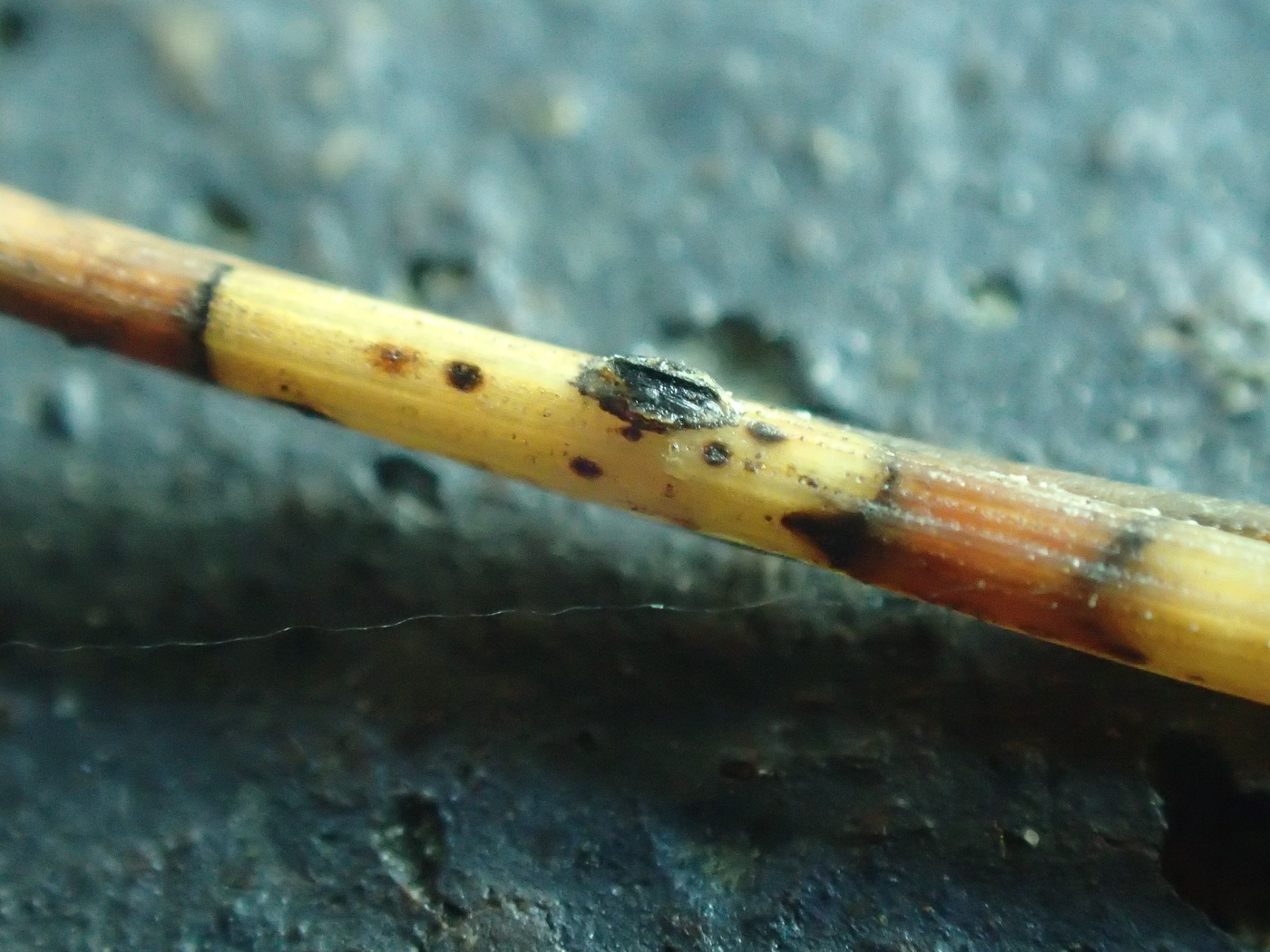 |
May 18th Lophodermium pinastri (Pine Needle Split) At Burnham Beeches this species, found by Sarah Ebdon on our BFG Walk, didn't make it onto Penny's list but is worth including here as it is a new species for Finds and we apparently have no records of it since 2014 though it is described as very common. It occurs exclusively on fallen Pine needles or cones, looking like tiny raised oblong black 'lips' dotted along the needle, though there are many similar species in the genus which occur on other substrates. New find |
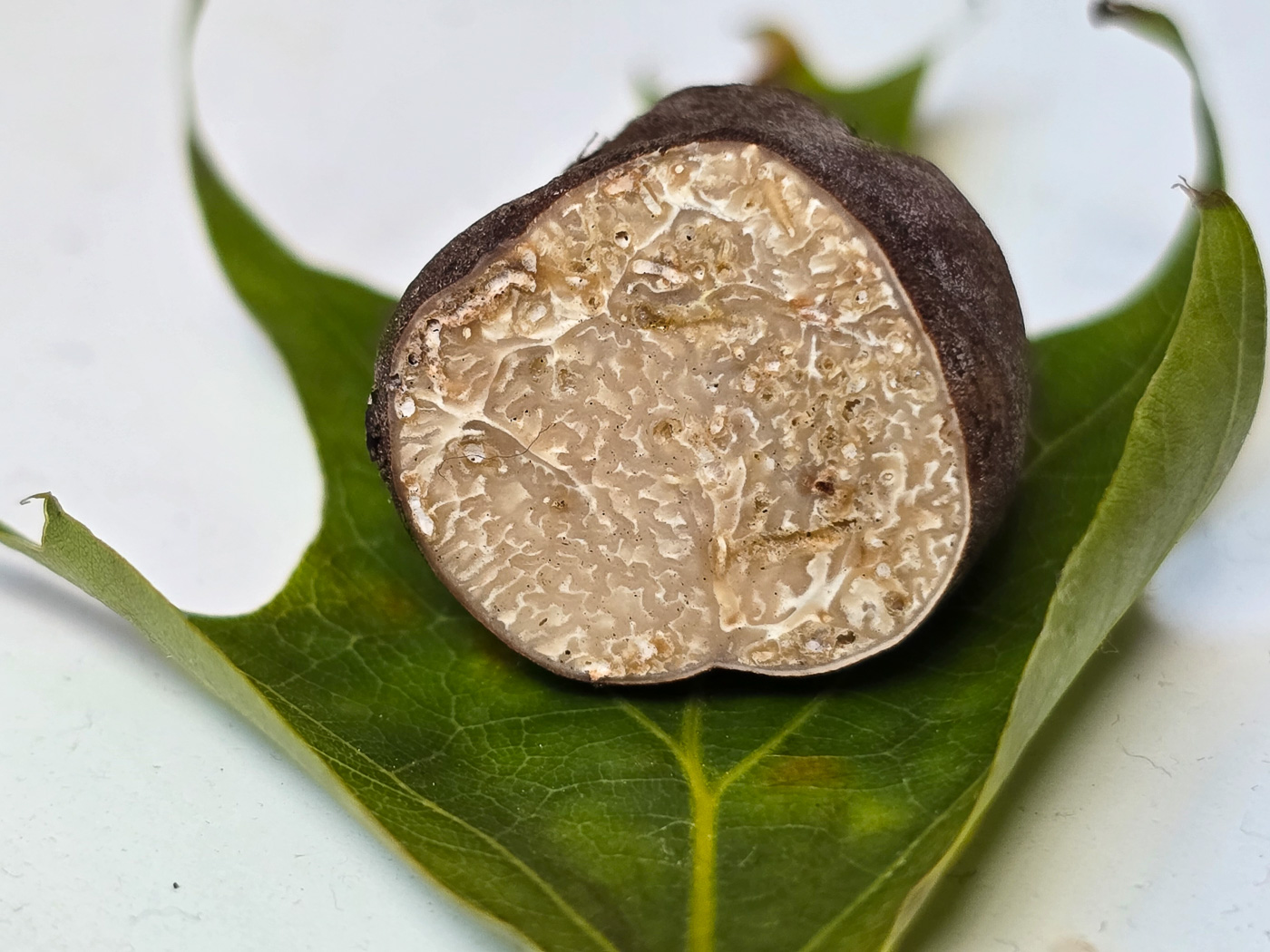 |
May 18th Tuber rufum (Red Truffle) In a lawn under a Red Oak in Chalfont St. Peter Jesper Launder uncovered this truffle, one which he seems to find fairly regularly now in early summer though his last find was earlier this year in February. It is described as occurring mainly in late summer and autumn (under a range of trees, both deciduous and conifer) but records from this period seem less frequent - maybe because the main focus is then on above ground fungi! Previous finds |
 |
May 18th Hydnotrya tulasnei (Red Fold Truffle) Jesper Launder paid a visit to one of his favourite truffle spots, under an Oak in Little Chalfont, and was rewarded with a rare species he found here new to the county last June. (See the notes on that entry for more about its rarity.) The genus name apparently stems from the Greek for truffle: Hydnon - though Penny doesn't follow the link from this stem to those hydnoid basidiomycetes which are above ground with spines rather than gills?! This is one of the 'true' truffles, ie ascomycetes (the 'false' truffles being basidiomycetes) and is separated microscopically from the other three species in the genus by its virtually round spores housed within an ascus which can be either conventionally shaped - like a sausage - or irregularly sacate - rounder. Luckily, as today's specimen failed to yield useful microscopic detail, Jesper was from experience able to identify it securely from its macro-characters. It can apparently occur under a range of different trees, both deciduous and conifer. Previous finds |
May 13th 2025
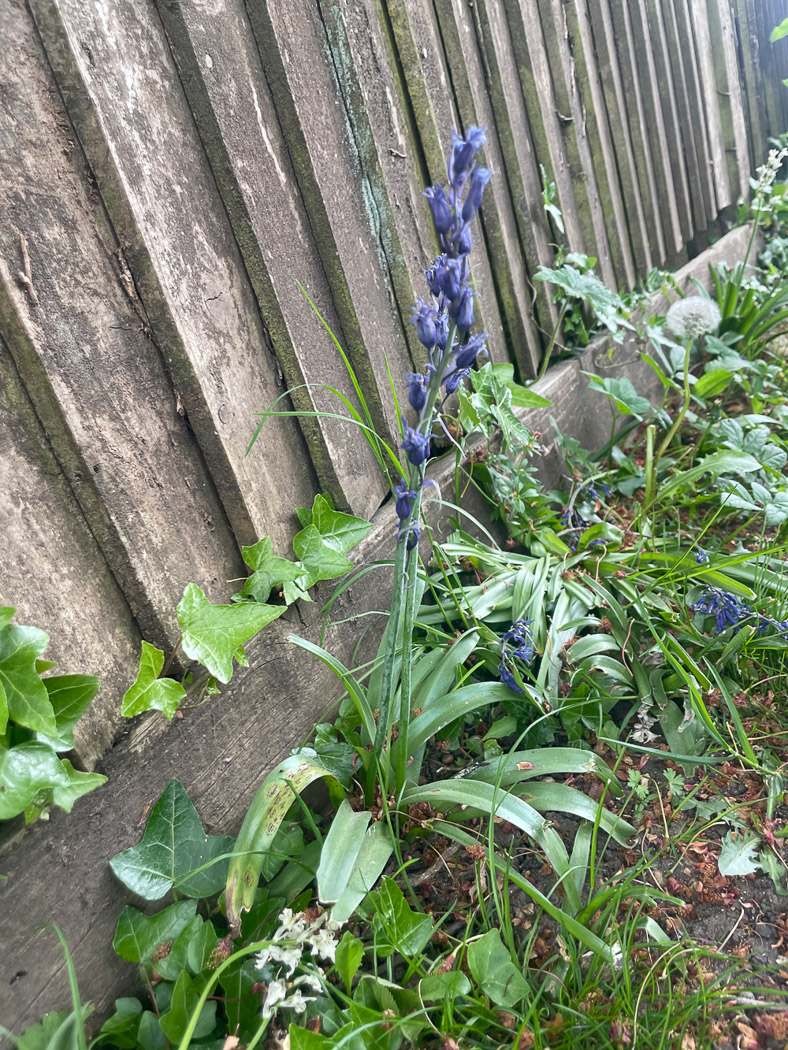
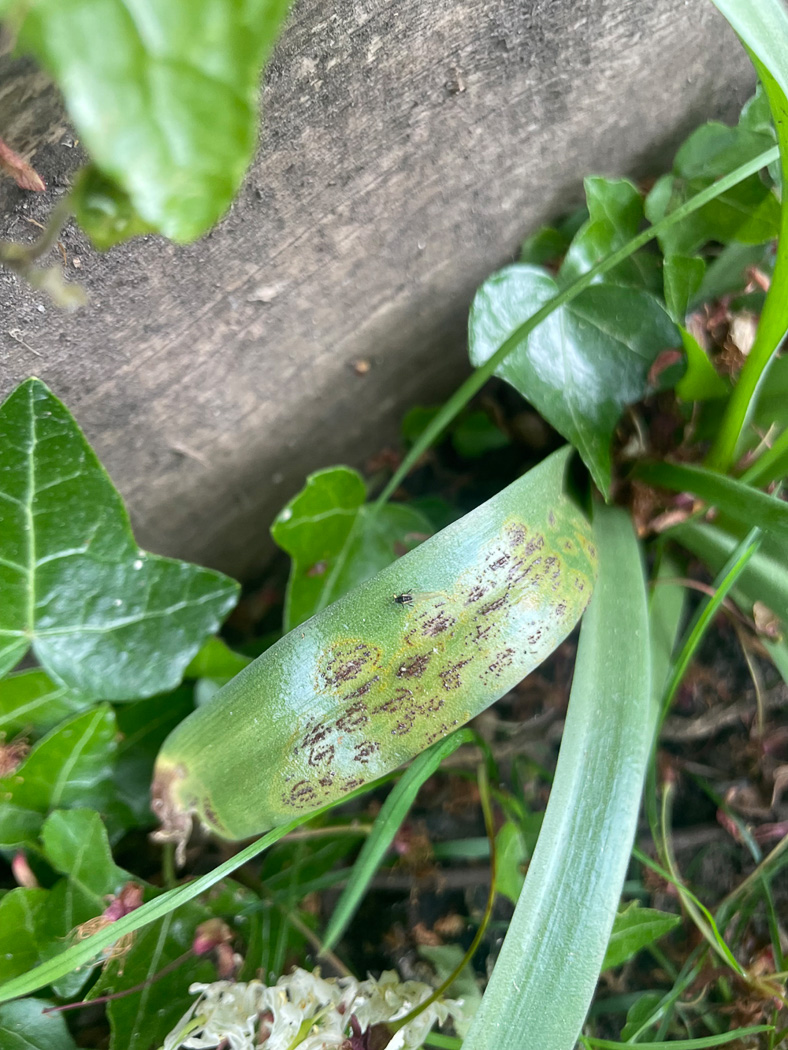 |
May 8th Uromyces muscari (Bluebell Rust) This is a species Sarah Ebdon found for the first time last spring, and has therefore been on the lookout for. After many recent unsuccessful searches she eventually found it on a native bluebell near a fence in the Amersham area. (Apologies here for a non fungal point of interest: there is often discussion about the detrimental effect the non-native 'Spanish Bluebell' might be having on our native Hyacinthoides non-scripta, but a recent paper has in fact proved otherwise. If interested, click here for more information.) Previous finds |
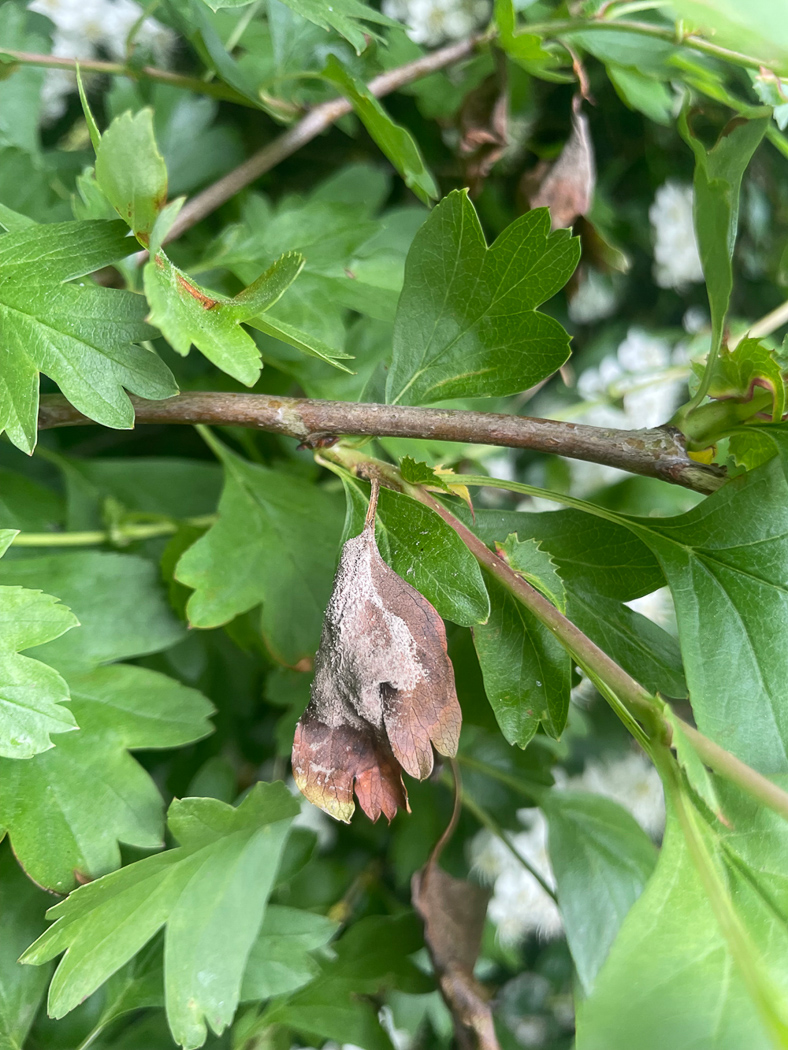 |
May 3rd Monilinia johnsonii (Haw Goblet) Whilst walking near Woodrow Sarah Ebdon smelt a familiar sickly sweet but unpleasant smell which rang a bell! This was from a small fungus which she'd come across last spring and which causes Leaf blight in Hawthorn at this time, the smell of which is thought to mimic that of Hawthorn blossom in order to attract insects. In autumn one can find the small stemmed cups of a further stage of this fungus on the fallen haws. Sarah recognised the smell instantly because though reportedly fragrant and possibly with a Germolene component(!) she actually finds it quite stomach churning! From her reaction to the smell she knew there must be Hawthorn close by, then discovered a bush in the hedge some 20 odd paces behind her, and sure enough there were just a few affected leaves! Previous finds |
May 12th 2025
|
|
May 10th Morchella elata (Black Morel) Jesper Launder was amazed to spot the distinctive shape of these beauties in a mulched flowerbed in the outskirts of Beaconsfield. How they should be managing to fruit so late in spring despite the unfavourably dry conditions over the last month or more is remarkable. All our handful of county records were found in April, the latest being the 23rd, though checking in FRDBI there are a smattering of May records though the vast majority are from March and April so it's not that unusual. But what is surprising is that they should find enough moisture at the moment when fruitbodies of any kind have been conspicuous by their absence. Jesper suggests that the shade from a nearby Beech together maybe with some artificial watering of the bed could be responsible. Whatever the reason, it was a nice surprise! Previous finds |
May 11th 2025
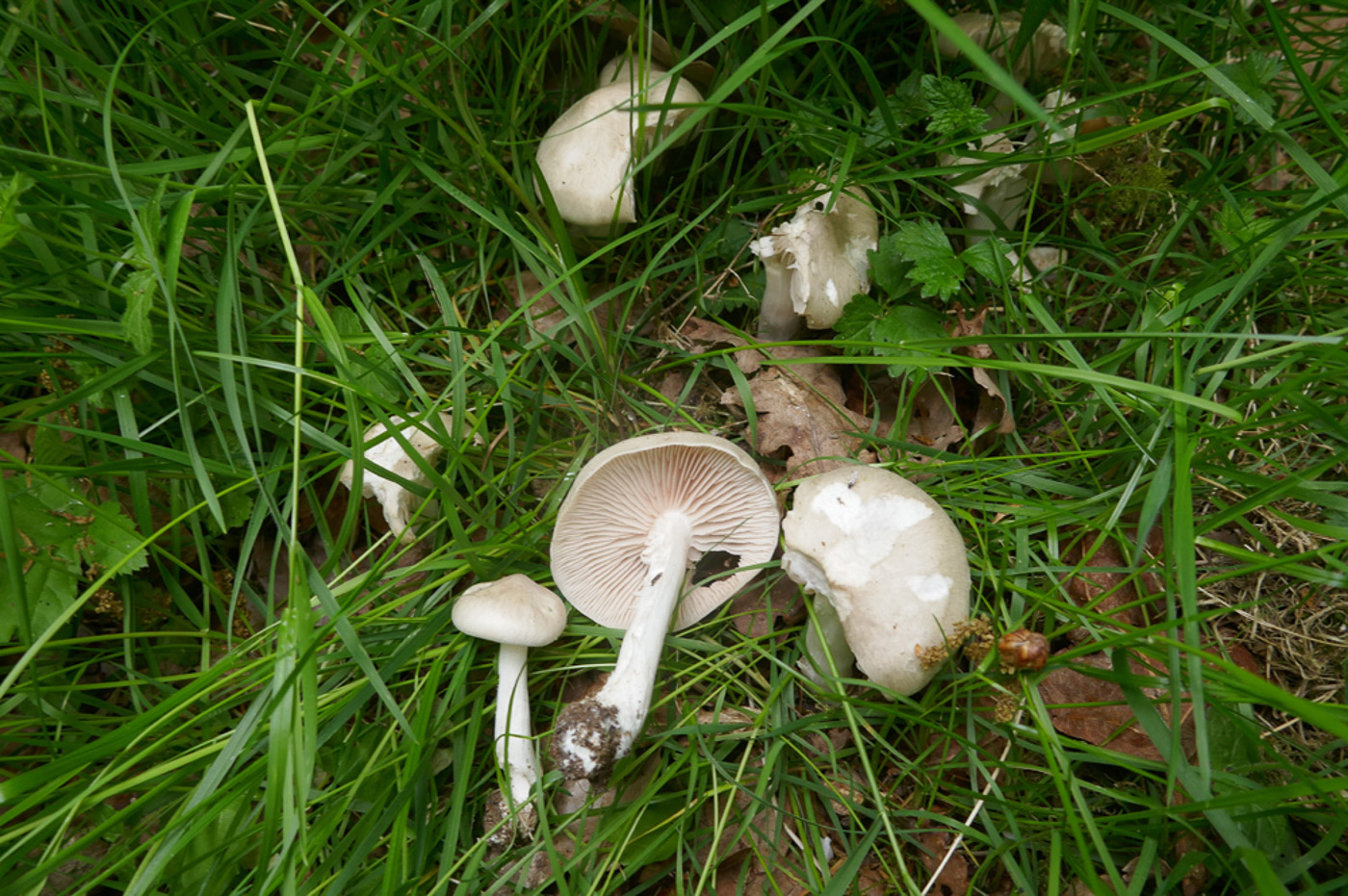
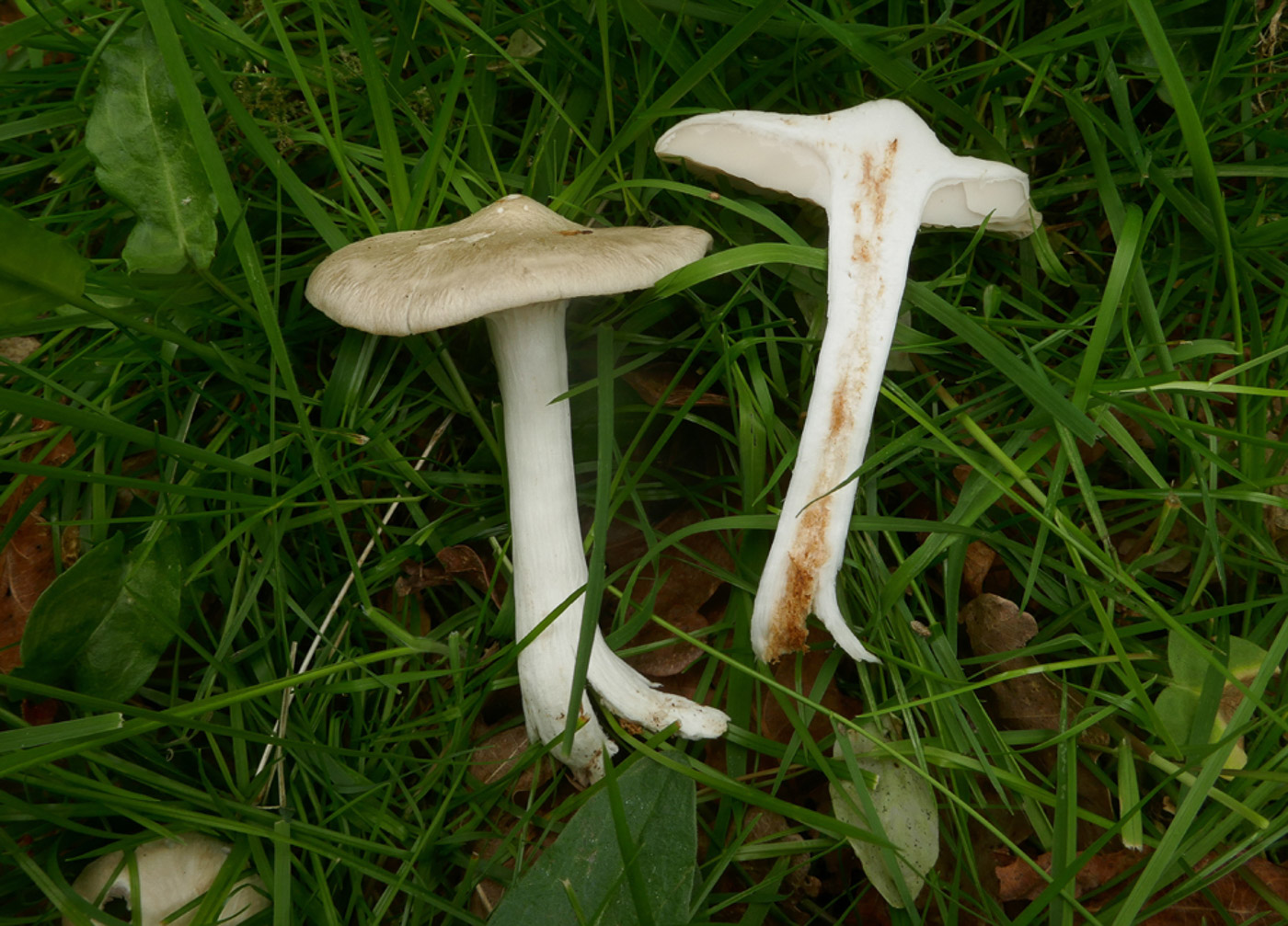
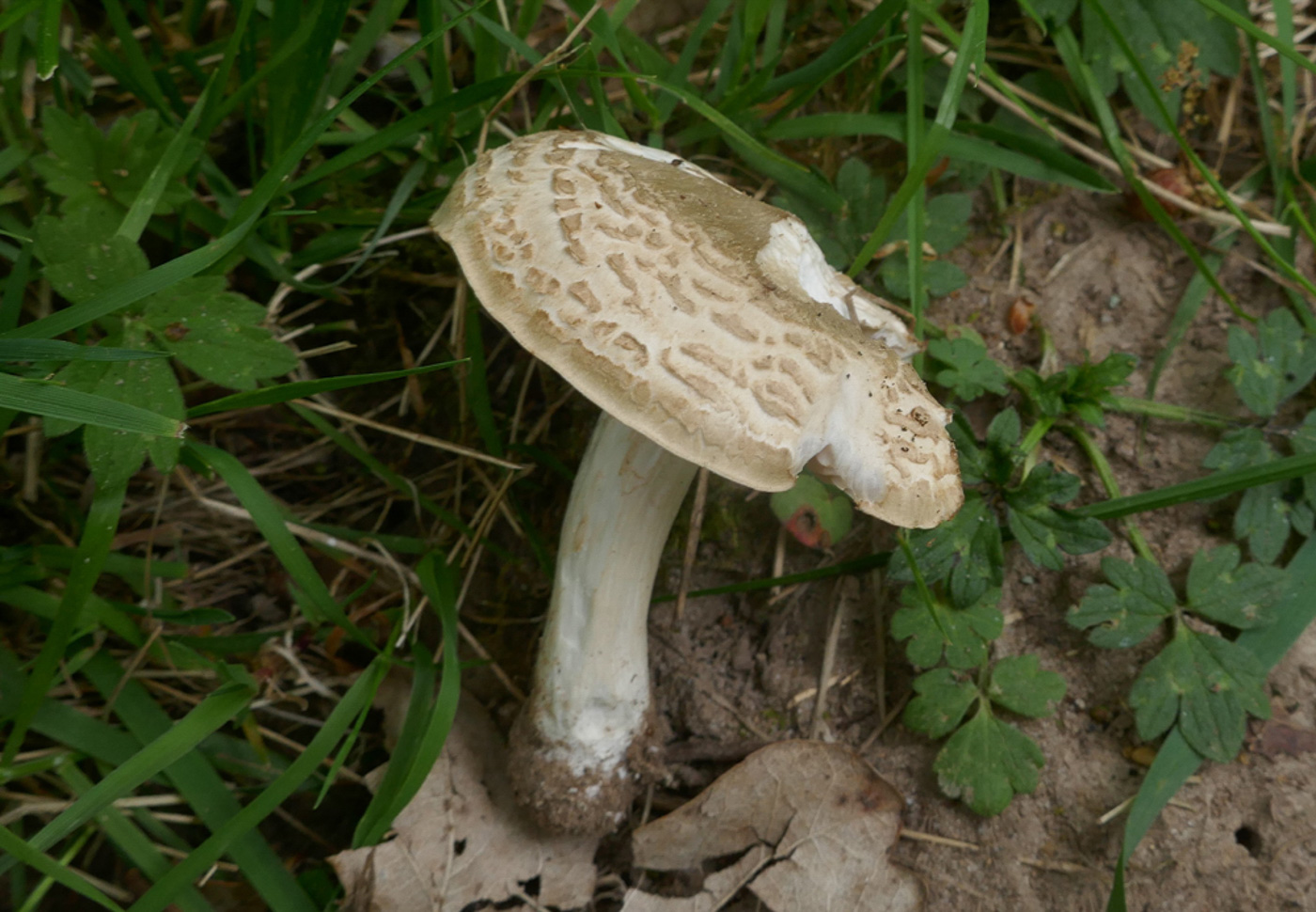 |
May 6th Entoloma clypeatum (Shield Pinkgill) At Stampwell Farm Jackie Ewan was please to find this species beginning to fruit under the Plum suckers in a grassy spot where she's found it for several years at this time. This is quite a sizeable Pinkgill which favours Prunus and occurs in late spring so its timing is spot on here. Note how one of the caps looks unusually broken up and cracked making it more like perhaps an Agrocybe - no doubt as a result of exposure to the hot sun. Previous finds |
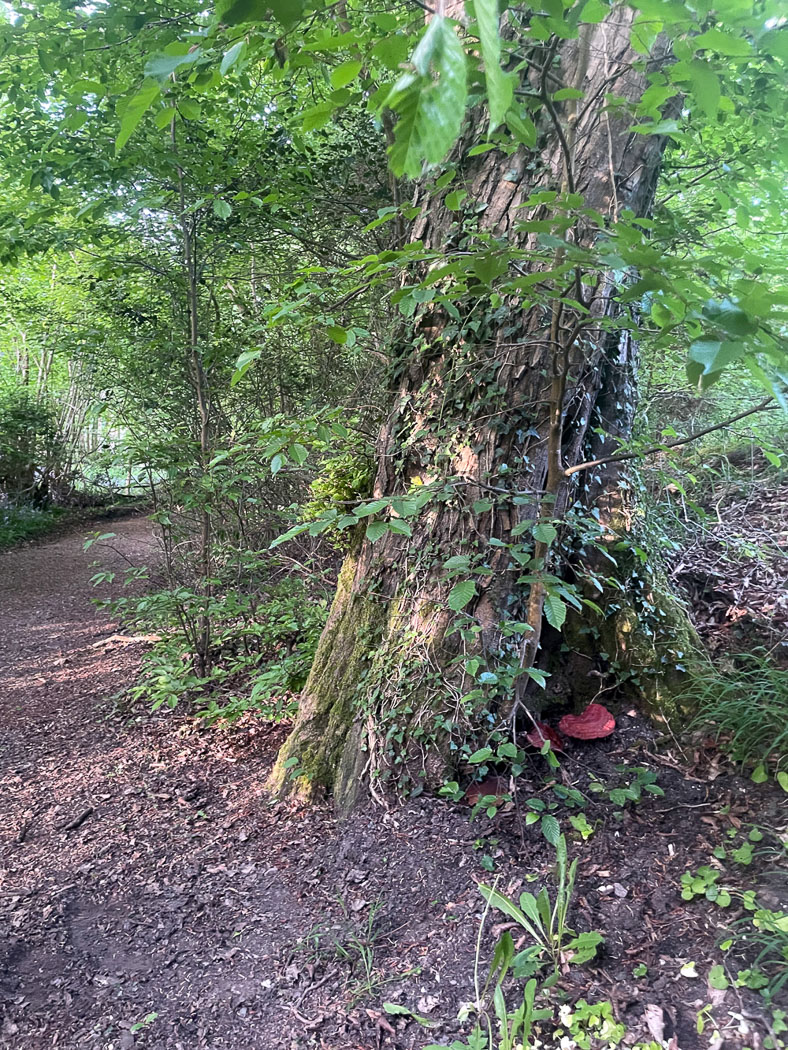
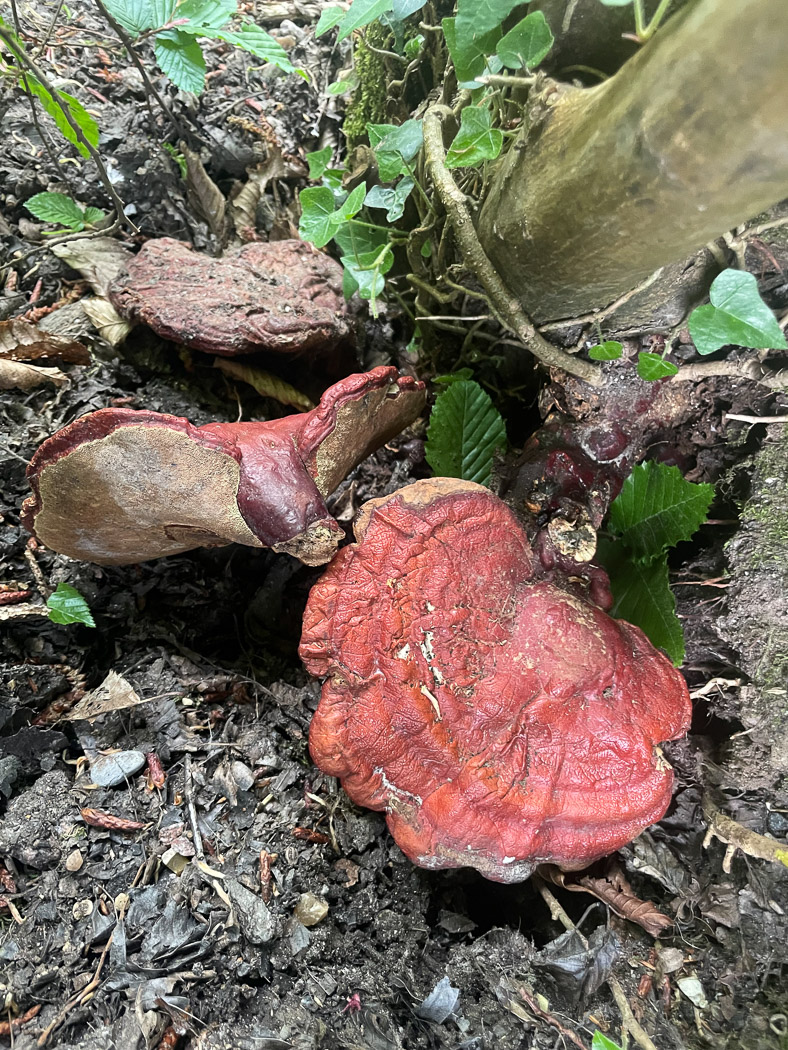
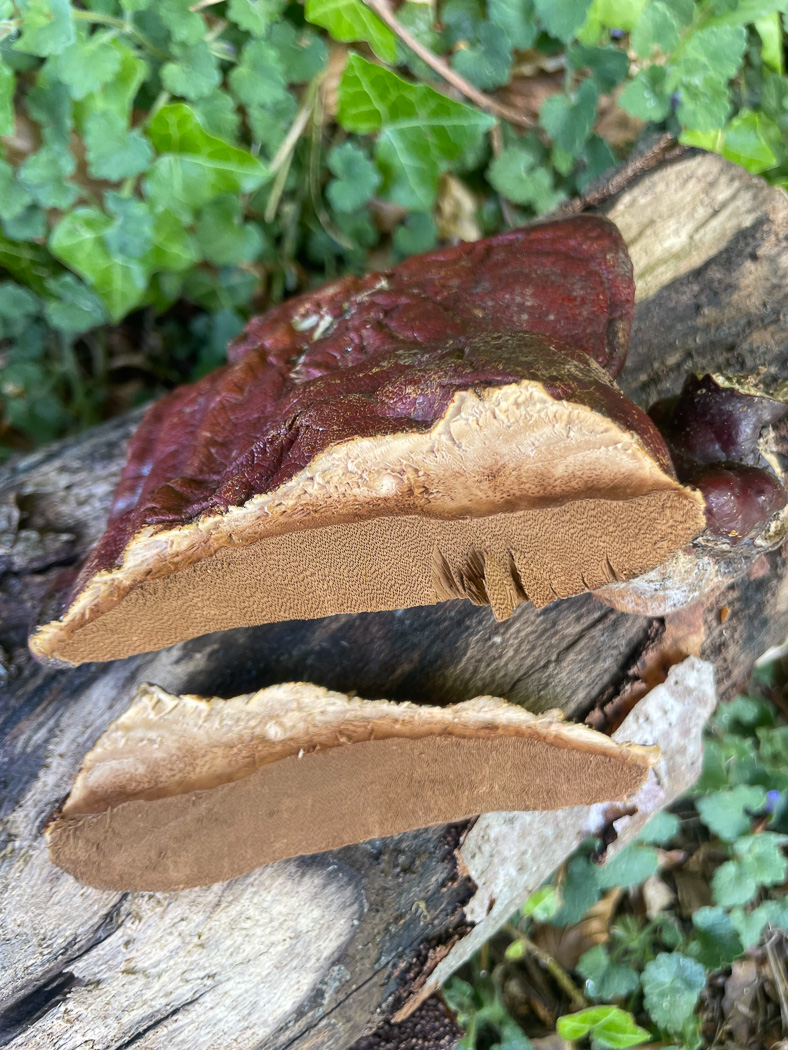 |
May 6th Ganoderma cf. resinaceum (a bracket with no English name) Near Gt. Missenden Sarah Ebdon found this smart pair of brackets at the foot of a Hornbeam, and recognising that from its reddish colour and also notable stem it was probably an interesting species of Ganoderma she collected one to check later. The reason for the 'cf' in the name here is that she found some conflicting characters which made it tricky to be confident whether this was G. resinaceum or the rarer G. lucidum (Lacquered Bracket). G. lucidum is known to be the species within this genus which has a distinct stem, therefore this collection fitted that particular to a T; however, Sarah found not only that the spores seemed a better fit for G. resinaceum but also the dark line she found within the context (see photo 4) when cut open together with the possible slight bubbling of the upper surface when put near a flame were not characteristic of G. lucidum. From its appearance both Penny and Derek are leaning towards G. lucidum, so a sample will be sent for sequencing which we hope will resolve the matter. Watch this space! Also now see the entry for Ganoderma cf lucidum dated August 13th where this story is continued ...................... Previous finds |
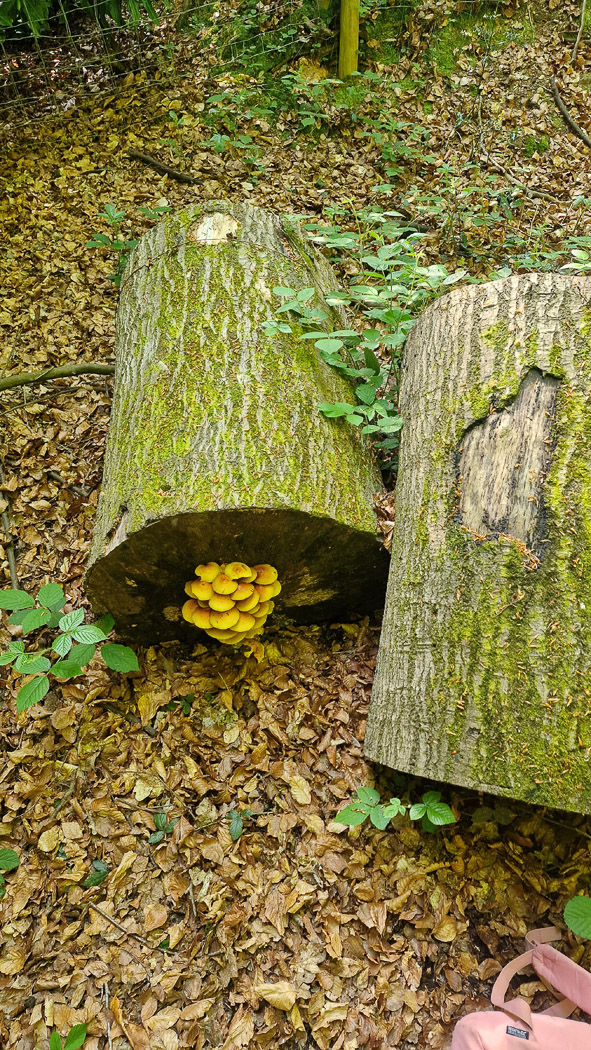
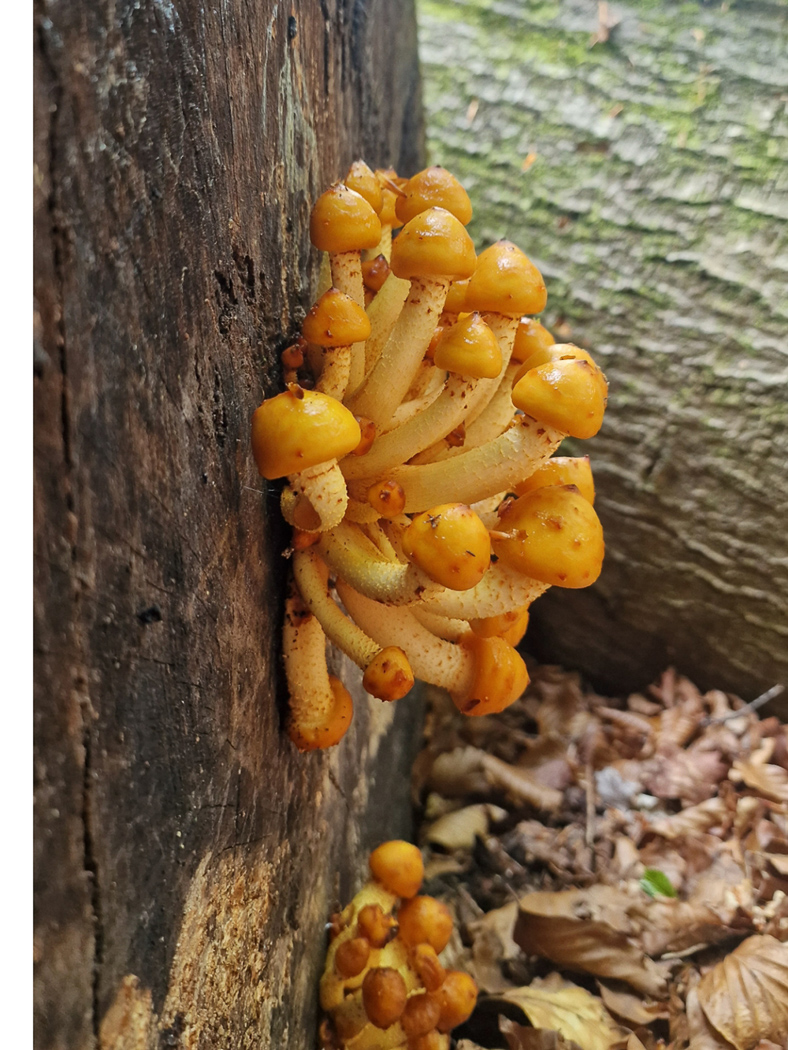

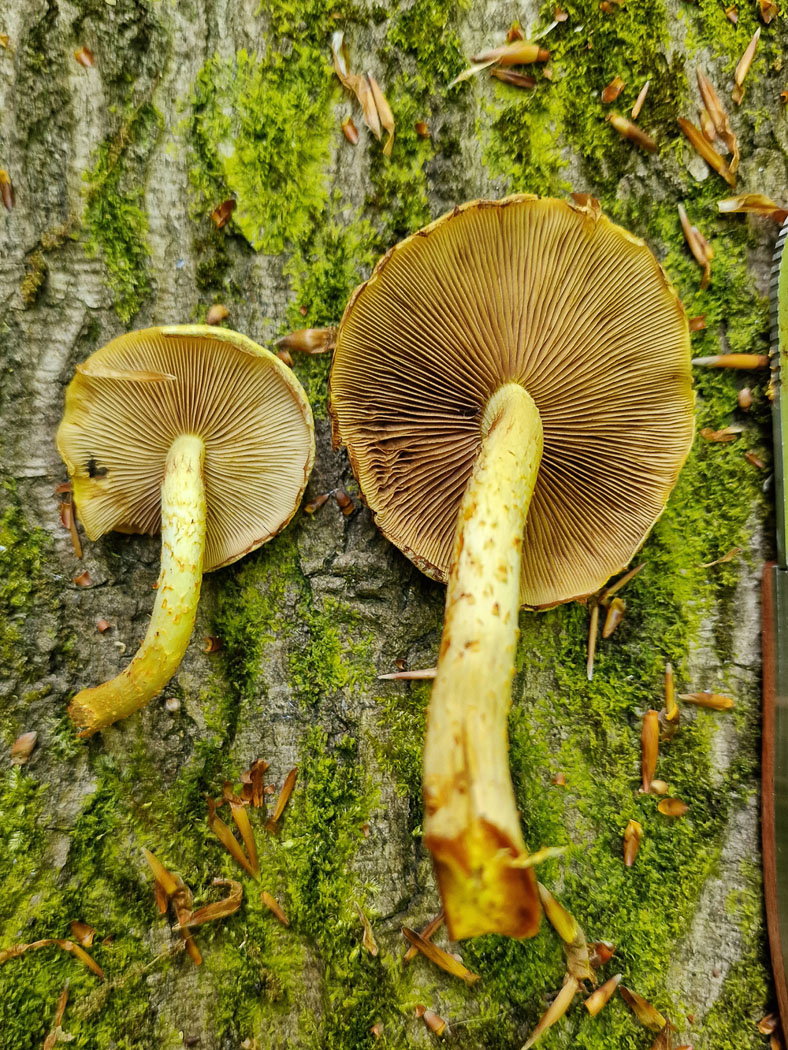 |
April 27 Pholiota adiposa (a species of Scalycap with no English name) Lisa Rock was walking in Lower Woodend (nr Marlow) and her attention was drawn to this stunning tight cluster just forming on the sawn off end of a Beech log. She returned a few days later when the cluster had developed further with caps now fully open and other features now better visible. Unlike the much more common P. squamosa which has a dry scaly cap, this species has a sticky greasy cap though in dry weather this feature becomes less obvious. Note the stem is also scaly and the gills are rusty yellow. It favours Beech and is often in tight clusters as here. Previous finds |
April 24th 2025
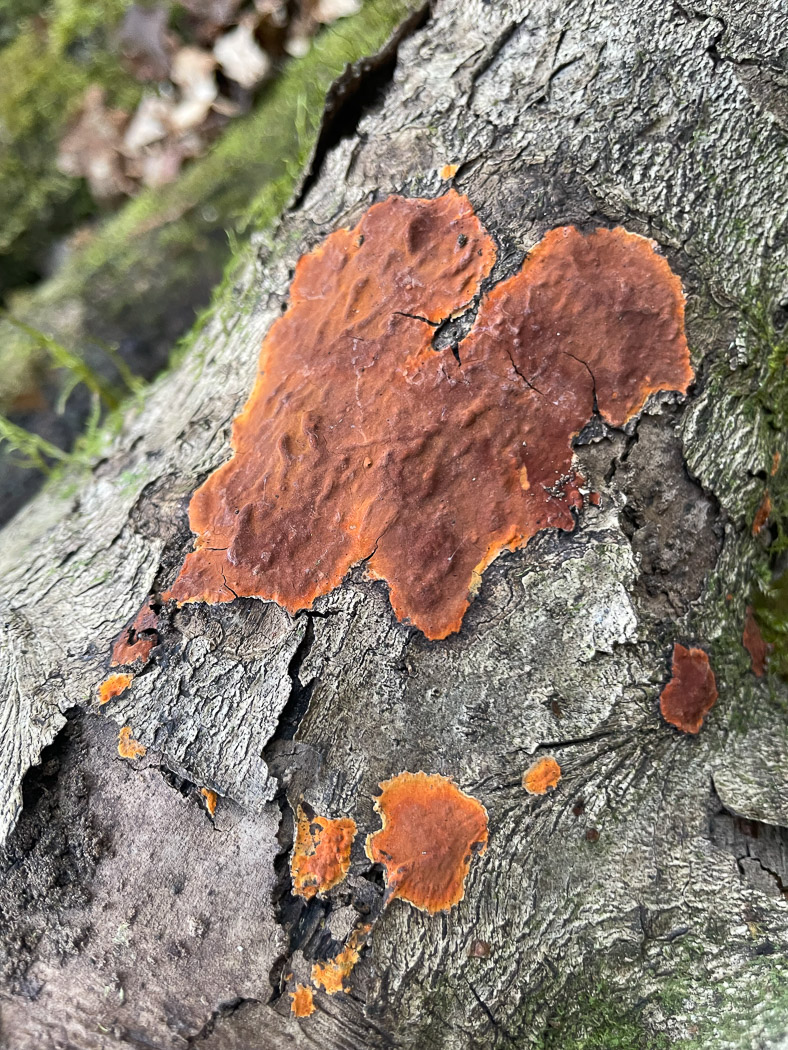 |
April 9th Hypoxylon subticinense (a rare Woodwart with no English name) At Burnham Beeches Sarah Ebdon and Jesper Launder made a B-line for a particular log pile, mainly Beech, where we'd found several interesting species on our Walk here last April including this unusual Hypoxylon which was then new to the county (see my report for April 17th, 2024) .Sure enough, after turning various logs they found it fruiting in abundance on the fallen Beech branches. Sarah says that her photo shown here really doesn't do justice to its brilliant ochre-orange colour which singles out this species from others, nor does it form the typical round 'warts' with which we are familiar in the much more common species of Hypoxylon. So this is our second county record but the first entry for Finds, last year's collection was not included here as Finds is reserved for those collections made in the county apart from on our Walks. New entry |
April 22nd 2025
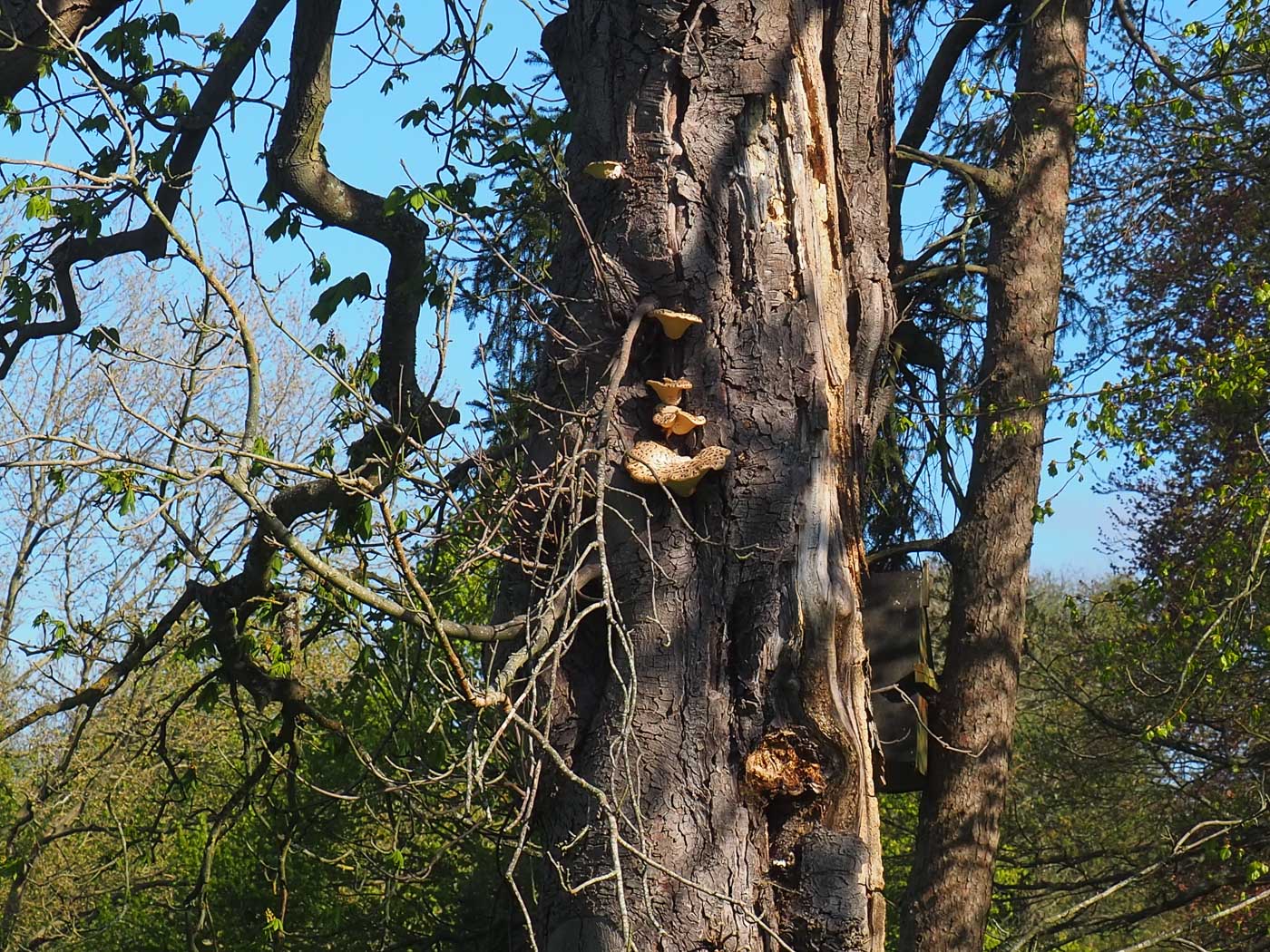
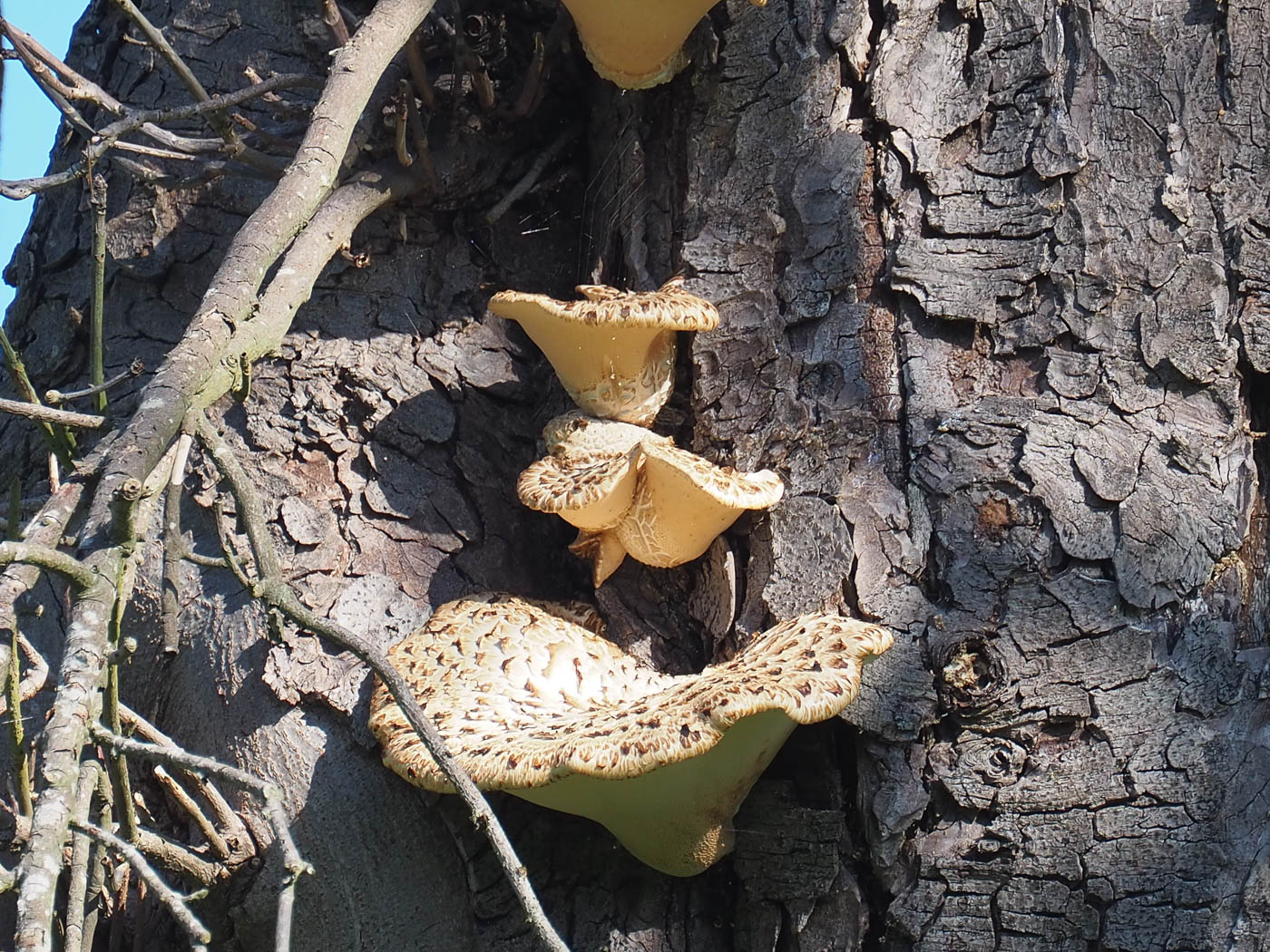 |
April 20th Cerioporus squamosus (Dryad's Saddle) In Hughenden Park John Catterson noticed this bracket on a standing Horse Chestnut trunk. Probably more familiar by its previous genus name Polyporus, the species is one of our most charismatic with its scaly upper surface, often becoming the size of a horse's saddle before ending up fallen to the ground. Often one can then detect its original spot where attached to the tree - often Ash - high up in the canopy. Previous finds |
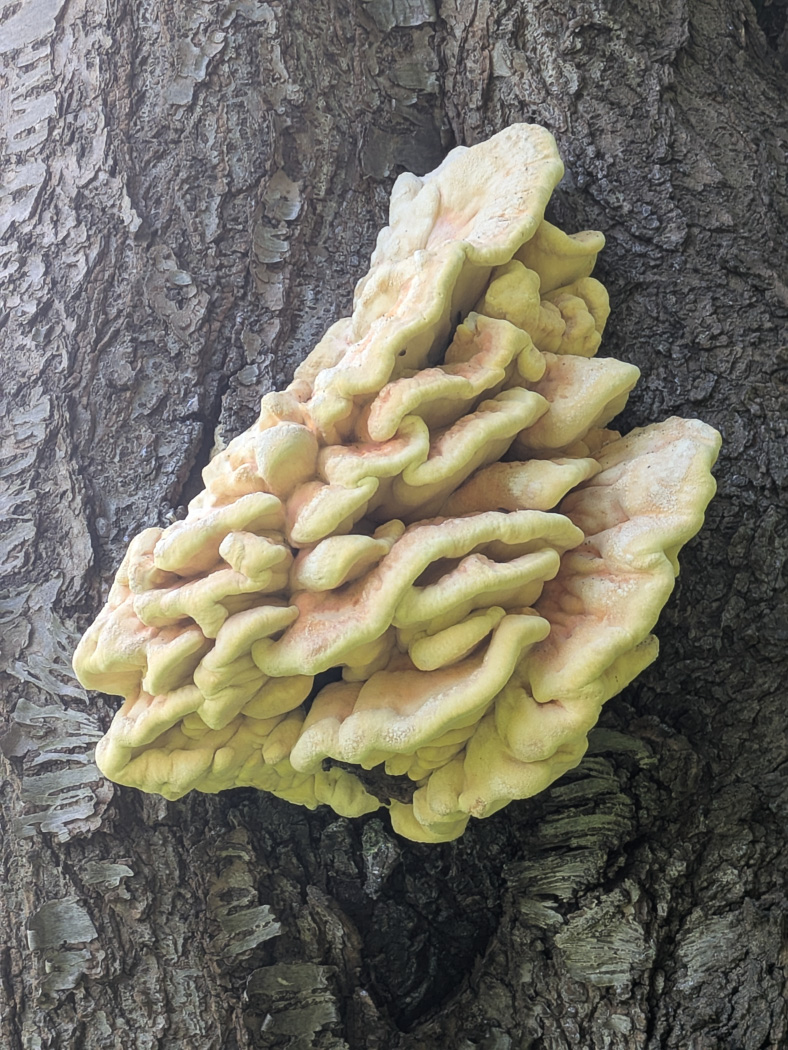 |
April 19th Laetiporus sulphureus (Chicken of the Woods) In High Wycombe Lisa Dodd noticed this fresh and sizeable bracket on a standing Wild Cherry. This is an attractive species which often fruits quite early in the year and certainly in our area seems to favour Cherry though it is not unusual to find it on other hosts. (The photo is Andrew Dodd's) Previous finds |

 |
March 31st Kretzschmaria deusta (Brittle Cinder) In Tinkers Wood John Catterson struggled to find anything fungal of interest apart from some freshly fruiting Brittle Cinder on a mossy deciduous log. When at this early stage of development this pyrenomycete species looks nothing like the typical patches of black crumbly cinders which form later on. Previous finds |
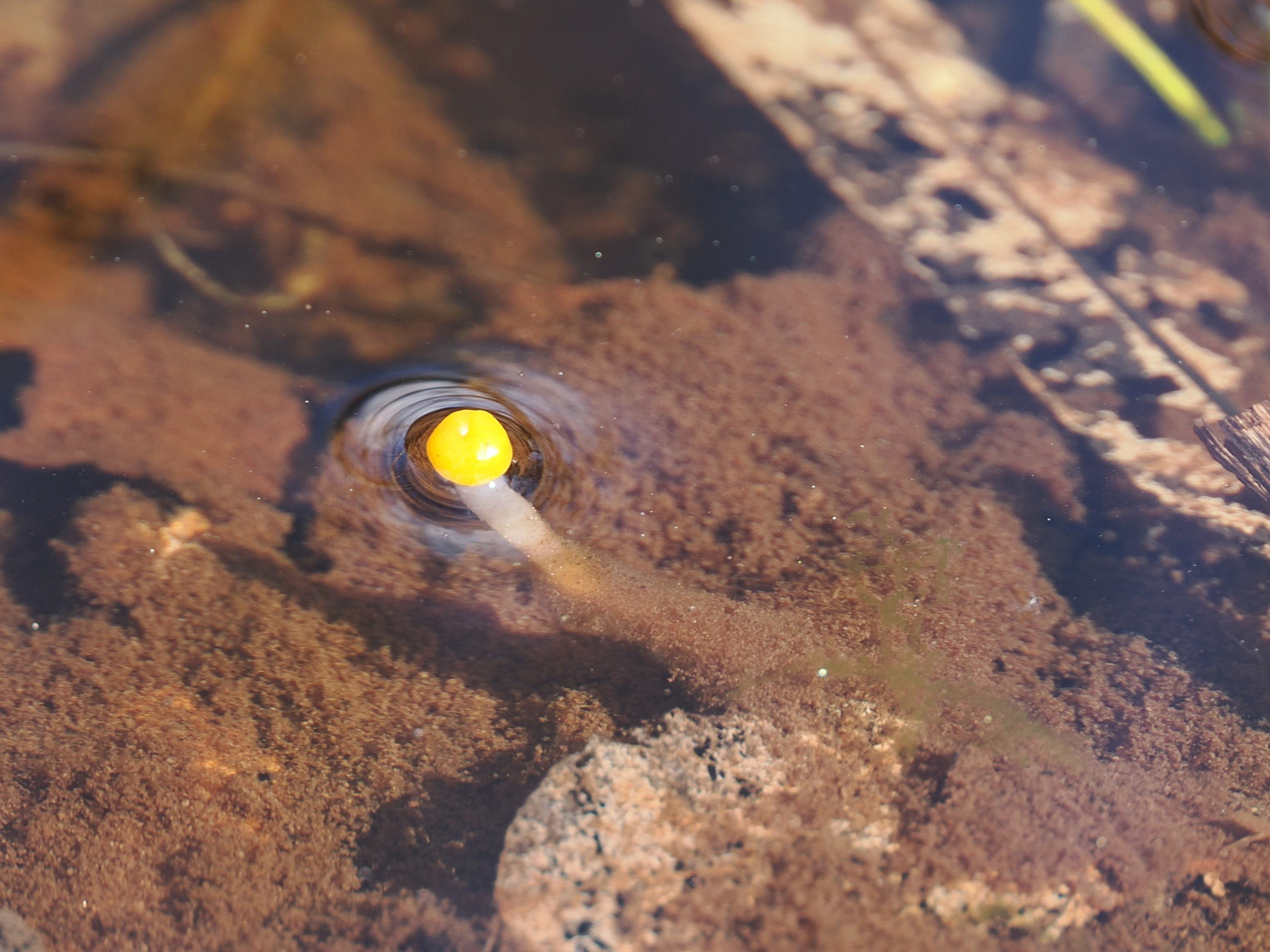 |
March 26th Mitrula paludosa (Bog Beacon) Claire Williams was on the look-out at Burnham Beeches for early signs of this springtime species and was rewarded with just this single example. We have plentiful records of it from the Mire - an area which provides the perfect habitat for this marsh-loving ascomycete, but this just beats last year's March record by several days! It remains to be seen whether it continues fruiting through till June as in some previous years. Previous finds |
March 26th 2025
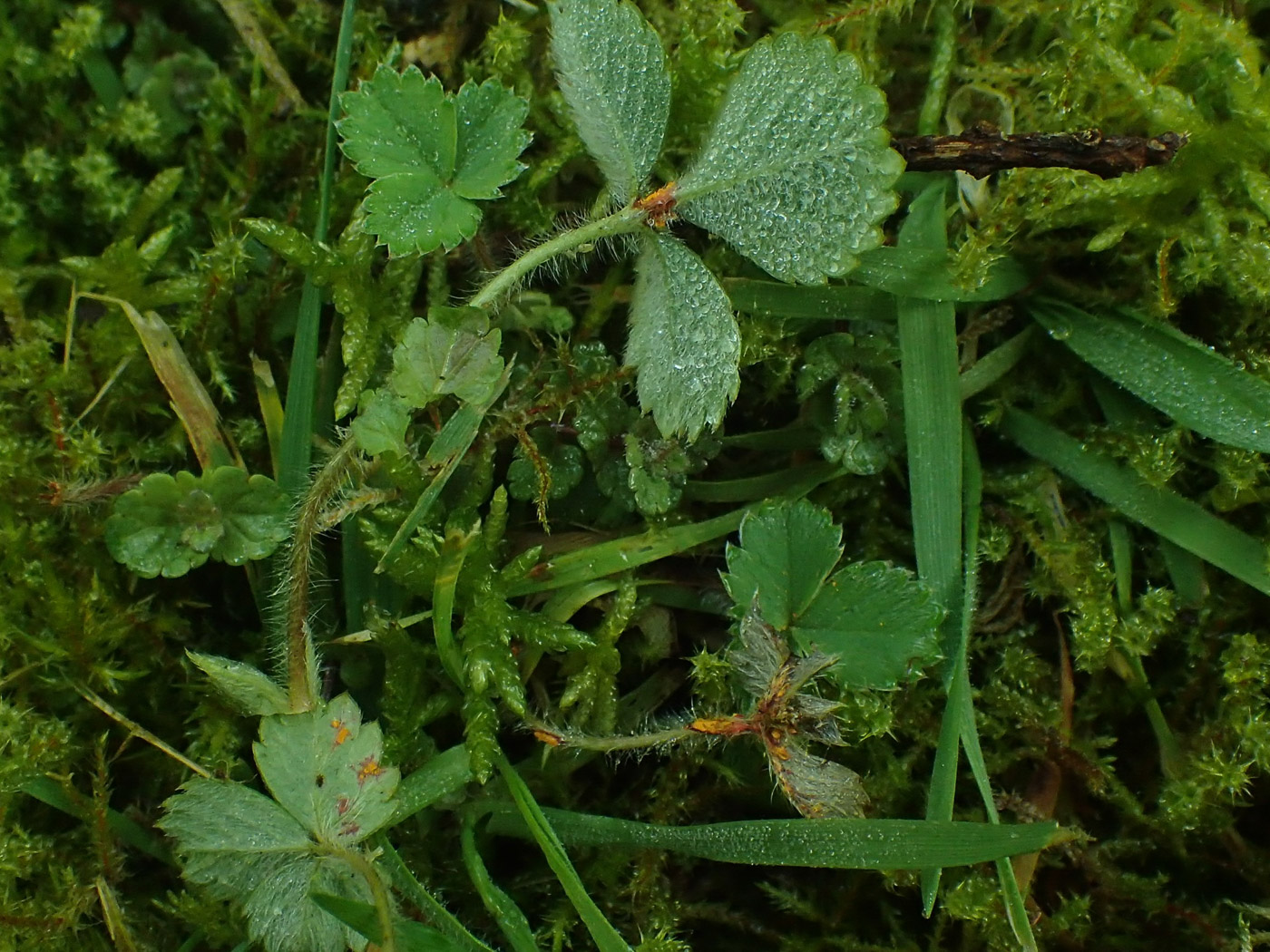
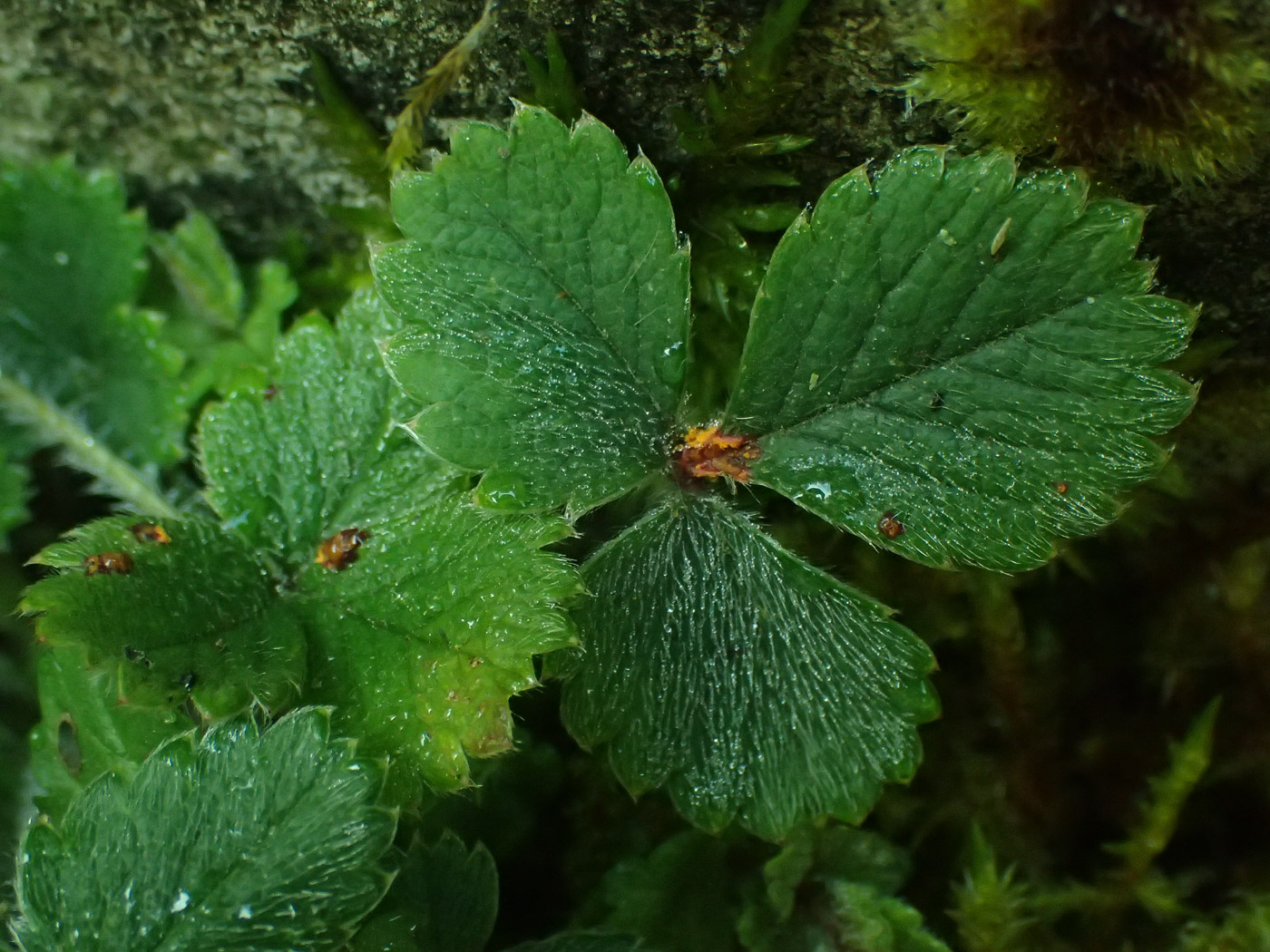
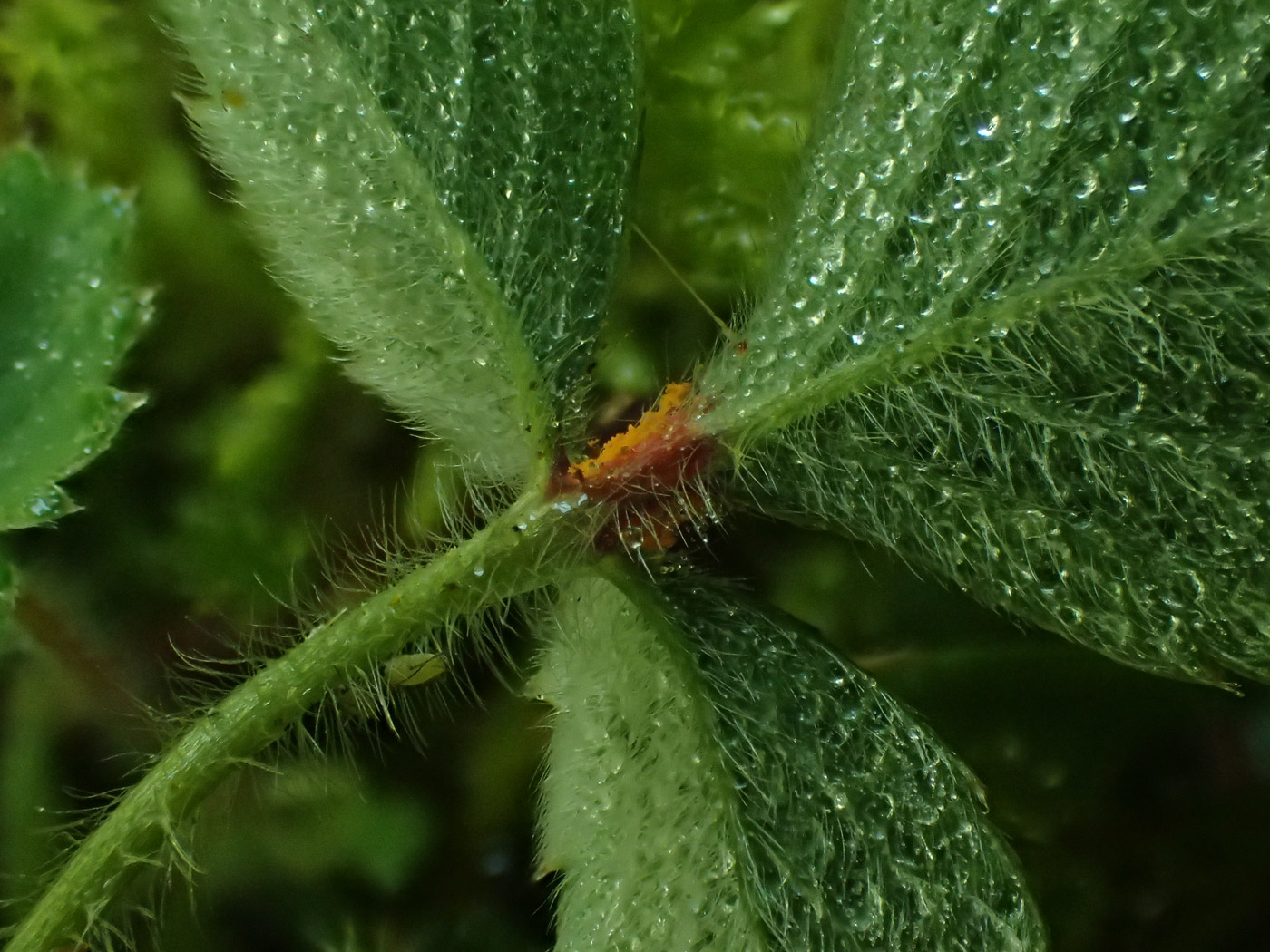
|
March 25th Phragmidium fragariae (a Rust species on Barren Strawberry) In Lacey Green Churchyard Sarah Ebdon noticed the distinctive leaves of Strawberry and on closer inspection she noticed the telltale orange 'dust' of a rust fungus forming on the leaves and petioles. (This is the time of year for such fungi.) To get to the name of this rust it is necessary to be able to recognise the difference between Fragaria vesca (Wild or Alpine Strawberry) and Potentilla sterilis (Barren Strawberry) which at first glance look vitrually identical! However once one realises that it only occurs on the Potentilla (despite its Latin species name suggesting otherwise!) you're pretty well home and dried. This is not a rarity though we have only one other known county site, however Sarah tells me that there is also a much rarer rust on this host so she intends investigate further just to confirm the later stages of development continue to match P. fragariae. Previous finds |
March 22nd 2025

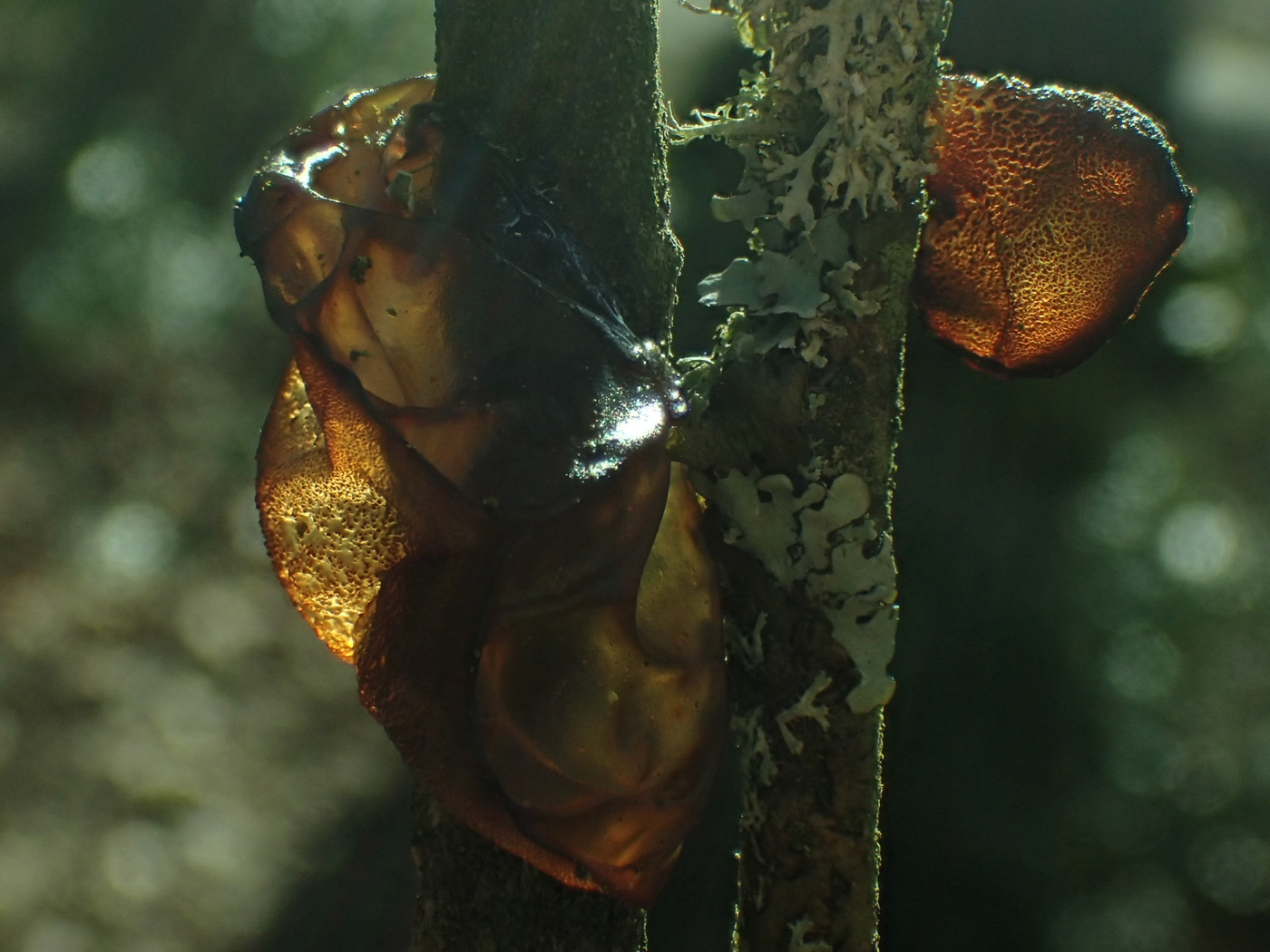
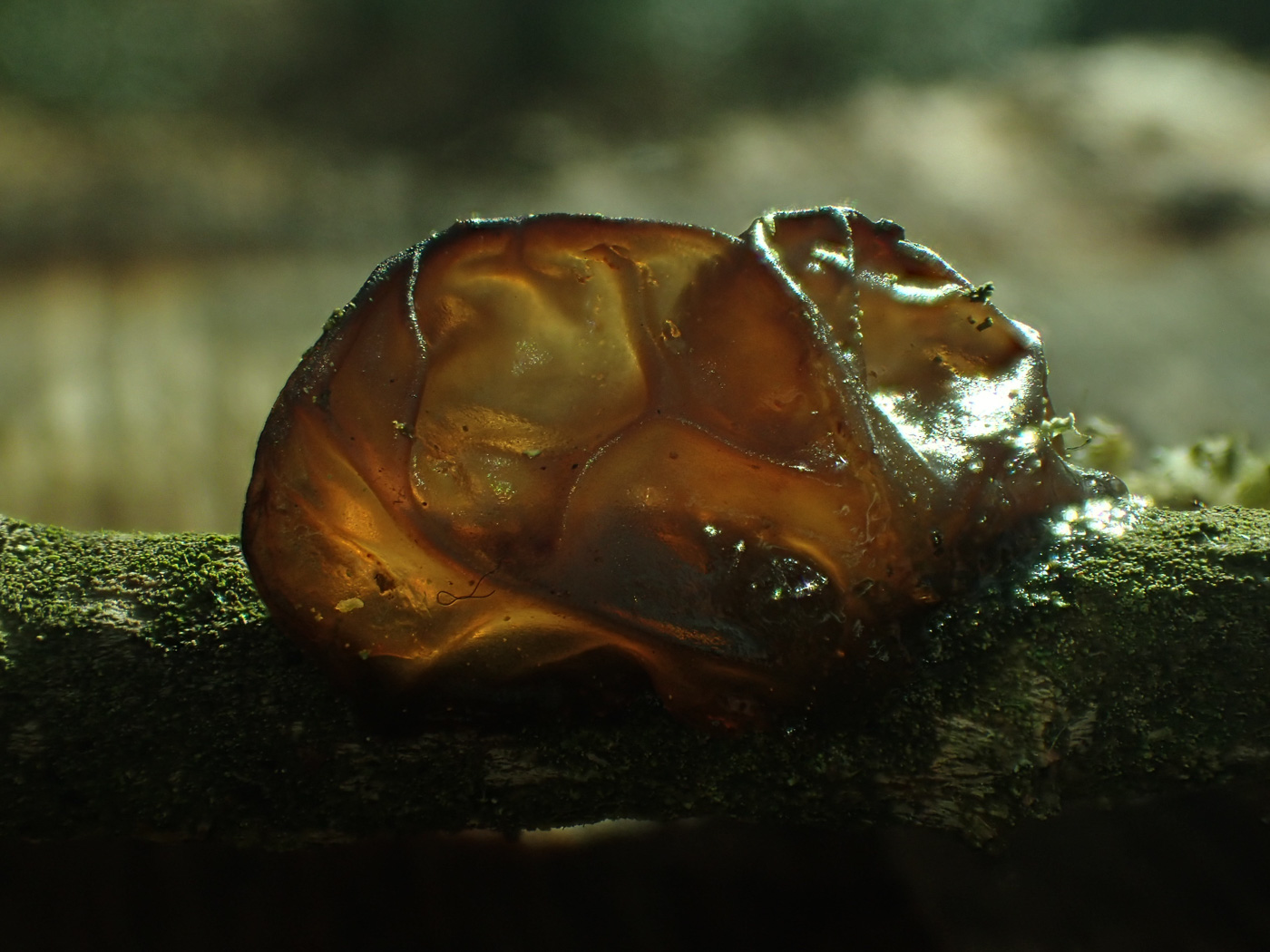
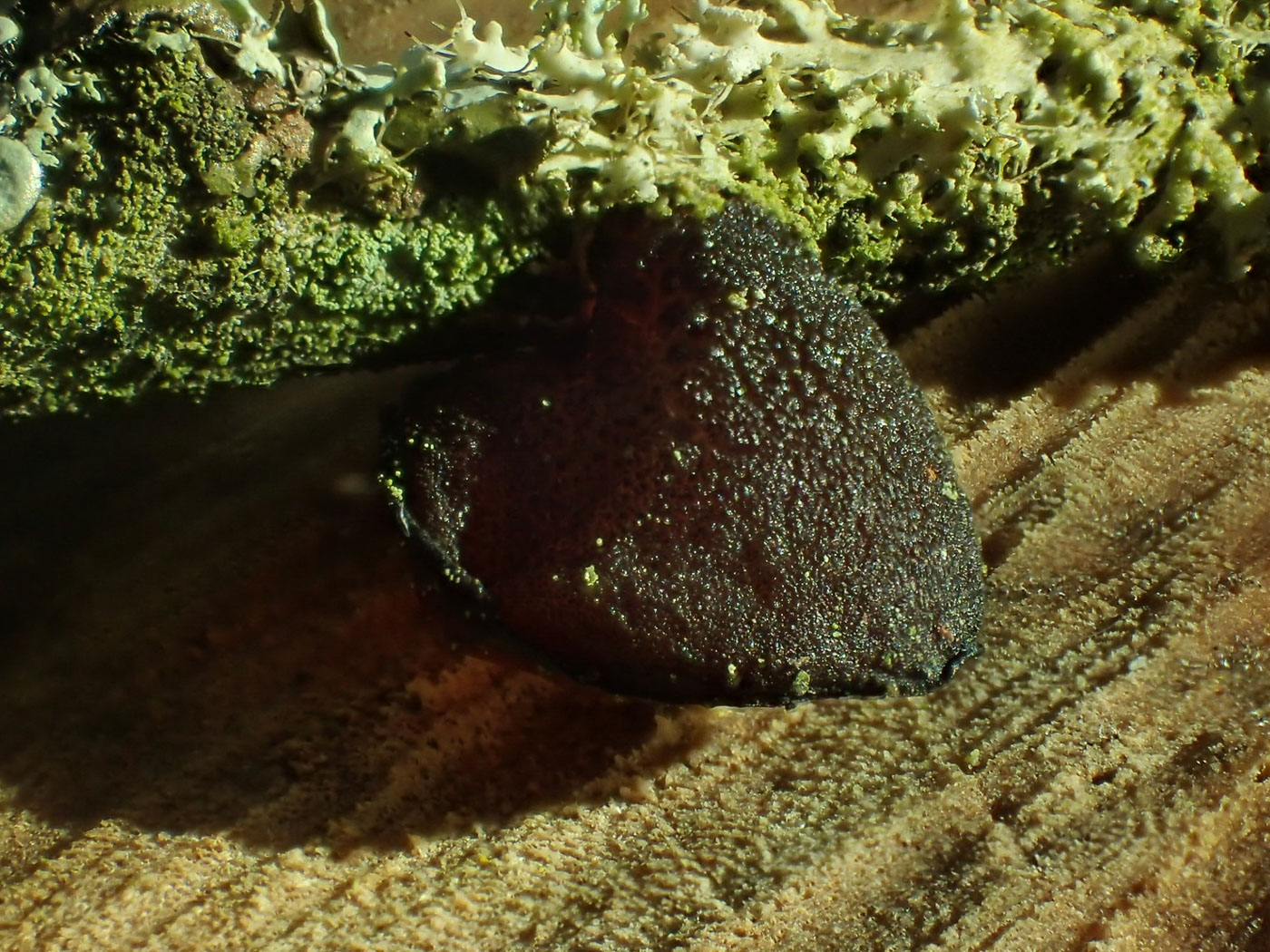
|
February 27th Exidia recisa (Amber Jelly) In Burnham Beeches Sarah Ebdon caught sight of this translucent jelly with the light behind it when on the boardwalk in the mire. It was on an attached Willow branch and from its unusual colour and the host wood (with which it is host specific) she suspected it was this quite unusual species - certainly much less common than the blackish members of this genus we find regularly on Oak. Checking at home later (though the material was then well past its best) the features she could find fitted fine, confirming her first thoughts. Note the bumpy underside surface - a characteristic of several Exidia species though E. recisa is alone in having amber coloured fruit bodies. We have just four previous county records, one notably also from the Beeches in 2000 found and identified by Kew Exidia expert Peter Roberts when on the BMS organised foray here as part of their successful project to collect 2000 species for the Kew Fungarium that year. Sarah is in good company! This is a new entry for Finds. New entry |
March 1st 2025
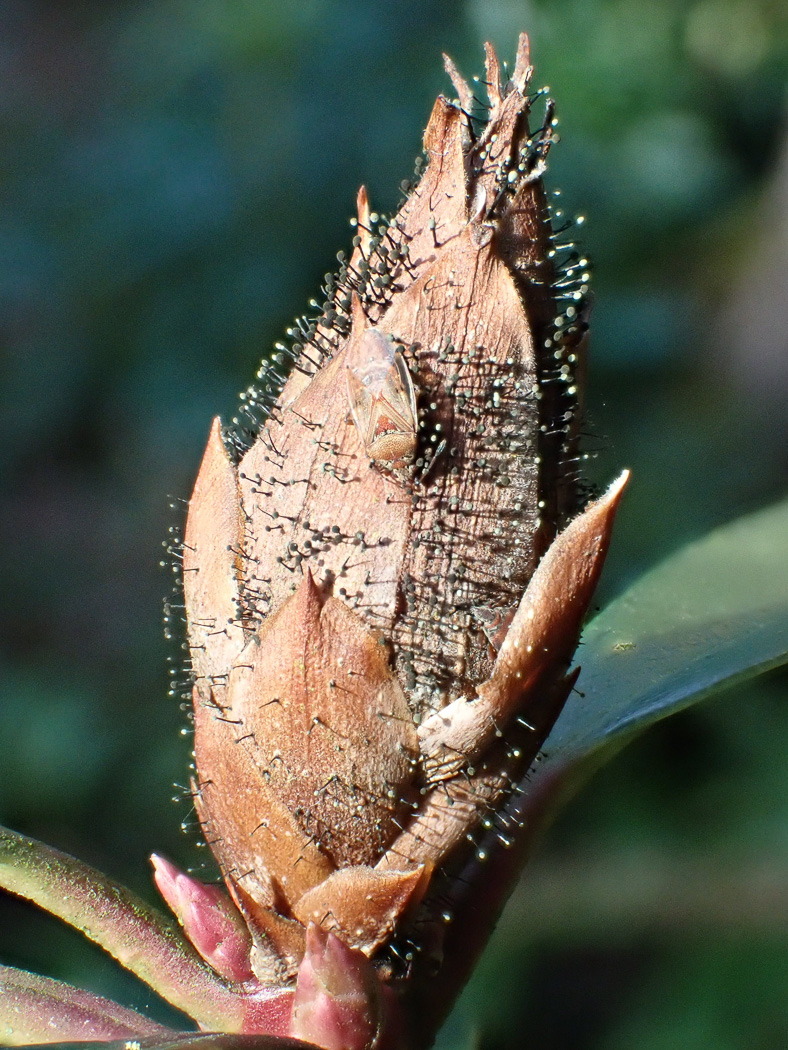
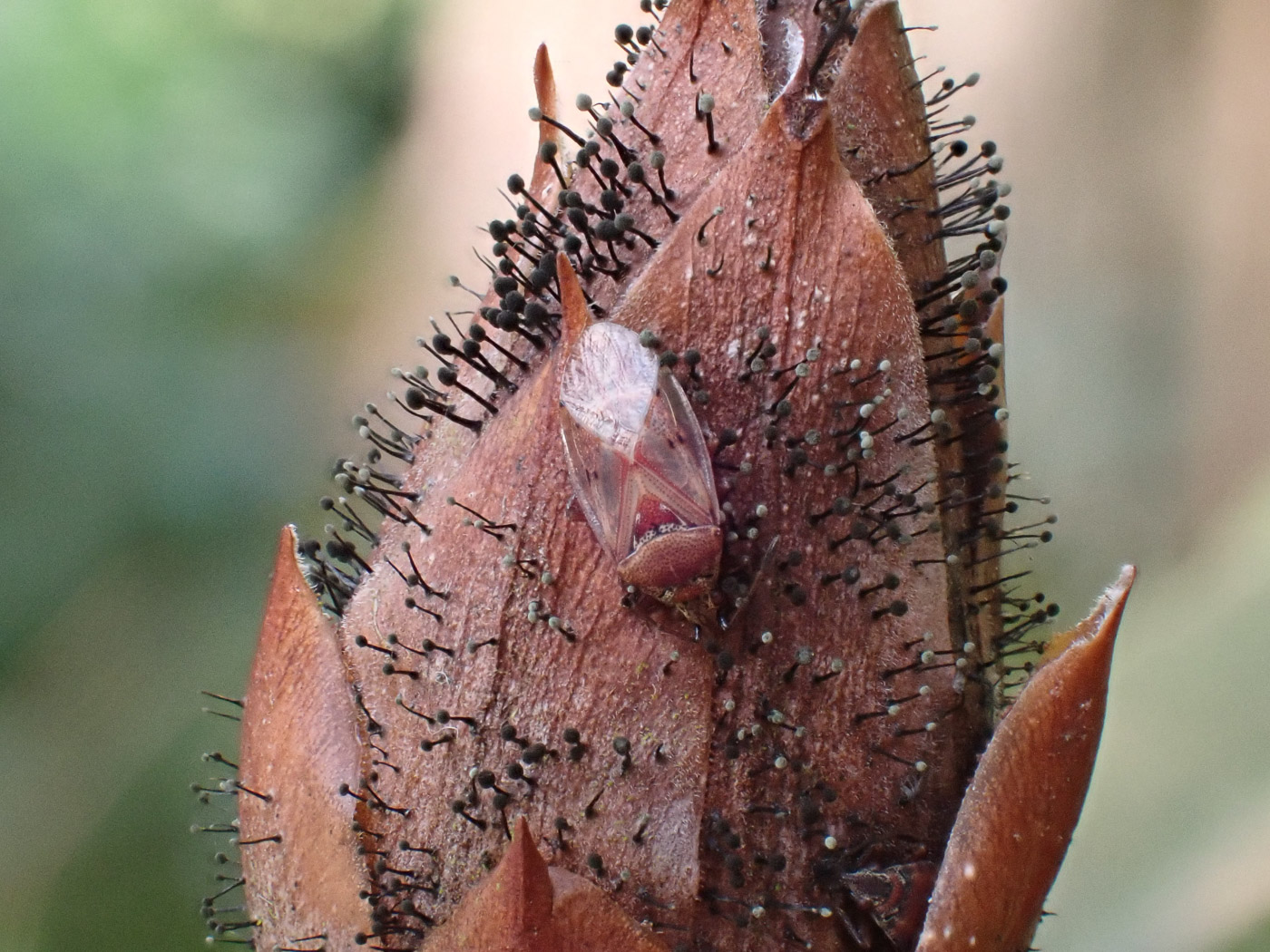
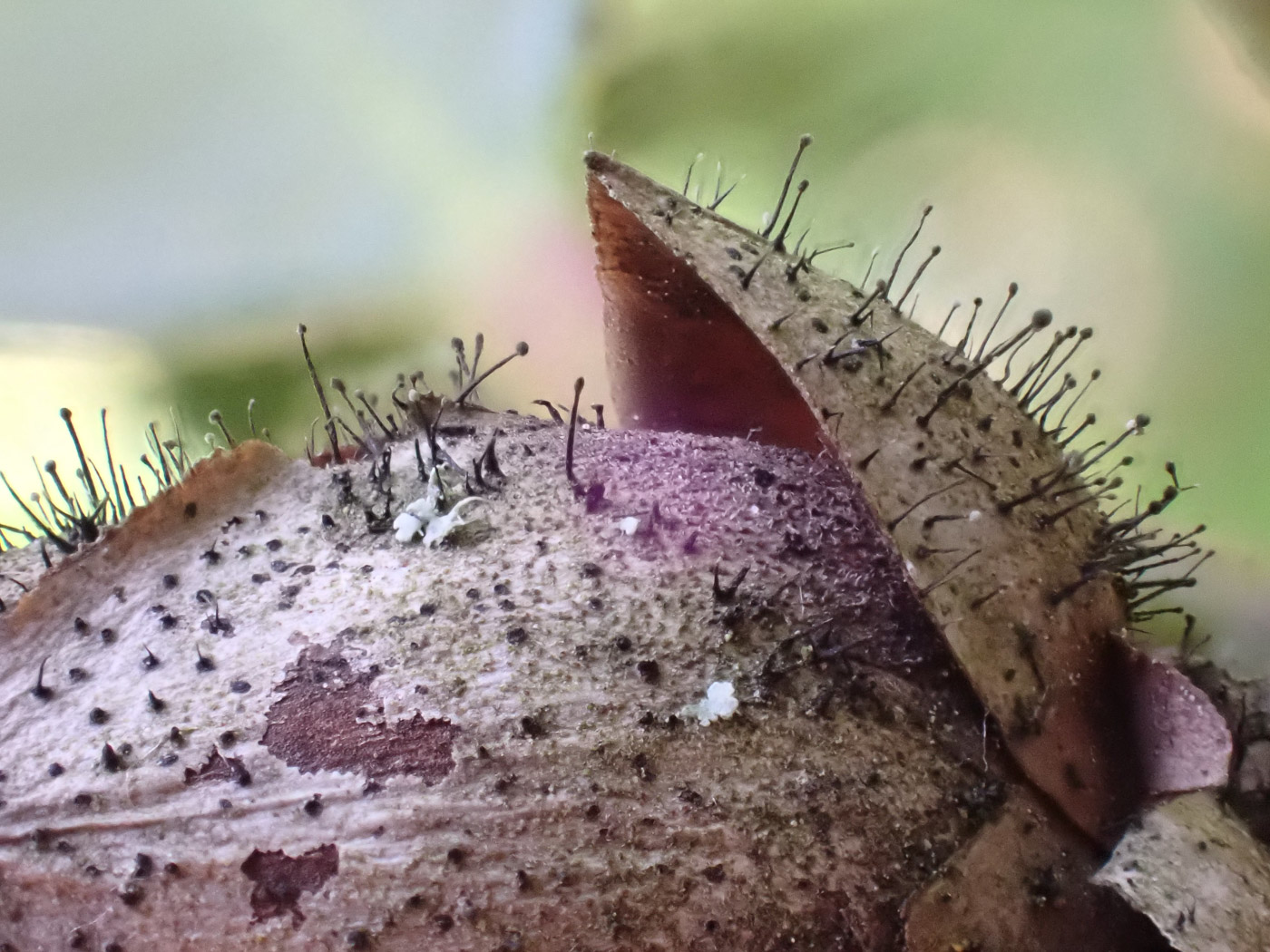 |
March 1st Seifertia azaleae (Bud Blast/ Rhododendron Blight) In Rushmere Country Park Stephen Plummer found good examples of this common plant pathogen which affects the buds of both Rhododendron and Azalea at this time of year and prevents them from developing further. Previous finds |
February 21st 2025
 |
February 21st Basidioradulum radula (Toothed Crust) On a fallen Prunus branch at Stampwell Farm Jackie Ewan found this toothed resupinate corticioid which however is very similar to Radulomyces molaris (Oak Toothed Crust) and from Jackie's photo Penny was not confident to confirm which of the two species we have here. The latter tends to occur high up on attached deciduous branches - not necessarily Oak despite the name - but after strong winds it can often be found on the ground. However, when Jackie learnt of Penny's doubts she then checked the spores which luckily differ in shape between these two similar species and was able to confirm her initial ID! Previous finds |
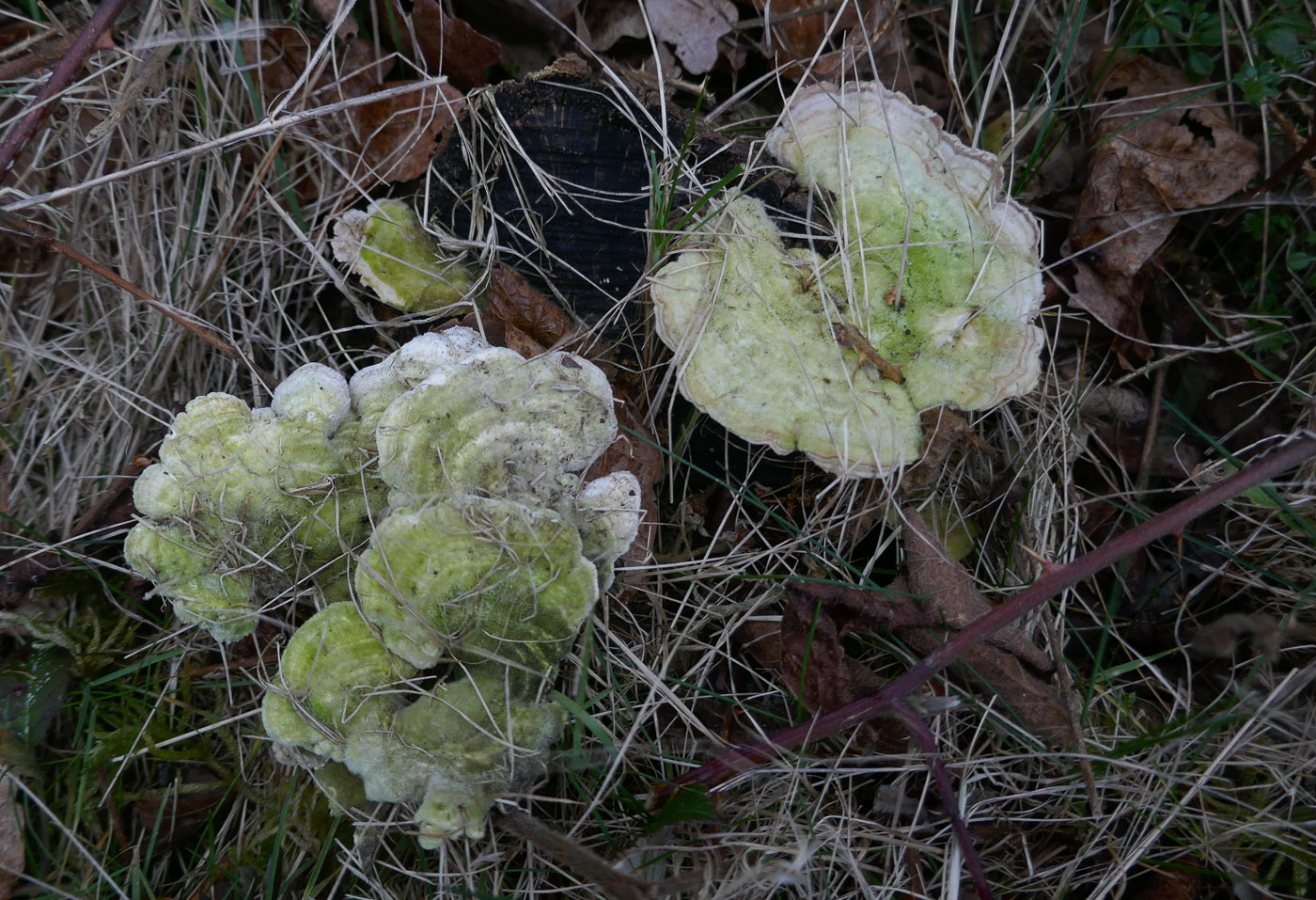
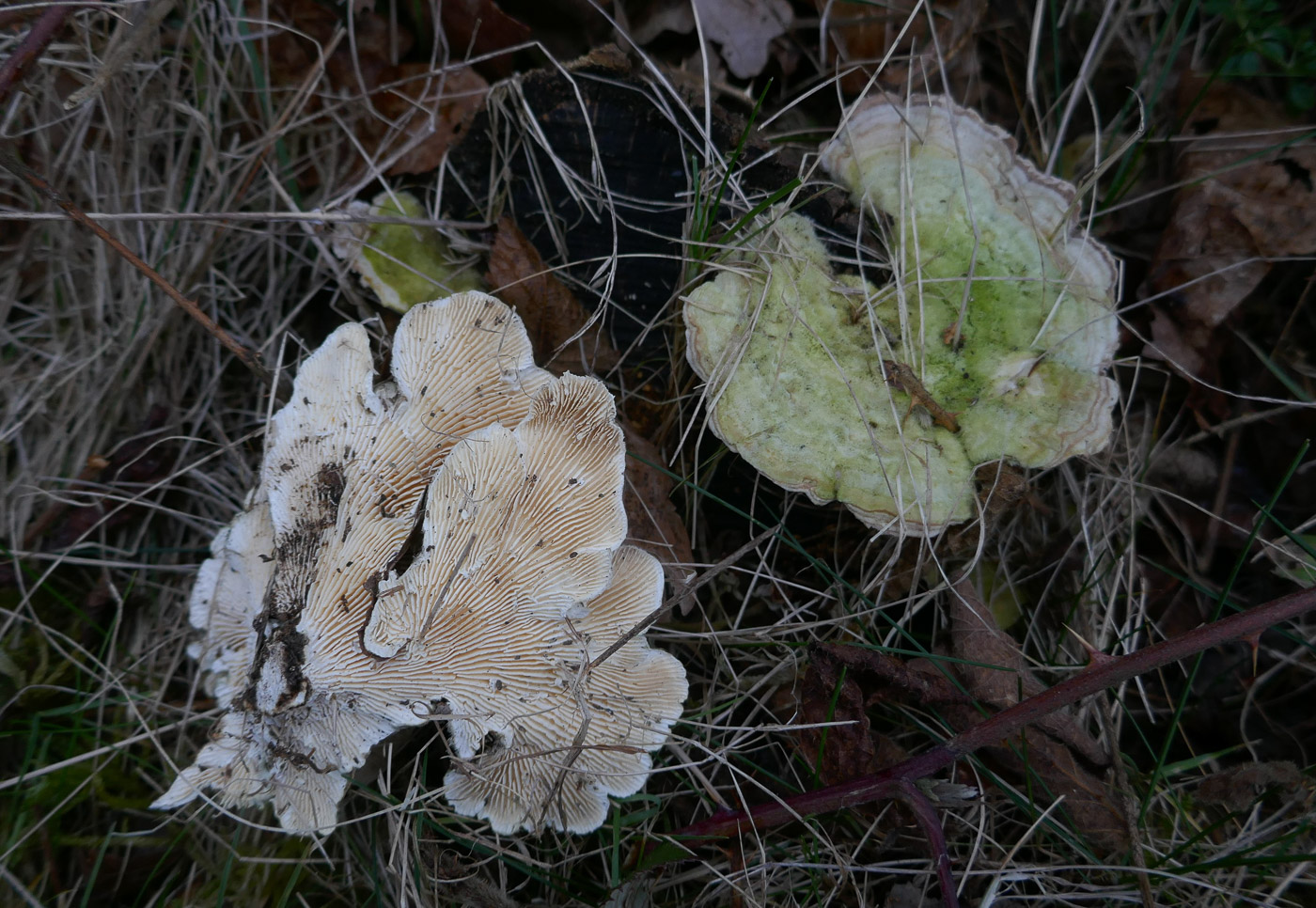 |
February 21st Lenzites betulinus (Birch Mazegill) At Stampwell Farm Jackie Ewan spotted this cluster of brackets which had become detached from a sawn off deciduous log but still produced spores later for her to check the ID. The species occurs on other deciduous fallen woods though is commonest on Birch as its name suggests. Other brackets can look similar with typical zoning and even with a coating of algae above as here, but the almost gill-like underside in place of obvious pores separates it though Trametes gibbosa also shares this feature but the English name of that species, Lumpy Bracket, describes its upper surface well and it tends to be large and much tougher and harder than today's species. Previous finds |
February 18th 2025
February 16th 2025
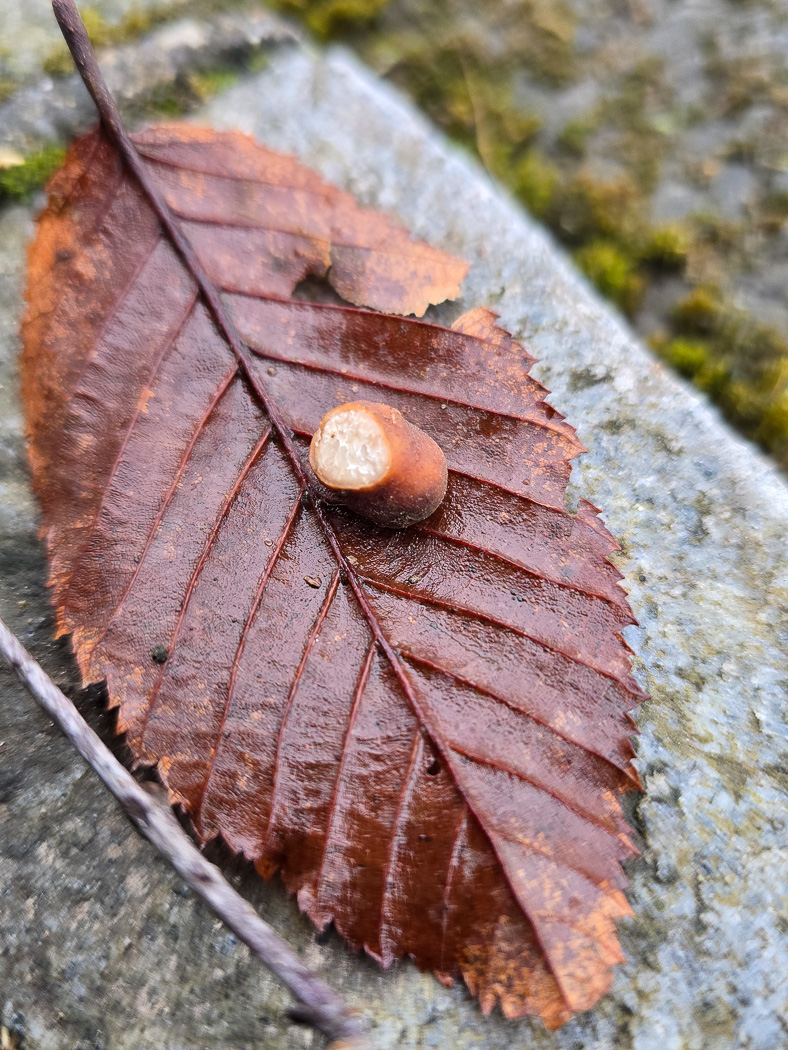
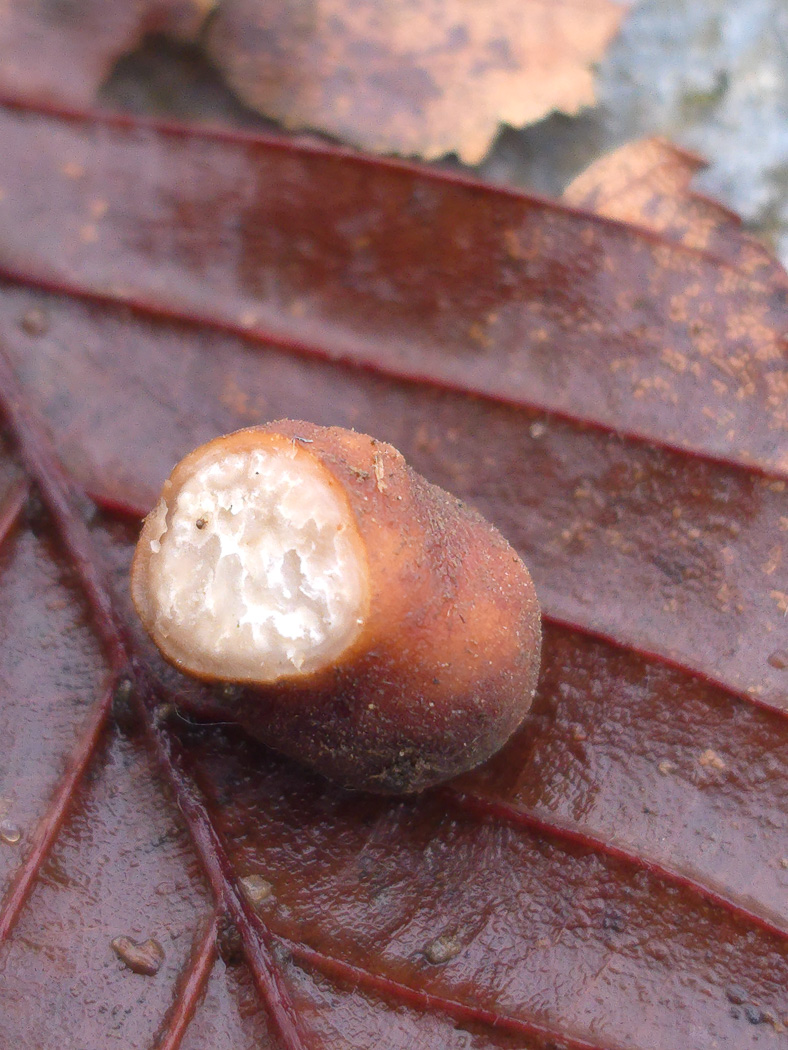 |
February 13th Tuber rufum (an ascomycete truffle with no English name ) In Chalfont St.Giles Jesper Launder found this small truffle just submerged in soil under Hornbeam. He reports that although early in the year to find this species, it was already developing a smoky aroma and the 'marbling' effect within was well defined. This appears to be just our fourth county record though it is probably not particularly rare, it's just that not many people go looking for truffles, nor have Jesper's knowledge and experience. He is almost singlehandedly responsible for our growing list of truffle records over the last few years. Previous finds |
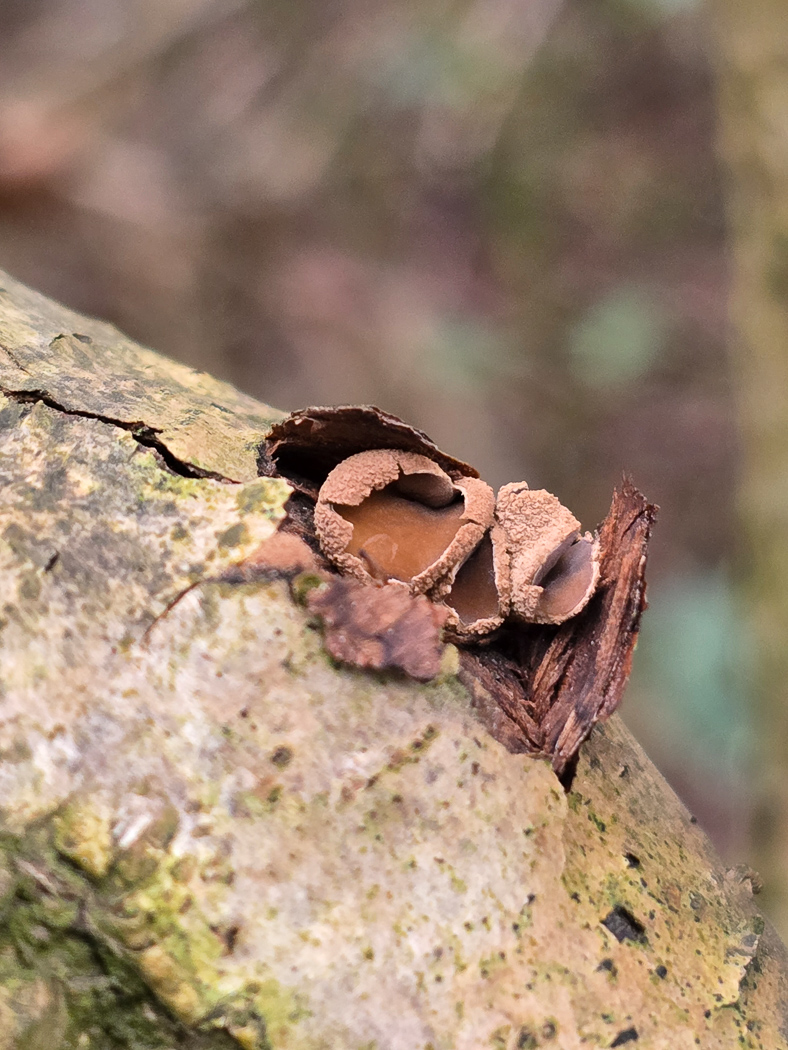 |
February 12th Encoelia furfuracea (Spring Hazelcup) In Jordans Village on dead but attached Hazel Jesper Launder spotted this somewhat inconspicuous ascomycete which however is not rare wherever Hazel is present. One needs to know to look out for it on this host in Spring otherwise it is very easily missed. Previous finds |
 |
February 12th Cuphophyllus pratensis (Meadow Waxcap) Here we have a common Waxcap but it is surely unusual to see it fruiting in February! It was spotted by Jesper Launder in Jordans Village where lurking under some Ivy, which was presumably offering some protection, and adjacent to a meadow where the species fruits regularly in autumn. Previous finds |
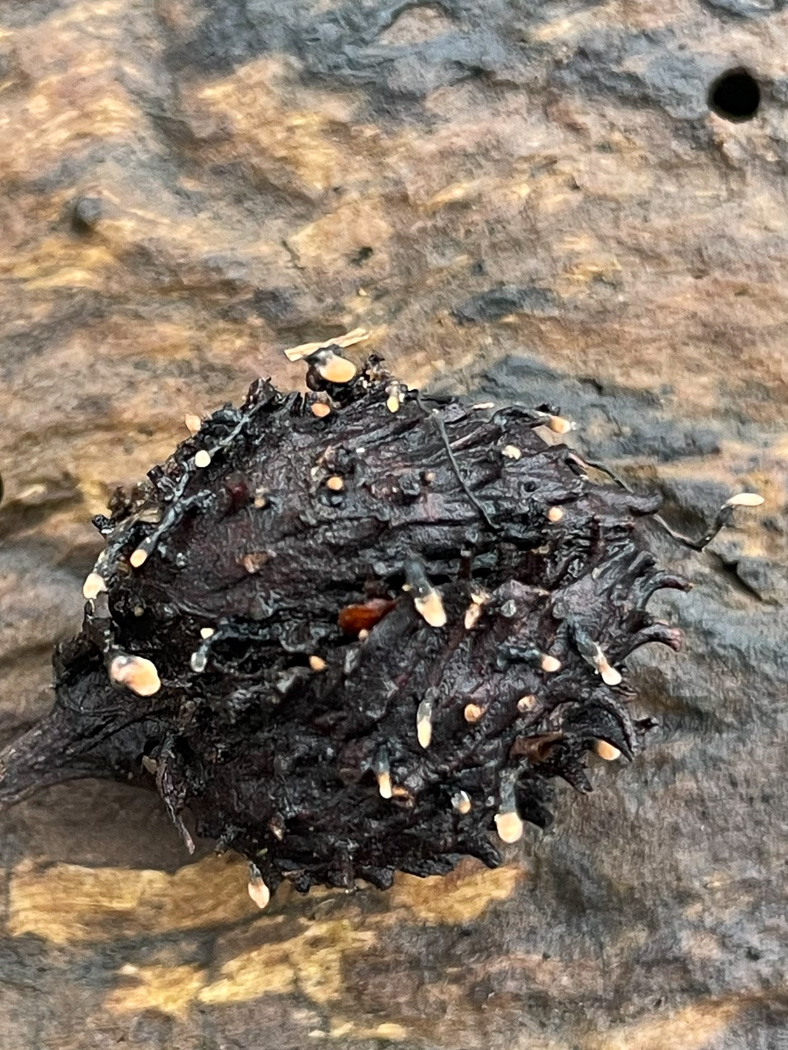
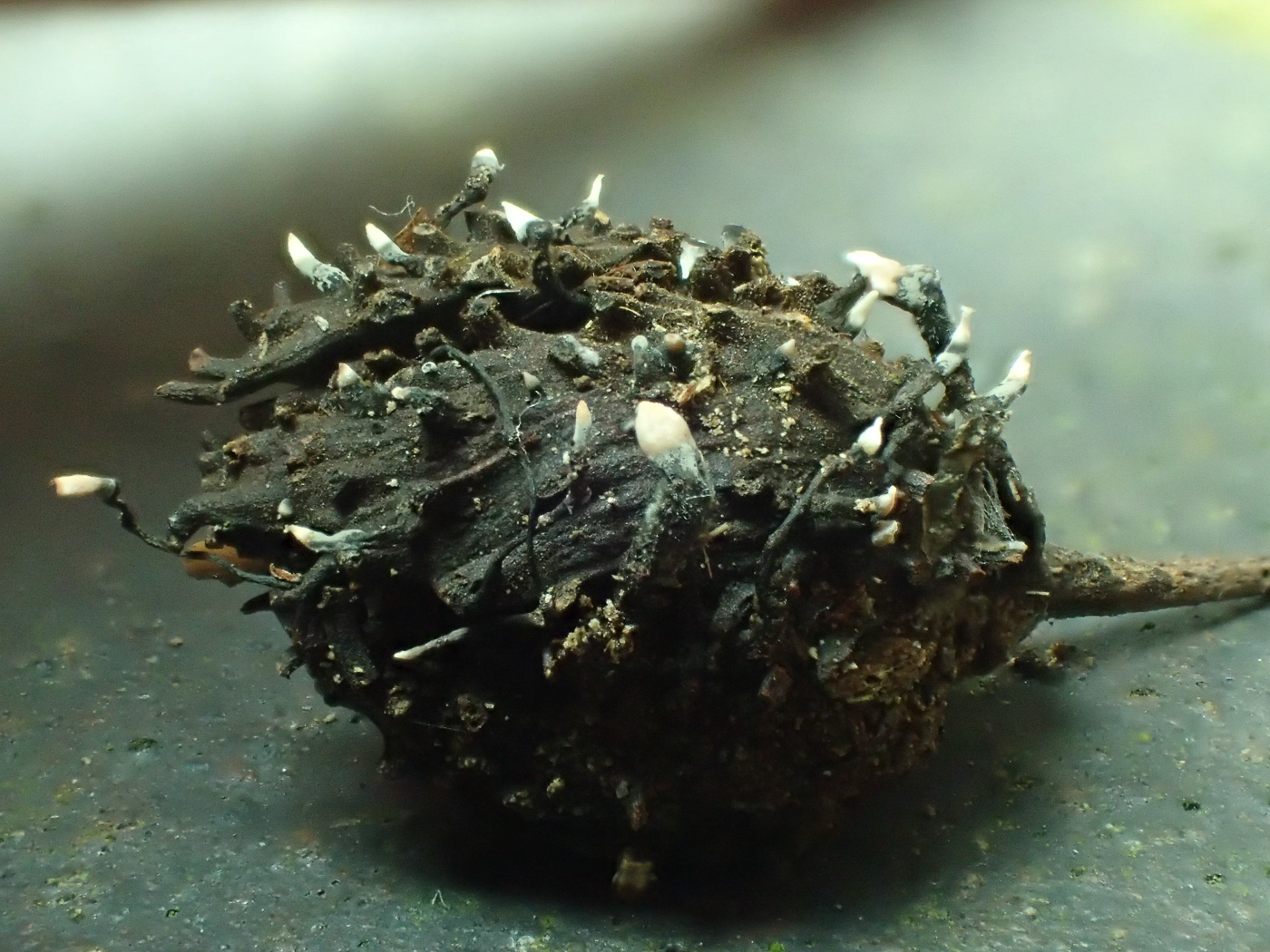
 |
February 9th Xylaria carpophila (Beechmast Candlesnuff) On farmland near Saunderton Sarah Ebdon found this delightful material of a springtime smaller version of our common Xylaria hypoxylon (Candlesnuff). As the name suggests it grows only on Beechmast and is therefore common in our area where Beech predominates.To find it you need to dig about in thick litter under Beech, looking for the telltale pink tips on the top of thin black strands, when young and fresh quite finely hairy as can be seen from Sarah's photos. Previous finds |
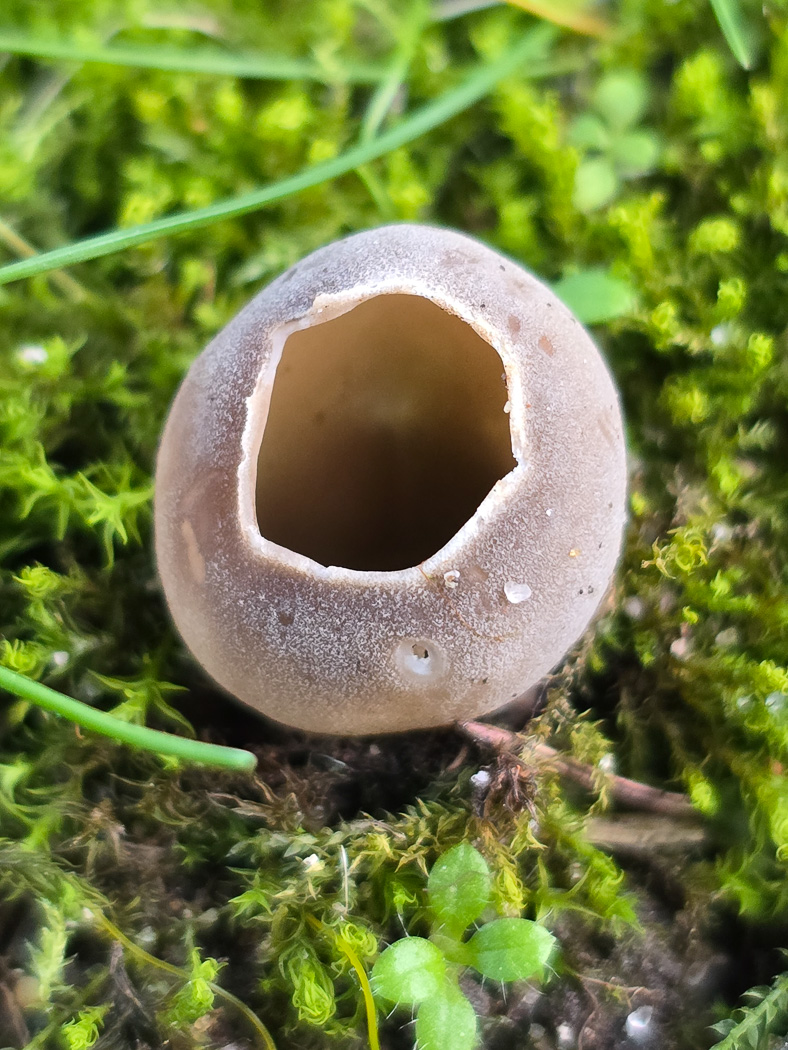 |
February 2nd Dissingia (previously Helvella) leucomelaena (Sooty Cup) Today's find makes the third consecutive year that Jesper Launder has found this rare ascomycete under the same Pine in Gerrards Cross - twice now in February and once in April. In appearance very similar to the genus Peziza, the species has been in various different genera and is not covered in any available hand books, but appears to be a spring fruiting cup found under conifer and tends to develop greyish black colours internally with a paler outer surface and a whitish stem. The American name for this species is 'White-footed Elfcup'.This is the third county record. Previous finds |
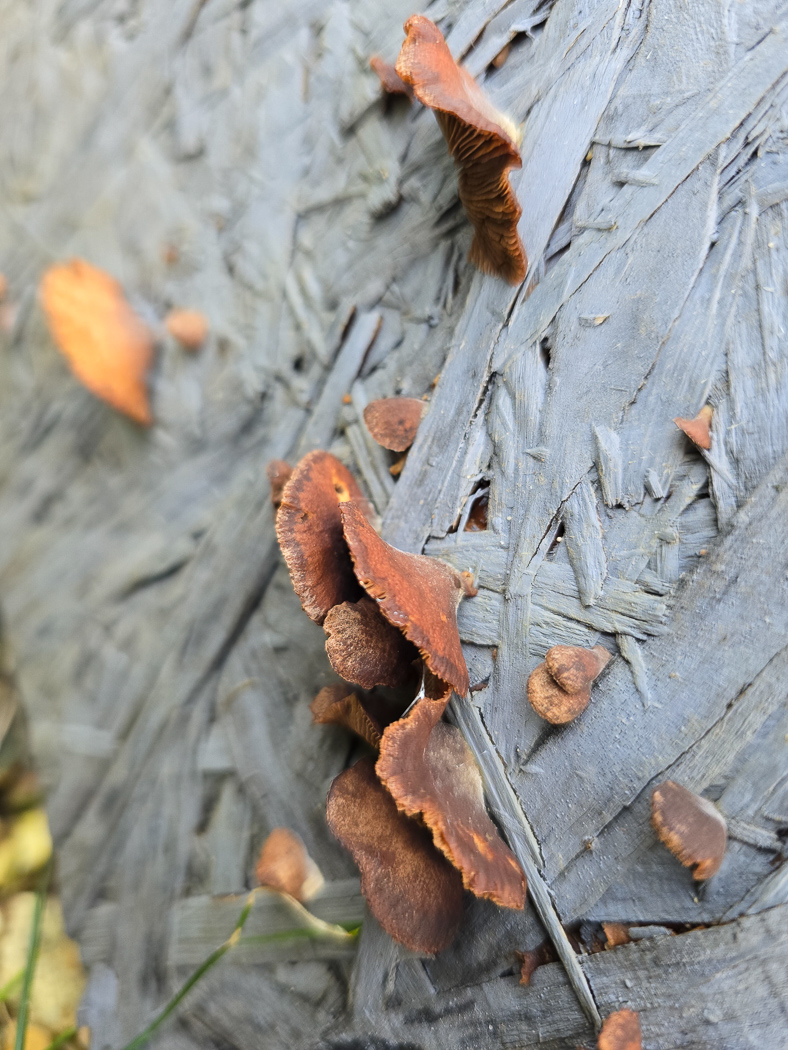
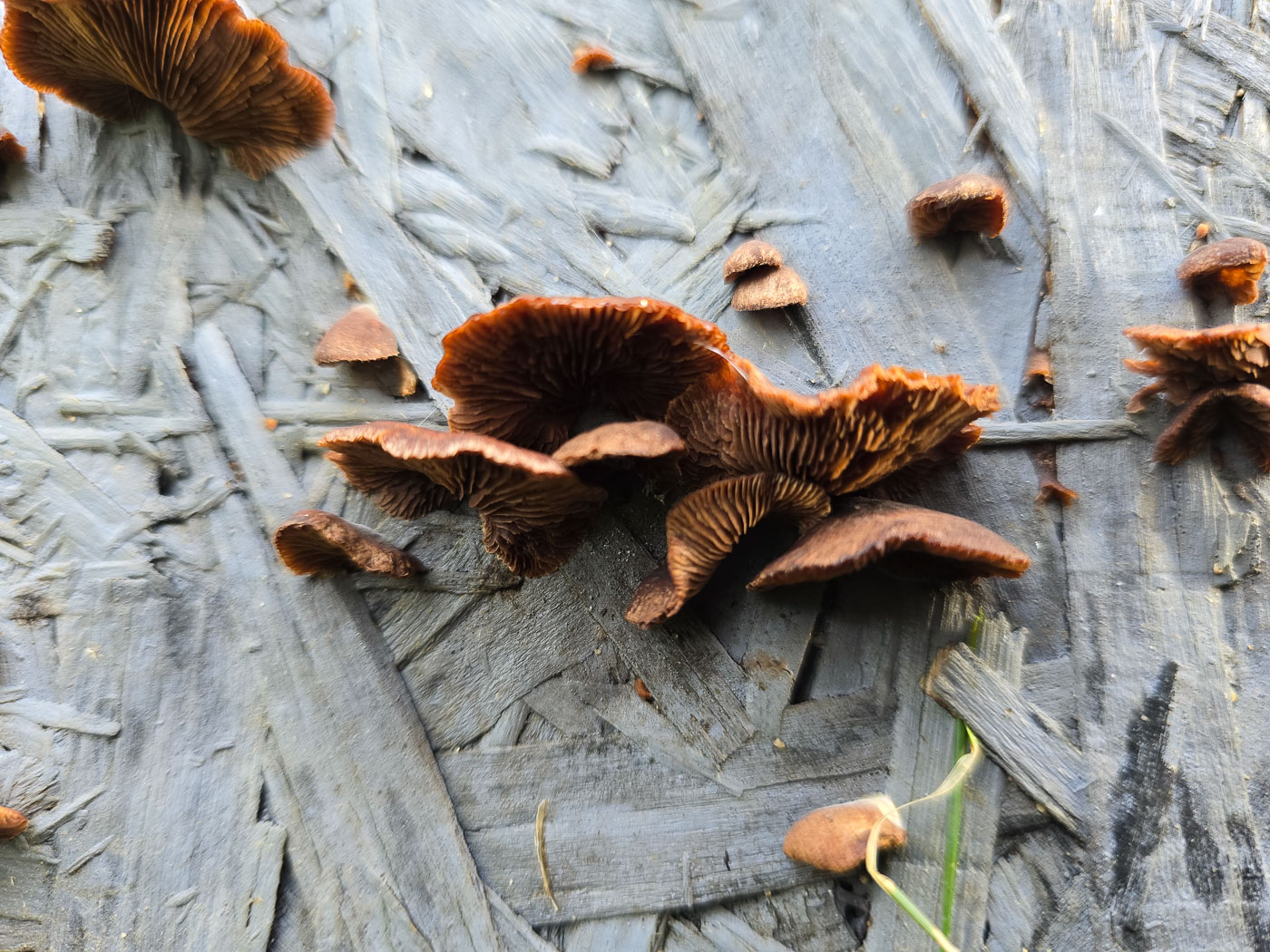 |
January 30th Deconica horizontalis (Wood Oysterling) In Gerrards Cross Jesper Launder noticed this fungus on a somewhat surprising substrate: painted chipboard! Not unlike Panellus stipticus, ie brown and similar in shape and size to some species of Crepidotus, it is often found on unusual woody substrates of all sorts, also old rope, even old carpet. It lacks the sticky gill surface of P. stipticus which should help to separate the two in the field though D. phillipsii is also similar but has a more distinct eccentric stem. We have plenty of county records but this is a new entry for Finds. New entry |
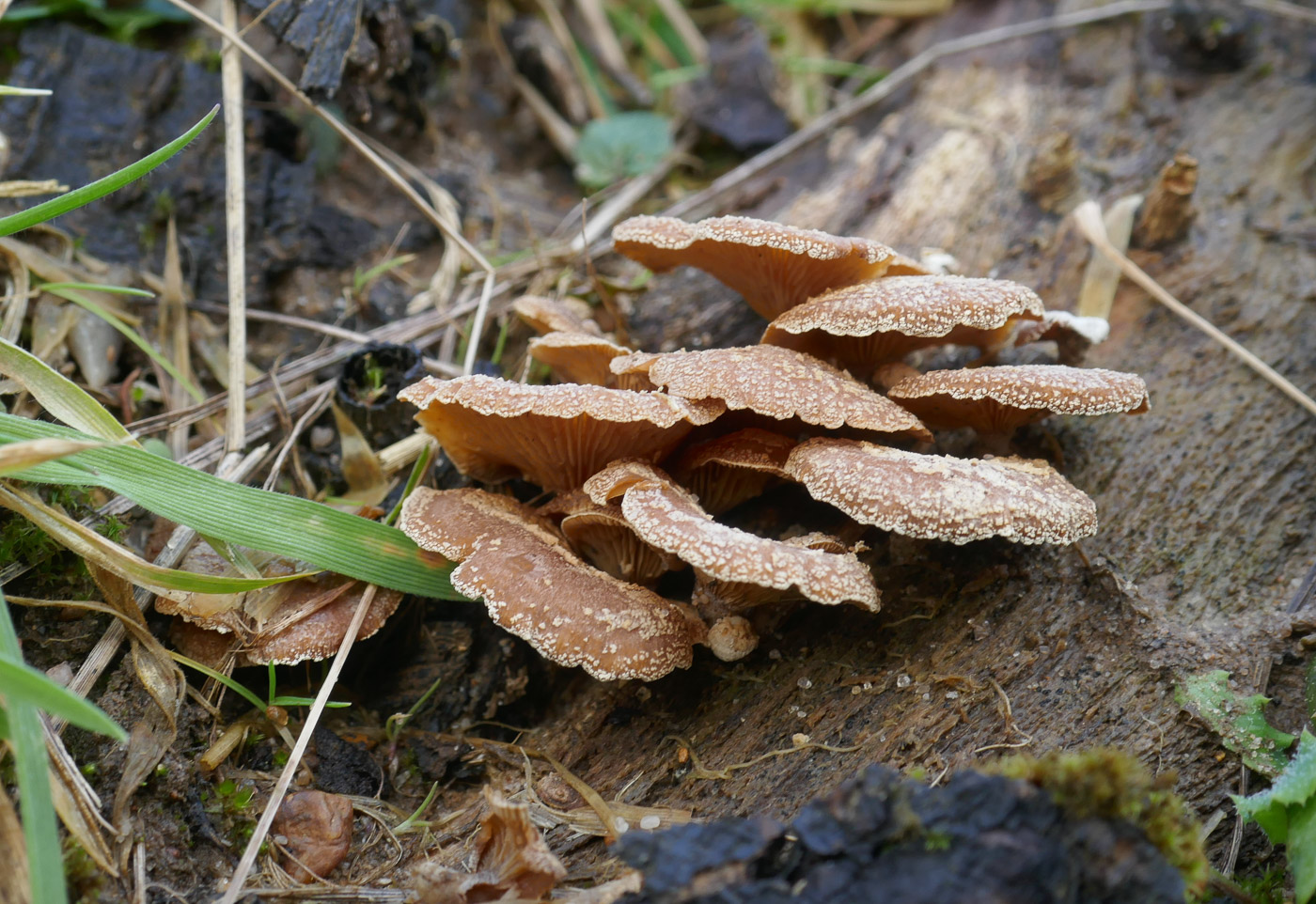
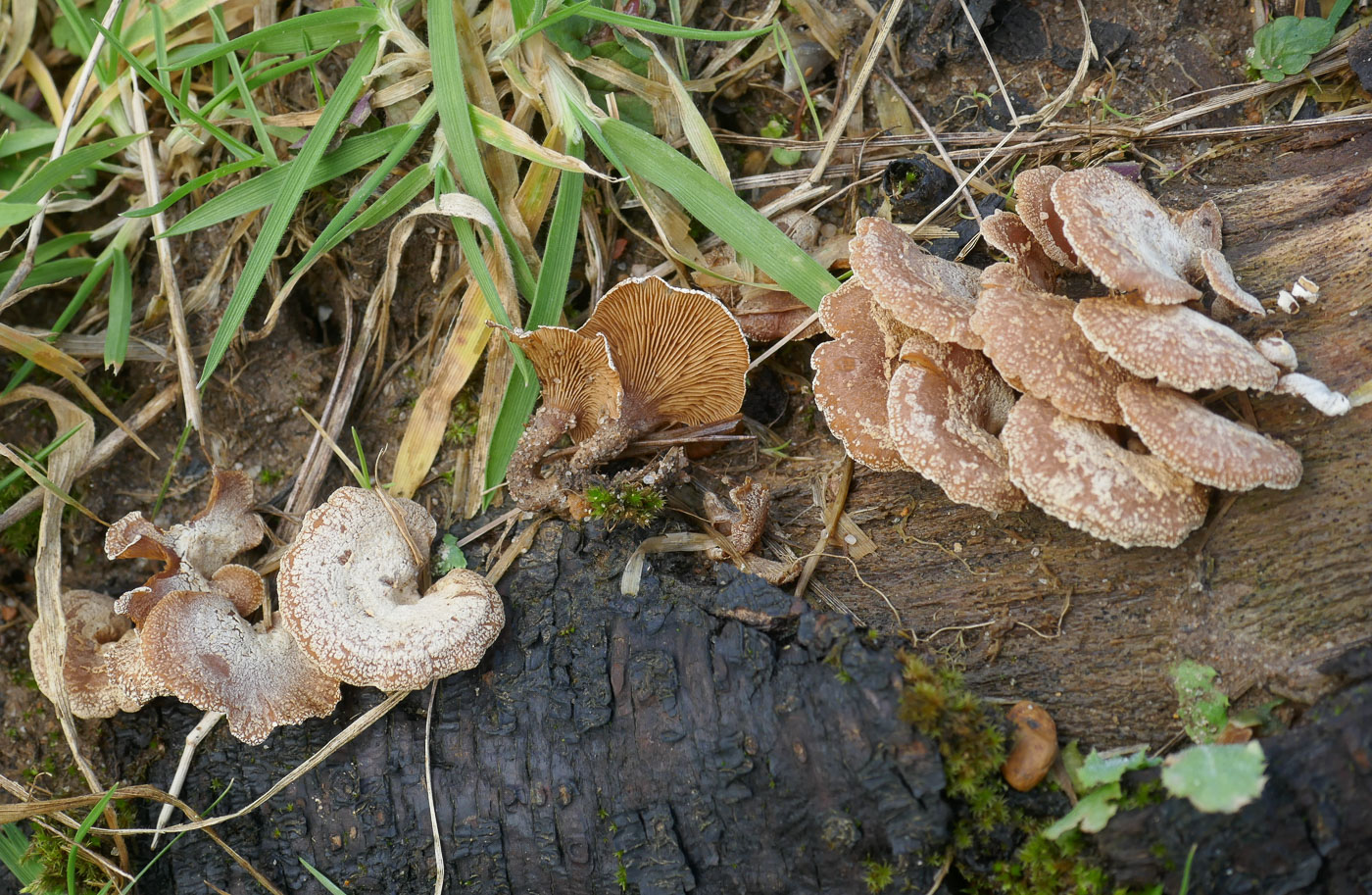 |
January 24th Panellus stipticus (Bitter Oysterling) At Stampwell Farm Jackie Ewan noticed this cluster of stemless mushrooms on a fallen Plum tree. She did the 'sticky gill' test (ie pinching a fruit body with thumb and finger, then putting that thumb and finger together afterwards which reveals a sticky substance left by the gill surface and makes them adhere slightly) and this was enough to confirm the ID. This seems to be a unique feature and useful in the field to eliminate maybe a species of Crepidotus, Pleurotus or even Deconica. It is common on sawn ends of wood piles but also often on dead or dying deciduous wood, though nice to find in January. Previous finds |
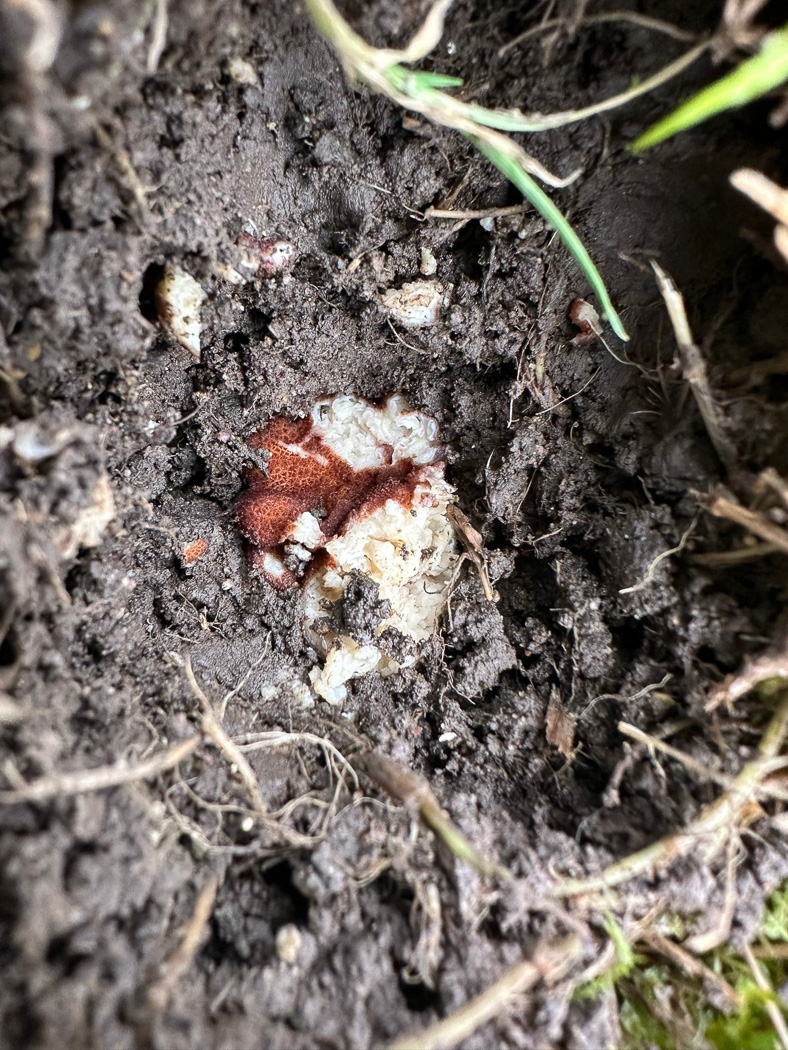
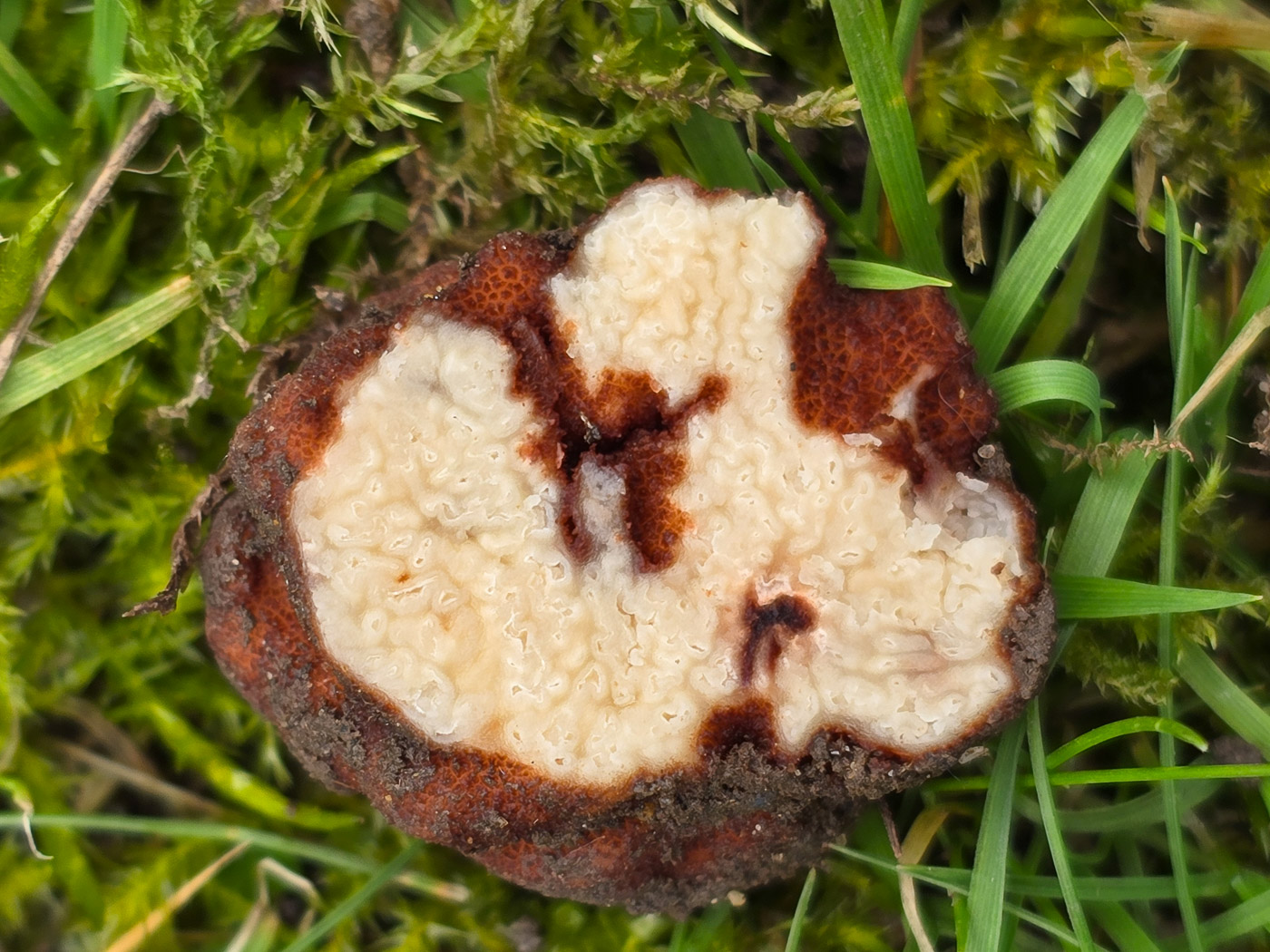 |
January 17th Balsamia vulgaris (a rare ascomycete truffle with no English name) In Gerrards Cross Jesper Launder found this knobbly whopper (his description!) partially showing through the soil surface under a deciduous tree, also partially eaten by a squirrel (detected from its toothmarks!). He was surprised by its size (more than 3 cm across) which was not fully revealed until excavated, and was the largest and also the smelliest he'd encountered (described by him as 'truffly and pleasant'). This is his second find of this species from Gerrards Cross where the number of truffle records - entirely down to him - is growing rapidly, and is the second county record. Previous finds |
January 22nd 2025
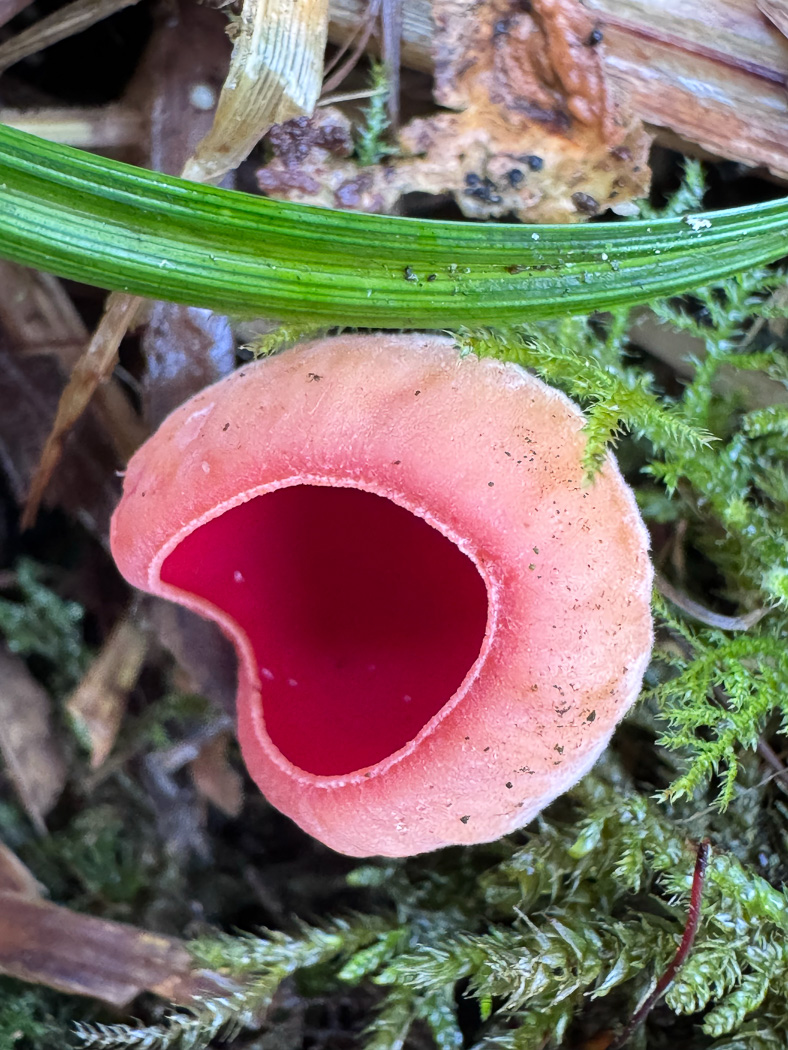
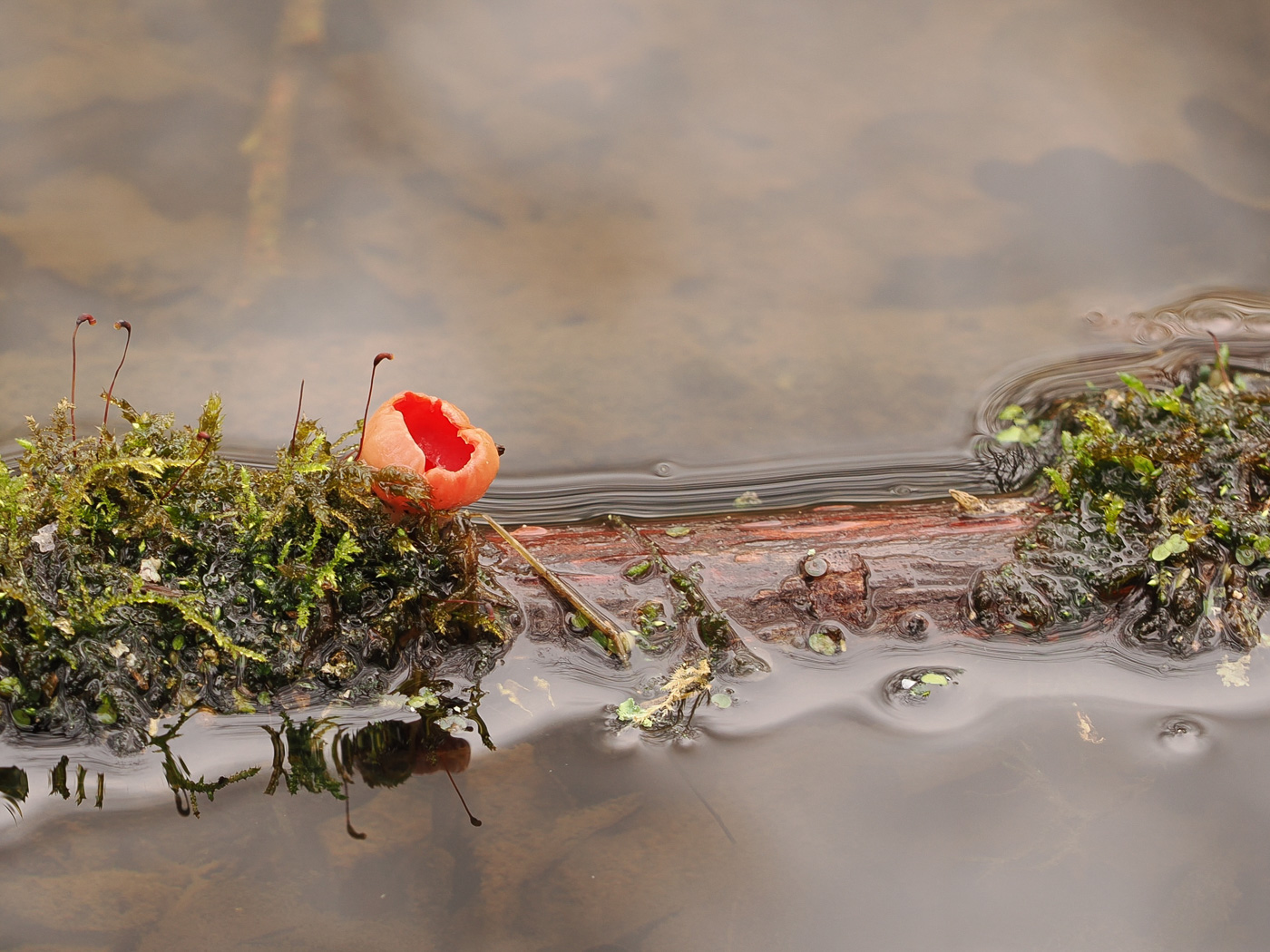 |
January 22nd Sarcoscypha austriaca (Scarlet Elfcup) Whilst walking in Lott Wood near Stokenchurch, Jackie Newcombe noticed this bright red fruit body on a mossy bank and on closer inspection noticed its smooth red interior, pale downy exterior with only a very short stem, the cup being no more than 15mm across. It was growing on woody litter in a suitably damp spot though the wood was indeterminate but the area is mainly Beech and Ash with some Willow present - the likeliest host. She was concerned as to which of the two species of Sarcoscypha this might be, and without a scope it is not possible to be certain but S. coccinea is now considered so much rarer than the common S. austriaca which appears to be more or less replacing it in the UK that one can fairly safely make the assumption that this is the commoner species - one well worth looking out for now in damp areas where fallen wood is in contact with the soil. Photo 2, taken by Claire Williams in Naphill Common on Feb 16th, is unusual because the stick on which it's fruiting is floating in a pond! This was explained, however, by the stick being one of several thrown onto the ice when the pond was frozen! Previous finds |
January 8th 2025
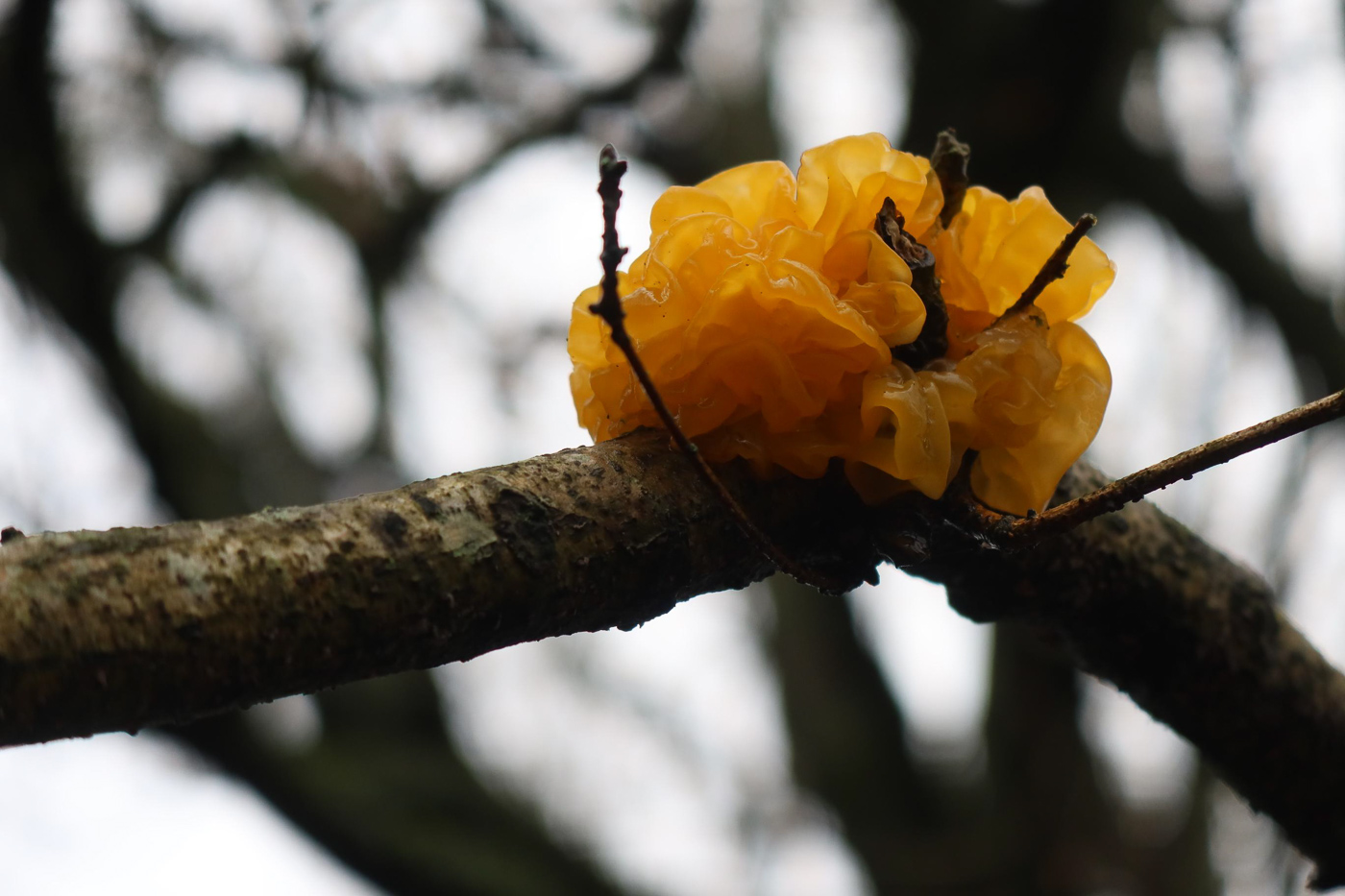 |
January 7th Tremella mesenterica (Yellow Brain) In Downley Wood Claire Williams was pleased to spot this bright jewel on a lower branch of a large Oak. Her description: 'gorgeous golden' fits the bill nicely, especially at this time of the year when woodland tends to be somewhat drab and devoid of colour. This is one of the jelly fungi as touching it will soon confirm. It favours Oak but is also quite common on Gorse and tends to become more orange as it dries out. It parasitises species of the corticioid genus Peniophora though this host is often not visible underneath but no doubt its mycelium is hidden within the wood. Previous finds |
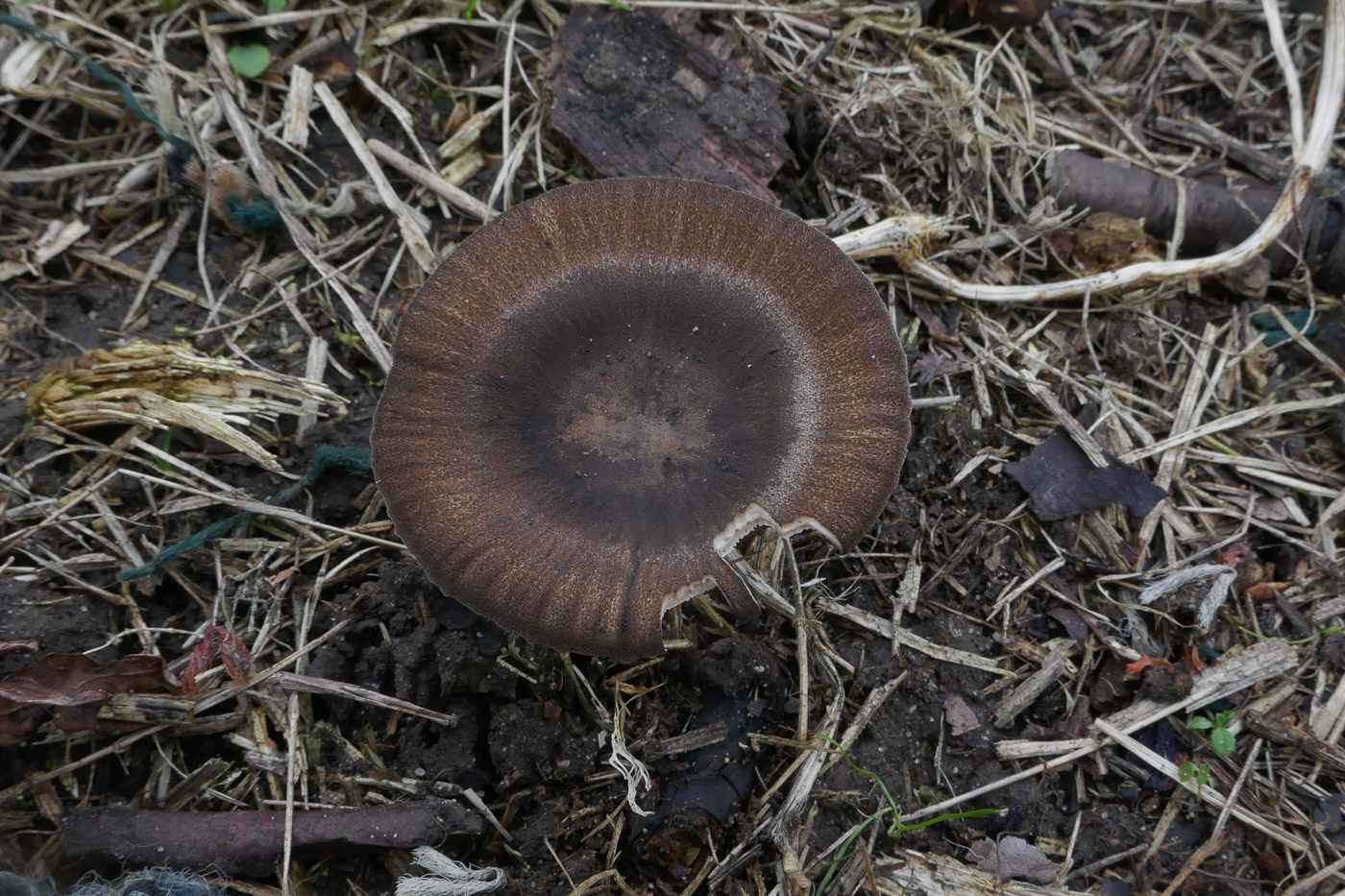
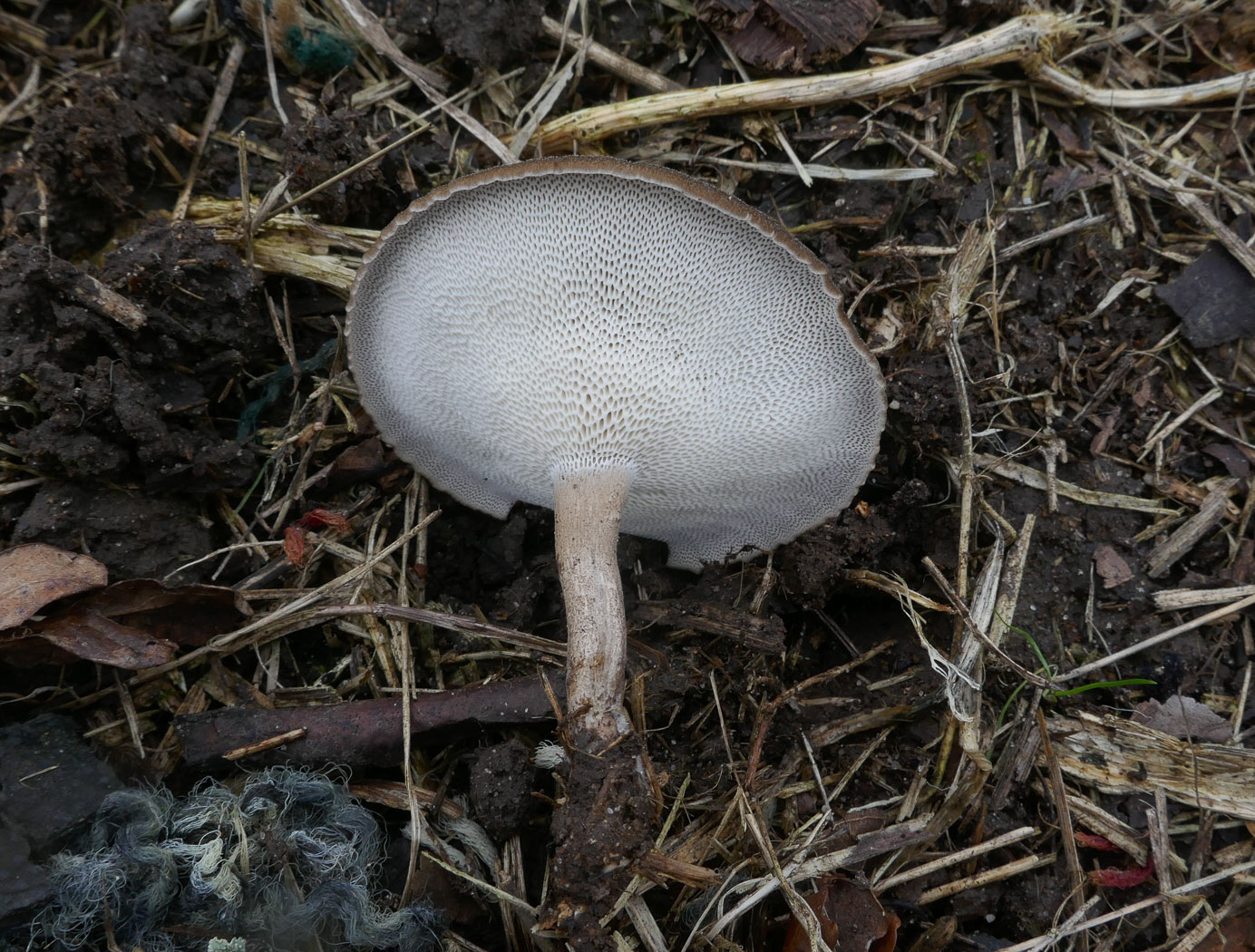
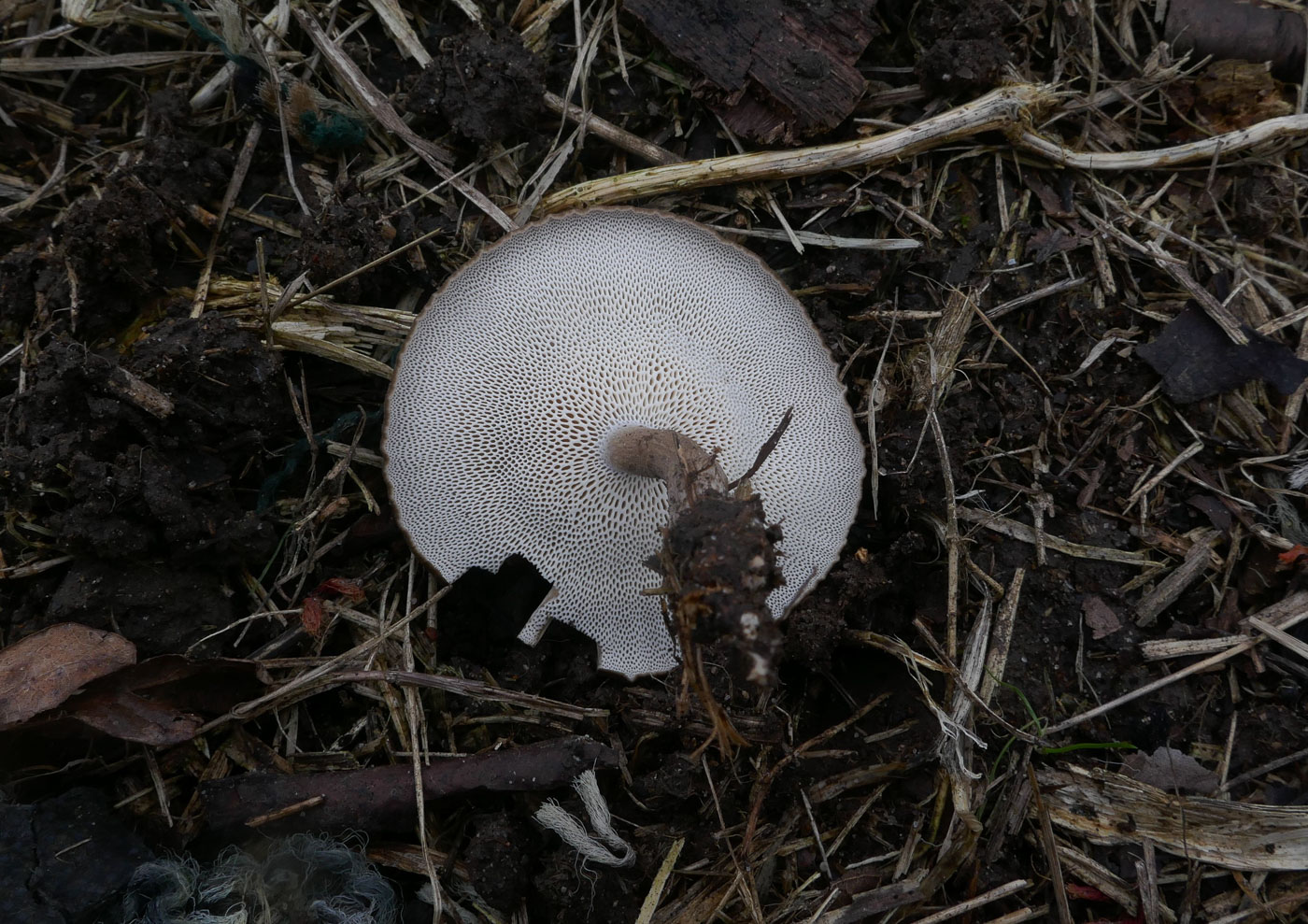 |
December 30th 2024 Lentinus brumalis (Winter Polypore) On woody debris in a plum orchard at Stampwell Farm Jackie Ewan spotted this singleton showing the typical characteristics of the species and at the correct time of year as well. The cap colour, regular shape with slightly fluted edge with distinct but white pores 2-3 per mm which are slightly decurrent all point to this species - previously in genus Polyporus. Previous finds |



 |
July 10th 2023 Hydropus inopinatus (a species NEW TO SCIENCE from Burnham Beeches - no English name) This tiny Mycenoid mushroom was first found in 2021 on a piece of Pine collected from Burnham Beeches by Barry Webb and, following sequencing, described for the first time in the magazine Field Mycology vol 24 (1) earlier this year. Its reappearance has been eagerly awaited in order that sufficient material could be collected for further study and drying, and on July 2nd Barry rediscovered it on the same rotting Pine stump from which his original piece of wood was taken (photo 1). Bingo!! It had also been found in Hampshire back in 2021 and in Kent in 2022, the sequence of both collections matching ours from Burnham Beeches. So a second article has since appeared (in 2024, Field Mycology vol 25 (3)) - the official publication of this species now with a name and full description. The name inopinatus meaning a surprise was thought to be particularly appropriate. All the photos here are Barry's, photo 2 taken on July 5th, photos 1 and 2 are of his original find on a piece of Burnham Beeches Pine on July 31st 2021. See the publication online for further information. Updated find |
January 2nd 2025
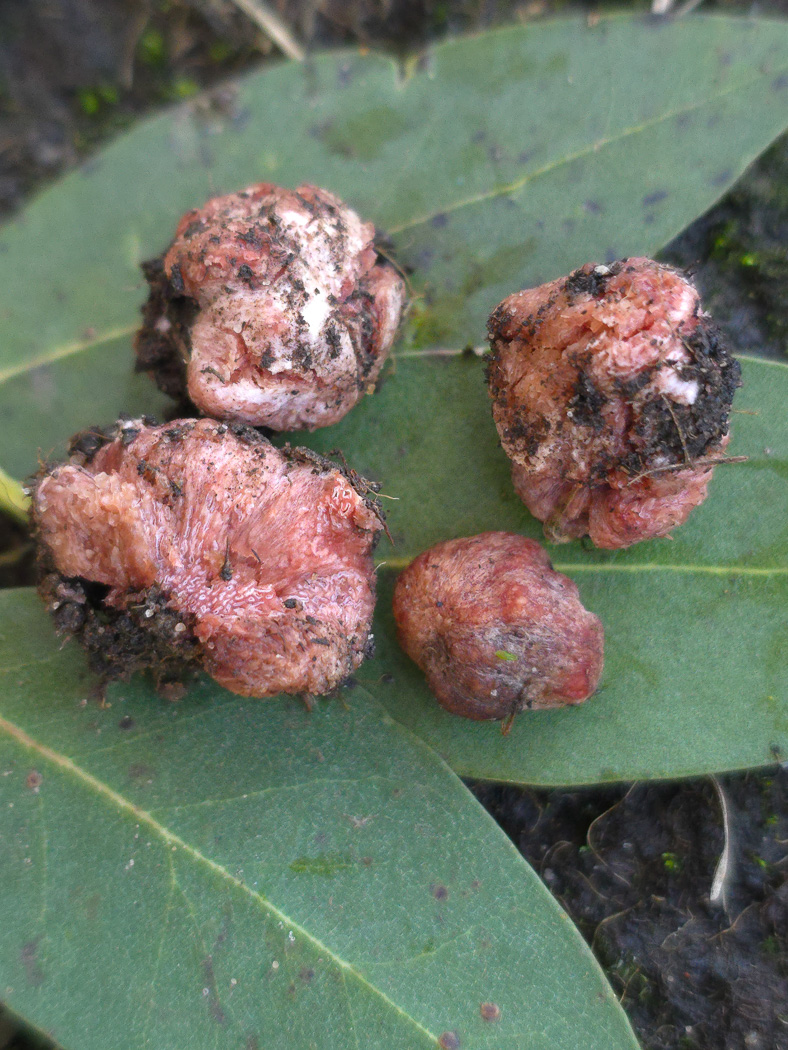 |
January 2nd Hydnangium carneum (Flesh Pink Truffle) In a roadside verge in Gerrards Cross Jesper Launder's attention was drawn to a Eucalyptus tree where he'd previous found interesting fungi, and on then discovering Laccaria fraterna (see entry below) he searched about for signs of truffle activity - ie dig holes, because he knew of a rare species which associates with this tree, one he'd been hoping to find for years. To his amazement and delight he spotted a single pinkish truffle protruding through the soil and on further investigation was rewarded with several more. At home a scope confirmed it was likely to be this species but he feels it is well worth getting a sample sequenced because he knows there are several other Hydnangium species found under this tree in Australia which are not yet known to be British. This is a new to the county with just 27 previous UK records. What an exciting find to start the new year off! New find |
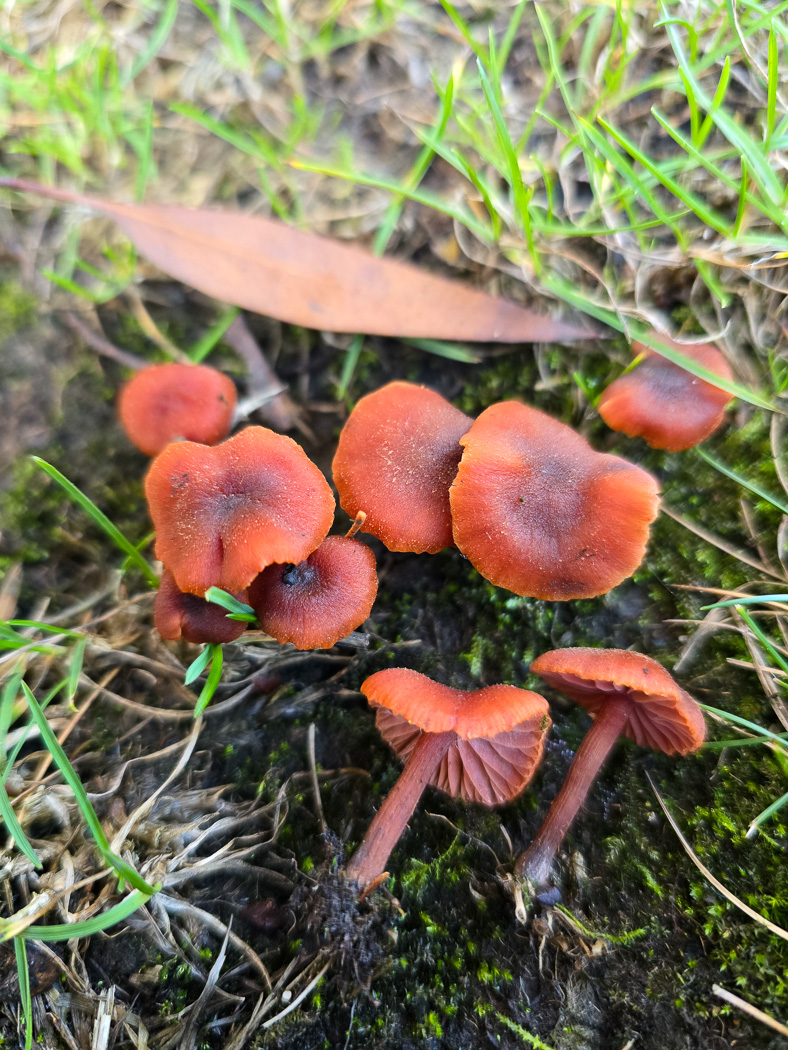 |
January 2nd Laccaria fraterna (Gumtree Deceiver) In a roadside verge in Gerrards Cross Jesper Launder's attention was drawn to a Eucalyptus tree where he'd previous found interesting fungi and today's species in particular. He was not disappointed! Here he found a group of Deceivers displaying the usual features of the genus, ie rusty brown smallish caps and widely spaced pinkish gills. As our common L. laccata can also occur under this tree it was necessary to check this wasn't just that species, and sure enough he found the telltale 2-spored basidia which are only found in this particular unusual Deceiver which is host specific to Eucalyptus. Our only other county record is Jesper's from this spot last year, but if you know of a Eucalyptus near you this is well worth looking out for. Previous finds |
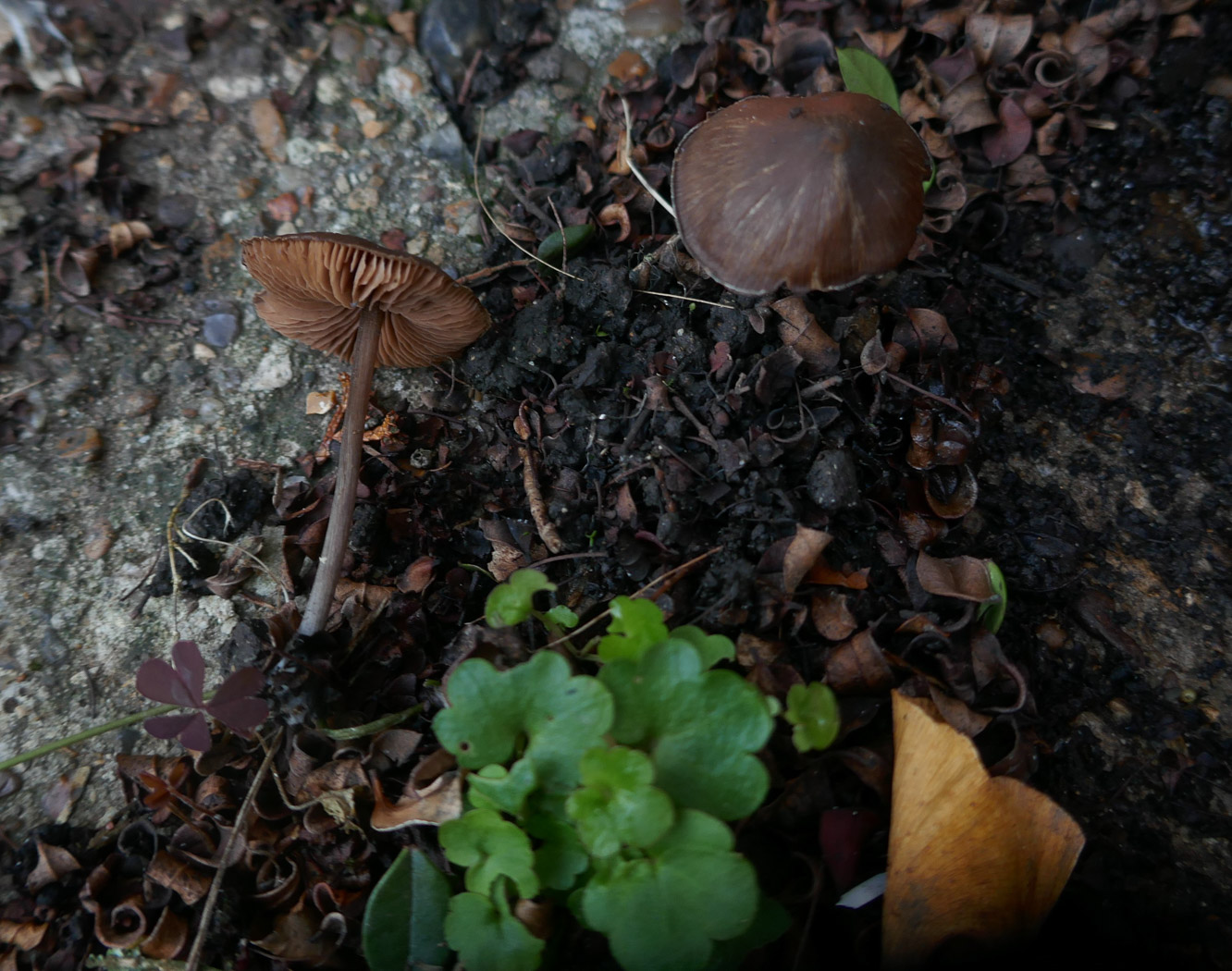
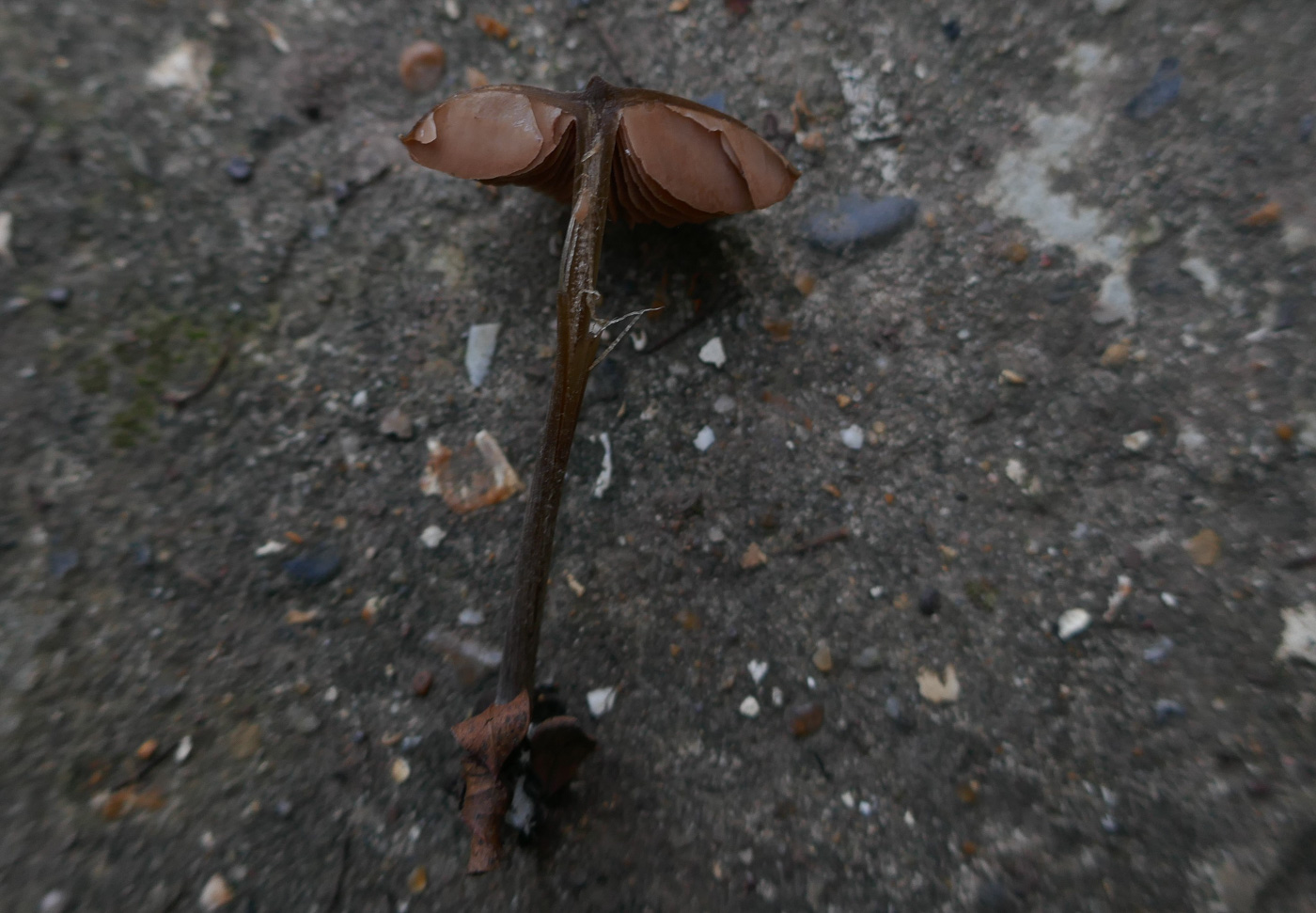 |
January 2nd Entoloma hebes In her garden in Chalfont St. Peter Jackie Ewan noticed a couple of smallish LBJs in a patch of soil. The general 'jizz' and distinctive pinkish brown gill colour pointed to the genus Entoloma and this was soon confirmed by the spore shape under a scope. Characteristic of this particular species is the neat little central papilla which is not unique but does help to eliminate many other contenders in a difficult genus. This combined with the smooth brown cap and microscopic features was enough to confirm Jackie's ID.The species is one of the commoner Pinkgills and we have a fair number of county records. Previous finds |
HOW MEMBERS FINDS STARTED
Members' Finds was launched in 2020 after the onset of Covid 19 to compensate for the cancellation of the group's outdoor activities during lockdown, its purpose being to encourage members to go out looking for fungi and share their photos here. It proved so popular, especially to those new to learning about fungi, that after lockdown we decided to extend and refine the scheme, using it for members' collections made within the county but separate from those recorded on our Walks - already covered in the reports (available on the Reports & Lists page).
Five years on we now have over 1200 species illustrated, many of which have several images and are not included in popular handbooks, making this an extremely useful resource. Over 50 members have now contributed, adding many rarities including species new to the county and to the UK.
Following the success of this project, for the summer of 2025 we have updated the general layout, making browsing easier and information more readily at your fingertips. For the more common species for which we had amassed multiple images we're now including the latest images sent in but selectively reducing the total number of entries to ten, thus still giving a wide range of examples of a species - such a beneficial resource. We hope this will not discourage members from sending in such species; common or rare: all are still welcome!
BASIC INSTRUCTIONS FOR PARTICIPATING
• Only BFG members may contribute; collections must be from Buckinghamshire.
• Please send images as an attachment and not embedded into the email text.
• NB! All photos should be accurately captioned before attaching. Please replace your camera code number with fungus name (a suggestion is fine), site, date, your initials. EG Amanita muscaria Penn Wood 01.10.2025 PC1.
• Aim to show all aspects of the fruitbody, include several photos if available.
• Please include in your email as much detail as possible (eg size, smell, substrate, habitat, microscopic details if available). All clues are vital when identifying solely from photos.
• If possible collect and retain at least one specimen until you've heard back from Penny in case further investigation is required - records of rarities are invalid without voucher material which may well need to be dried for molecular sequencing to confirm.
VIEWING TIPS
• Click on thumbnail to view photos at full size.
• ![]() Only entries marked with this symbol have been microscopically examined.
Only entries marked with this symbol have been microscopically examined.
• ![]() Entries marked with this symbol have been confirmed or identified using DNA sequencing.
Entries marked with this symbol have been confirmed or identified using DNA sequencing.
• In the Latest Finds Entries the date on the left outside the text boxes is the date of entry into Members Finds; the date within each text box before the species name is the date of collection.
• At the bottom of each entry, clicking on Previous finds, New find or Updated find takes you to the appropriate entry in the Masterlist Index.
• The quickest way to search for any species is by clicking on the LATIN MASTERLIST INDEX, which now automatically groups all entries for any one species together for convenient comparison.
ACKNOWLEDGMENTS
Contributors / Photographers: Andrew Dodd; Andrew Padmore; Andy Coulson-Phillips; Ann Pitwell; Audrey McDade; Barry Knight; Barry Webb FRPS; Bob Simpson; Caroline Lawrence; Chris Grimbly; Claudi Soler; Claire Williams; Derek Bourne; Derek Schafer; Eleanor Page; Gill Ferguson; Greg Douglas; Helen Read; Jackie Ewan; Jackie McKeenzie Dodds; Jackie Newcombe; Jesper Launder; Jim Wills; Joanna Dodsworth; John Catterson; Justin Long; Justin Warhurst; Kerry Robinson; Laura Paterson; Leigh McMahon; Lesley Catterson; Linda Seward; Lisa Dodd; Lisa Rock; Mario Tortelli; Mark Harper; Matt Vaughan; Mick Jones; Neil Fletcher; Noel Murray; Paul Allan; Paul Cullington; Paul Goby; Penny Cullington; Peter Davis; Phil Townsend; Piermario Maculan; Richard Donnelly; Richard Wright; Rob Corran; Russell Ness; Sarah Ebdon; Stephen Plummer; Stuart Blackhirst; Toni Standing; Tony Marshall; Tony Knight; Trish Glenn; Wendy Nicholson
DISCLAIMER
There is no guarantee on the reliability of identifications made, particularly on those entries lacking the microscope symbol ![]() . All photos are checked and selected by Penny to the best of her mycological ability. Basic accompanying notes are also Penny's.
. All photos are checked and selected by Penny to the best of her mycological ability. Basic accompanying notes are also Penny's.



